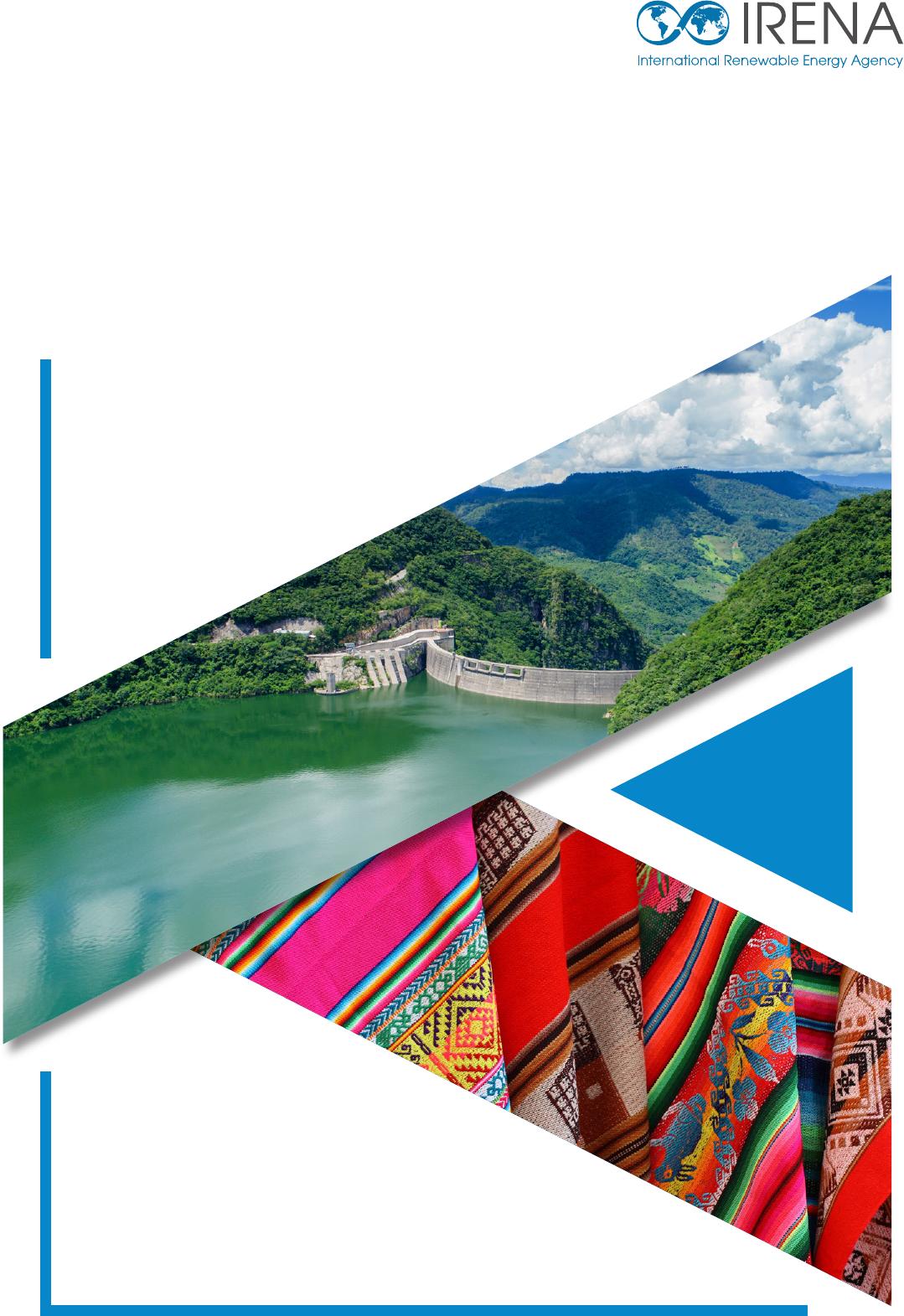RENEWABLESREADINESSASSESSMENTHONDURASNovember2023©IRENA2023Unlessotherwisestated,materialinthispublicationmaybefreelyused,shared,copied,reproduced,printedand/orstored,providedthatappropriateacknowledgementisgivenofIRENAasthesourceandcopyrightholder.Materialinthispublicationthatisattributedtothirdpartiesmaybesubjecttoseparatetermsofuseandrestrictions,andappropriatepermissionsfromthesethirdpartiesmayneedtobesecuredbeforeanyuseofsuchmaterial.Citation:IRENA(2023),RenewablesReadinessAssessment:Honduras,InternationalRenewableEnergyAgency,AbuDhabi.ISBN:978-92-9260-554-4ABOUTIRENATheInternationalRenewableEnergyAgency(IRENA)isanintergovernmentalorganisationthatsupportscountriesintheirtransitiontoasustainableenergyfutureandservesastheprincipalplatformforinternationalco-operation,acentreofexcellence,andarepositoryofpolicy,technology,resourceandfinancialknowledgeonrenewableenergy.IRENApromotesthewidespreadadoptionandsustainableuseofallformsofrenewableenergy,includingbioenergy,geothermal,hydropower,ocean,solarandwindenergy,inthepursuitofsustainabledevelopment,energyaccess,energysecurityandlow-carboneconomicgrowthandprosperity.www.irena.orgAcknowledgementsThisreportwaspreparedbyIRENAinclosecollaborationwiththeGovernmentoftheRepublicofHonduras,throughtheEnergySecretariat(SEN).Specialthanksarealsoduetonumerousofficials,especiallythosefromElectricEnergyRegulatoryCommission(CREE),NaturalResourcesandEnvironmentSecretariat(SERNA),HondurasElectricEnergyNationalCompany(ENEE),NationalDispatchCenter(CND)aswellasstakeholdersfromthenationalenergysectoraswellasotherstakeholdersfromthenationalenergysector.ThisreportwasdevelopedundertheguidanceofGurbuzGonul(Director,CountryEngagementandPartnerships,IRENA)andBinuParthan.ThedocumentwasauthoredbyJoséTorón,CamiloRamírez(IRENA),FernandoAnayaandEmilianoPaz(IRENAconsultants).ValuableinputandcommentswereofferedbyIRENAexperts,ImenGherboudj,MohammedNababa,CeliaGarcía-Baños,KrislyGuerra,MariaVicenteGarcia,andGerardoEscamilla:additionalinsightswereprovidedbyMarcoYujato(OLADE).PublicationandeditorialsupportwereprovidedbyFrancisField,StephanieClarkeandManuelaStefanides.Thereportwascopy-editedbyLisaMastny,thegraphicdesignwasdonebyPhoenixDesignAid.Forfurtherinformationortoprovidefeedback:publications@irena.orgThisreportisavailablefordownload:www.irena.org/publicationsDisclaimerThispublicationandthematerialhereinareprovided“asis”.AllreasonableprecautionshavebeentakenbyIRENAtoverifythereliabilityofthematerialinthispublication.However,neitherIRENAnoranyofitsofficials,agents,dataorotherthird-partycontentprovidersprovidesawarrantyofanykind,eitherexpressedorimplied,andtheyacceptnoresponsibilityorliabilityforanyconsequenceofuseofthepublicationormaterialherein.TheinformationcontainedhereindoesnotnecessarilyrepresenttheviewsofallMembersofIRENA.ThementionofspecificcompaniesorcertainprojectsorproductsdoesnotimplythattheyareendorsedorrecommendedbyIRENAinpreferencetoothersofasimilarnaturethatarenotmentioned.ThedesignationsemployedandthepresentationofmaterialhereindonotimplytheexpressionofanyopiniononthepartofIRENAconcerningthelegalstatusofanyregion,country,territory,cityorareaorofitsauthorities,orconcerningthedelimitationoffrontiersorboundaries.RenewablesReadinessAssessmentHONDURASRenewablesReadinessAssessment:HondurasForewordfromtheSecretaryofStateintheEnergyOfficeHonduras’geographicallocationprovidesanidealsettingforproducingelectricitythroughrenewableenergysources,suchashydro,solar,wind,biomassandgeothermal.TotalinstalledcapacityinHondurasisapproximately3159MW,distributedover107powerplants.Fossilfuel-basedgeneratorsprovidesome1104MW(34.94%)oftotalcapacity,while2055MW(65.06%)comesfromrenewablesources.Whilethecountryhasahighshareofelectricityproducedfromrenewables,weaimtoachievea70%shareinelectricitygenerationfromrenewablesourcesby2026,inlinewiththeGovernmentPlantoRefoundHonduras.HondurasisasignatorytotheParisAgreementandtheUnitedNationsFrameworkConventiononClimateChangethataimtoreducethegreenhousegasemissionsthatareresponsibleforglobalwarmingandclimatechange,andareprimarilyproducedbyfossilfuelcombustion.Hondurashascommittedtoreduceitsgreenhousegasemissionsby16%by2030and-asa100%fuelimporter-toreducethedrainonitsforeigncurrencycausedbyitsoilbill.TheenergysectorinHondurasiscurrentlyundertakingstrategicstepstowardscomprehensive,inclusive,democraticandsustainabledevelopment.TheseincludetheapprovalofLegislativeDecreeNo46of2022ontheSpecialLawtoGuaranteetheElectricEnergyServiceasaPublicGoodofNationalSecurityandaHumanRightofEconomicandSocialNature,whichempowerstheexecutiveauthoritiesandtheBoardofDirectorsoftheNationalElectricEnergyCompanytoformulateandexecuteanactionplantorescuethestate-ownedcompany,promotingaverticallyintegratedbusinessmodel.Thecountryalsofaceschallengesduetoitsvulnerableanddeterioratingelectricalsystem,whichhasnotreceivedanysignificantinvestmentingeneration,transmissionordistributioninthepastdecade.Giventheimportantcontributionofrenewableenergysourcesinthecountry,Hondurasrequiresarobustandflexibleelectricitysystem.Forthisreason,asfarasistechnicallypossible,transmissionlineshavebeenbuilt,substationshavebeenrepoweredandotherswillbedevelopedtoallowtheinjectionofthistypeoftechnologyintotheNationalInterconnectedSystem.Ithasalsobeennotedthattheincorporationofalargeramountofvariablerenewableenergy,includingsolarandwind,shouldconsiderthestabilityofthesysteminordertoavoidfrequencyproblems,voltagedrops,aswellasalackoffirmcapacityandreactiveinjection.Therefore,futureprojectdevelopmentswillconsiderstoragesystemsandensureasufficientlevelofreserves.Hondurasisalsoconsideringgeothermalpowertechnology,whichoffersfirmpowerwithplantfactorsabove98%;albeititsgeothermalpotentialisrelativelylowcomparedtoothercountriesintheregionat200MWowingtothelackofvolcanicactivity.Wearealsoconsideringhydroelectricplantswithreservoirsandpumpingsystems,aswellasusingthevarioustypesofbiomassavailableinthecountryforelectricitygeneration.WeexpressourspecialthankstoIRENAandalltheactorswhohaveactivelyparticipatedintheelaborationofthisRenewablesReadinessAssessment,whichwillundoubtedlyserveasareferencetoachievethedeploymentofrenewableenergyinHonduras.WereaffirmthecommitmentsoftheEnergySecretariat-thegoverningbodyofthecountry’senergysectorresponsibleforcreatingpoliciesfortheadequateexploitationofnaturalresourcesandthegenerationofrenewableenergyinharmonywiththeenvironment.Wealsoseektopromoteajustandeffectivetransitiontowardssustainablecleanenergymanagement.ErickTejadaCarbajal,PhDSecretaryofStateintheEnergyOffice4ForewordfromtheIRENADirector-GeneralTheRepublicofHonduras,likeothercountriesintheCentralAmericanandLatinAmericanregions,facesavarietyofchallengesindeliveringinclusive,fairandsustainabledevelopment.Inovercomingthesechallenges,itiscriticaltofocusonfar-reachingmeasuresthatcanenhancetheresilienceanddiversificationoftheeconomy,ensuretheviabilityoftheenergysector,attractinvestmentincleanenergyprojectsandmeetthecountry’sclimatechangemitigationtargets.Hondurashasshownitscommitmenttodeployingmorerenewableenergy,withambitiousplansfortransformingtheenergysector.Theseincludeeffortstodeveloplong-termpoliciesthatensureasustainable,resilient,low-carbonenergysupplythatwillaccountfor80%ofelectricitygenerationby2038.ThisRenewablesReadinessAssessment(RRA),developedinco-operationwiththeEnergySecretariat(SEN),identifiesthekeyactionsrequiredtoexpandrenewableenergydevelopment.Itoutlinesaseriesofrecommendationsforstrengtheningenergyinstitutionsandgovernance;enhancingenergypolicyandregulatoryframeworksfortherenewableenergysector;promotingsustainabledevelopmentandenergyefficiency;strengtheningtheelectricityindustry;increasinginvestmentsinrenewableenergytechnologiesandinfrastructure;andstrengtheninginstitutionalandhumancapacities.IRENAisgratefultoSENandthecountry’sotherenergyinstitutionsfortheirvitalinputsandengagement,aswellastonumerousothergovernmentagenciesandnationalstakeholdersfortheirvaluablecontributions.Welookforwardtoworkingwiththemall,aswellaswithregionalinstitutionsanddevelopmentpartners,toturntheserecommendationsintopracticalinitiativesthatpromoterenewablesasakeyelementinsustainable,equitablesocio-economicdevelopment.FrancescoLaCameraDirector-GeneralInternationalRenewableEnergyAgency5ContentsFigures,TablesandBoxes7Abbreviations8Executivesummary101Introduction141.1TheRenewablesReadinessAssessmentprocessinHonduras141.2Countryprofile142Energycontext172.1Generalstrategicframework172.2Overviewoftheenergysector182.3Energyrates322.4Legalandregulatoryframework333Renewableenergydevelopment353.1Keydrivers353.2Recentinvestmentsinrenewableenergyinfrastructure353.3Renewablesintheenergymix363.4Renewableenergypotential373.5Renewableenergyeconomics443.6Opportunitiesforrenewableenergydevelopment513.7Professionalandinstitutionalcapabilities514Challengesandrecommendations534.1Theroleofenergysectorinstitutionsandgovernance535References76FiguresTablesFigure1PopulationofHonduras,15Table1Frameworkofgovernment171993-2022Table2priorityactivitiesTable3Figure2Annualgrowthingross16Table4(energy-related)Table5domesticproduct,2000-2022Table6Keyindicatorsrelatedtoenergy,20Table7transportandtheenvironmentFigure3Finalenergyconsumption,202119Table8Figure4Finalenergyconsumptionby19Table9Totalenergysupplyin22sectorandsource,2010andTable10Honduras,2010-2022Table112022Installedpowercapacityfor25Figure5Energy-relatedCO2-equivalent21commercialexchange,2022emissions,bysource,2010-2021EnergysubsidiesinHonduras,28Figure6Institutionalstructureofthe232017EnergySecretariat(SEN)Samplenon-hydropower31Figure7Electricityproductionand26renewableenergyprojectsdomesticsupply,2011-2022Electricityratesbyclient,202132Figure8Structureoftheelectricity27Driversofrenewableenergy35sub-sectordevelopmentandexpectedFigure9Electricityconsumptionby27outcomesend-usesector,2011-2022Investmentsinrenewable45Figure10Transmissioninfrastructure29energyprojectsinHonduras,20232010-2020Figure11�Biomassforenergyuse30Renewablepowercapacity46evaluation,2022-2031Figure12Electricitytrade,2011-202232Multilateralfundsfinancing48Figure13Hydropowerpotential37renewableenergyandclimateactioninHondurasFigure14Solarpowerpotential38Figure15Windpowerpotential40Figure16Geothermalpowerpotential41BoxesFigure17Biofuelspowerpotential42Figure18Renewableenergyfinancing47institutionsFigure19Women’sparticipation(share)68Box1IRENA’sSolarCitySimulator39inselectedenergysectors,2021Box2Box3CentralAmerica’sRenewable66EnergyRoadmap:AdvancingaregionalshiftinenergySocio-economicsofrenewable68energy7RenewablesReadinessAssessment:HondurasAbbreviationsAECIDSpanishAgencyforInternationalDevelopmentCo-operationCABEICentralAmericanBankforEconomicIntegrationCAFDevelopmentBankofLatinAmericaandtheCaribbeanCIFClimateInvestmentFundsCNDNationalDispatchCenterCO2carbondioxideCREEElectricEnergyRegulatoryCommissionDESDecarbonisingEnergyScenarioECLACEconomicCommissionforLatinAmericaandtheCaribbeanENEENationalElectricEnergyCompanyGCFGreenClimateFundGDPgrossdomesticproductGIZGermanAgencyforInternationalCo-operationGWhgigawatthourHNLHonduranlempiraIDBInter-AmericanDevelopmentBankIFCInternationalFinanceCorporationIRENAInternationalRenewableEnergyAgencyJICAJapanInternationalCooperationAgencyktkilotonnekVkilovoltkWhkilowatthourLPGliquefiedpetroleumgasMERRegionalElectricityMarketMWmegawatt8ABBREVIATIONSMWhmegawatthourNDCNationallyDeterminedContributionODSSystemOperatorOLADELatinAmericanEnergyOrganizationPESPlannedEnergyScenarioPJpetajoulePPApowerpurchaseagreementPVphotovoltaicREmapRenewableEnergyRoadmapRRARenewablesReadinessAssessmentSDGSustainableDevelopmentGoalSENEnergySecretariatSICACentralAmericanIntegrationSystemSieHondurasHondurasEnergyInformationSystemSIEPACElectricityInterconnectionSystemfortheCountriesofCentralAmericaSINNationalInterconnectedSystemSTEMscience,technology,engineeringandmathematicsTJterajouleUNDPUnitedNationsDevelopmentProgrammeUNEPUnitedNationsEnvironmentProgrammeUNFCCCUnitedNationsFrameworkConventiononClimateChangeUNIDOUnitedNationsIndustrialDevelopmentOrganizationUSDUnitedStatesdollar9RenewablesReadinessAssessment:HondurasExecutivesummaryHondurashasoutlinedanationalstrategicframeworkinitsCountryVision2010-2038,whichaimstofosterinclusiveeconomicgrowththroughafocusonenhancinglabourcapabilities,bolsteringinfrastructure,improvingaccesstofinanceandstrengtheningresiliencetoclimatechange.TheenergysectoriswellintegratedintotheCountryVisionframeworkthroughtheEnergyRoadmap2050andtheNationalPlan2010-2022.Thesedocumentsincludetargetssuchastheachievementofan80%shareofrenewableenergyinthecountry’stotalelectricitygenerationby2038,upfromthecurrent60%.Inaccordancewiththe2015ParisAgreementonclimatechange,theGovernmentofHondurashasestablishedsector-specificcommitmentstowardsreducinggreenhousegasemissionsintheenergy,forestry,agriculture,wasteandindustrialprocessingsectors.Thecountry’sinitialNationallyDeterminedContribution(NDC),submittedtotheUnitedNationsFrameworkConventiononClimateChange,outlinedacommitmenttoreducecarbonemissions16%below2000levelsby2030.NationalambitionsforsustainabledevelopmentinHondurasfaceimportantinfrastructureconstraints.Significantinvestmentisneededtoenhancethequalityofenergyandwaterservices,includingimprovementsincoverageandconnectivity.Bytheendof2020,closeto90%ofthepopulationhadaccesstoelectricity,butlessthanhalfofHonduranswereusingmodernenergysourcesforcookingpurposes.Limitedconnectivityandservicelevelsaffectaccesstoproductionareas,internalandexternalmarkets,tourismareas,andhealthandeducationservices,resultingininequitabledevelopmentandlownationalandregionalintegration.Thecountryhashighexposuretohurricanesandtropicalstorms.In2020,theEconomicCommissionforLatinAmericaandtheCaribbeanestimatedthathurricanesEtaandIotaresultedineconomiclossesofUSD2billion,affectingkeyeconomicsectorssuchascropsandlivestock,whichserveascriticalsourcesofsustenanceandfoodsecurityforalreadymarginalisedhouseholds.In2019,droughts,heavyrainsandfloodingaffectedagriculturalbusinessesandimpactedlivestockproduction.Climatechangeforecastsfor2030pointtosignificantrisksforHonduras,includingapotential9%decreaseingrossdomesticproduct,higherlivingcosts,reducedfoodsecurityanddamagetocriticalinfrastructure.Honduraswasamongthecountriesmostseverelyimpactedbyextremeweathereventsduringtheperiod1998-2017,anditregularlyexperiencesabroadrangeofclimate-relatedimpacts,whichhaveadverseimplicationsforvarioussectors.Hydropowerproductionfaceschallengesduetochangingclimaticpatterns,andtheagriculturalandfishingsectorsexperiencedsignificanteffectsonproductivityandyields;thesetwosectors,togetherwiththeforestrysector,employ35%oftheeconomicallyactivepopulationandrepresent36%oftotalexports.TheRenewablesReadinessAssessment(RRA)processforHondurasincludedthedevelopmentofabackgroundpaperandaconsultativeprocessledbytheEnergySecretariat(SEN),facilitatedbytheInternationalRenewableEnergyAgency(IRENA).Thisprocessgeneratedasetofactions,wherethemainchallengesforanaccelerateduptakeofrenewableenergyhavebeenidentified.10ExecutivesummaryChallengesandkeyrecommendationsTheroleofenergysectorinstitutionsandgovernanceTheEnergySecretariat(SEN)facesdifficultiesinpromotingpolicycoherenceacrosspublicinstitutions,systematisingdialogueswithlocalcommunitiesandcreatinglocalcapacitiestoempowerunder-servedcommunitiesindevelopingrenewableenergyprojects.TheElectricEnergyRegulatoryCommission(CREE),inadditiontooverseeingthemainactivitiesofthesector,isresponsibleforestablishingregulationsandensuringcompliance.Othersecretariatsorministriesareinchargeofadditionalactivitieswithintheenergysector(hydrocarbons,biofuels,geothermalenergy,firewood,water)andareworkingwithlimitedregulatorycapacitiesandbudgets.TheNationalDispatchCenter(CND)operatestheelectricitysystemandmarket,andisresponsiblefortheoperationandmanagementofelectricitydispatch.BecausetheCNDismandatedtoprovidereliableelectricityatthelowestcost,ithasareducedauthoritytopursuethedecarbonisationandresilienceoftheelectricitysystem;thislimitstheCND’sabilitytopromotetrustandtransparencyintheactionstaken.Theseandotherinstitutionsfacedifficultiesco-ordinatingtheirpoliciesinareaswheremandatesaresharedacrosssecretariatsandagencies,whichisaparticularlysalientbarrierfordevelopingenvironmental,climateandenergypolicy.Publicandprivaterenewableenergyprojectsthatrelyonlocalnaturalresourcesandlandareasfacecomplicateddialogueswithlocalcommunitiesaroundenergyexpansionplansandagricultureindustrydevelopment,amongotherissues.Inthiscontext,itisimportanttomoreclearlydefinetheresponsibilitiesandregulatoryfunctionsofexistingentitieslinkedtotheenergysector.Someofthechallengesfacedbynationalinstitutionsincludeindependentdecisionmaking,enhancedgovernance,capacitybuildingandexpandedabilitiesforpolicyimplementation.Achievingawell-definedregulatorylandscapethroughthecreationofacomprehensibleandactionableframeworkwouldattractrelevantstakeholdersthatcanhelptransformthemarketandidentifyopportunitiesforfurtherdevelopmentofthenationalenergysector.EnergypolicyandregulatoryframeworkfortherenewableenergysectorNationalambitionsandintentionstoacceleraterenewableenergyuseareontherighttrack.Nevertheless,thereisaneedtobetteralignpolicyambitionswiththelikelyoutcomesofexistingenergyprogrammes.Thecountry’senergypolicyisimpactedbytheEnergyRoadmap2050,andadisconnectexistsbetweenitsgoalsandthebudgetsassociatedwiththeincorporationofrenewables.Furthermore,theobjectivesandactionsoutlinedintheNDCaredetachedfromthenecessaryfundingandhumanresources,aswellasfromtheinstitutionsresponsibleforachievingclimatechangetargets.Lawscreatedtofacilitatethepromotionoflow-carbontechnologiesandrenewableenergyremainunder-enforcedduetoalackofregulationsandimplementationmechanisms.Addressingthecurrentconditionsofpowerpurchaseagreements(PPAs)isparamounttobringcertaintytothedevelopmentofinfrastructureintheshortterm.Itisimportanttoidentifytheappropriatemechanismfortheimplementationofnationalpublicpolicythattargetsclimategoalsandincludesanenergytransitionbasedonrenewabletechnologies.Comprehensive,long-termenergyplanningthatisbothresilienttopoliticalshiftsandinclusiveoflocalcommunities’validationwillbringcertaintytopotentialinvestors.11RenewablesReadinessAssessment:HondurasSustainabledevelopmentandenergyefficiencyThegovernmenthasprioritisedseveralurgentactionsinitsdevelopmentagenda,includingpovertyalleviation,education,healthcare,genderequality,andmorerobustinfrastructuresforwater,electricity,sanitationandroads.ModerateexecutionofprogrammesandlimitedaccesstofinancinghavepreventednationalinstitutionsfromkeepingpacewiththeUnitedNations’Agenda2030andits17SustainableDevelopmentGoals(SDGs).Manychallengesremaininassessinginvestmentsandmaintainingtheenvisionedfundingthathasadirectimpactonprogrammesandbudgets.Governmentinstitutionscancreateafavourableenvironmentforidentifyingsolutionstoaccomplishthetargetsofboththecountry’sNDCandtheSDGs.Theinclusionofrenewable-basedsolutionsintheprocesscanfacilitatethevisualisationofpathwaystodevelopingcriticalenergyinfrastructure.Otherchallengestoachievingnationalclimategoalsincludeaddressingoildependency,energyaccess,deforestationandtherestorationofdegradedecosystems.PeopleinruralareasfacelimitationsonenergyaccessandotherbasicneedsinterlinkedwiththeSDGs,andappropriateregulationstopreventforestdegradationandfundingforreforestationarelacking.Distributedgenerationusingvariablerenewableenergycouldhelpincreaseenergyaccessandreducefossilfueluseinisolatedcommunities.ActionstakentomeetNDCtargetsshouldincludeanalysingpathwaystoenergy-relatedgoals,suchasdefiningenergystandardsandmodernisingcarbon-basedandinefficienttechnologiesusedinindustry,privateandpublicbuildings,andhouseholds.Therecentlypresentedbilltopromoterationalandefficientuseofenergywillfacilitatethegovernment’seffortstoestablishregulationsfortheuseofmoreefficientenergy-consumingproducts.StrengtheningtheelectricityindustryOriginatingfromalawapprovedin2007,anewtariffschemeintegratedintoPPAscontractedwiththeNationalElectricEnergyCompany(ENEE),thestateelectricityprovider,leftthecompanyindeepfinancialtrouble.Recoveringthecostofservicesisatthecoreoftheenergysector’schallenges,andinadequatecost-recoverymechanismsareakeydriverofENEE’sfinancialunder-performance.Further,energypoliciesthatlackthoroughassessmentsoftheireconomicimplicationshaveworsenedthecompany’sfinancialsituation.ExistingdebtandexpensivePPAsarethemaindriverslimitingENEE’sabilitytofinancenewinvestmentsingeneration,transmissionanddistributioninfrastructure.Specifically,insufficientinvestmentintransmissionanddistributionnetworksconstrainstheabilitytodeveloprenewableenergyprospects;italsoaffectselectricitylosses,qualityofserviceandthefulfilmentofinvestmentcommitmentsintheCentralAmericanElectricalInterconnectionSystem(SIEPAC).SignificantprogresstoaddresstheseissuescouldbeachievedbyseparatingandreducingtheoperationalcostsofENEE,whichwouldbeamongthefirststepstowardsgeneratingreturnsthatwouldallowthecompanytoimproveitsservice.Restructuringthecompany’soutstandingdebtwouldalsoprovidereliefforfutureendeavours.12ExecutivesummaryInvestmentinrenewableenergytechnologiesandinfrastructureAstheproductioncostsofrenewableenergytechnologiescontinuetofall,andasdemandincreasessteadily,theprospectoffurtheruptakeofrenewablesinHondurasisverymuchevident.Thecountryhassubstantiallyincreaseditsadoptionofrenewablesintheelectricityindustryoverthelasttwodecades,withinvestorsembracingthefinancingofadiversesetoftechnologies.However,governmentincentivesarelackingtoexpandtheuseofrenewablesbeyondtheelectricitysector.Amongthefactorshinderingprogresstowardswidespreadadoptionofrenewablesarealackofco-ordinationamonginstitutionsaswellastheabsenceofroadmapsandspecificmeasurestoadvancetheuptakeoflow-carbontechnologies.Theprospectsofdevelopinggeothermalenergyandanationalgreenhydrogenindustryhavenotbeenfullyexplored,andanupdatedassessmentofsolarandwindpowerresourcescouldgreatlybenefittheaccuracyofcurrentenergymodelsanddevelopmentplans.Addingcomplementarydataanalyticscouldprovideusefulinsightstoattractnewenergydevelopers.Localprivatebanksunderstandtheenergysectorandhaveatrackrecordoffinancingrenewableenergyprojects.However,thisneedstobecoupledwithastrongerunderstandingoftheassociatedenvironmentalandsocialrisks,whichcouldresultinhighercostsofcapital.Developmentbanksandthegovernmentcanworktogetheronfindingpathwaystoexpandfinancingforsmall-andmedium-scaleprojectswithalargerscopethantheactivitiesoftheconventionalelectricityindustry.InstitutionalandhumancapacitiesHondurashasawell-developednetworkofuniversitiesgatheringknowledgeonregulatoryissuesandpolicymakingtotacklethemostdifficultchallengesinenergyandclimatechange.Themodernisationanddiversificationofthecountry’senergysectordemandsmorein-depthknowledgeofmodelling,datacollection,designofbusinessmodelsandadditionalcomplexitiesconnectedtothefast-growingenergy-relatedsectors.Bycollaboratingwithacademiainmappingexistingandfuturecapacitygapsintheenergysector,thegovernmentcouldaddressgapsthroughcurrentacademicprogrammes.Involvementofthefinancesectorwouldfurthertheeffortstowardsidentifyingspecificknowledgegapsamongprofessionals.Thegovernmentcanalsosupporttheimplementationoftrainingprogrammesrunbyprivateorpubliceducationalinstitutions,addressingrelevantareassuchastheenergytransition,sustainableenergyaccessandsecurity,andenergytechnologies,amongothers.Capacitybuildingprogrammescanbeextendedtolocalcommunitiesfocusedonincreasingaccesstofinancingrenewables.Theseplanscanincludeprovidingbusinessdevelopmentsupportandfinancialliteracytraining,withequalopportunitiesforwomen.13RenewablesReadinessAssessment:Honduras1Introduction1.1TheRenewablesReadinessAssessmentprocessinHondurasTheRenewablesReadinessAssessment(RRA)isacountry-ledconsultativeprocessdevelopedbytheInternationalRenewableEnergyAgency(IRENA)toidentifyappropriatepolicyandregulatorychoicestosupportthetransitiontowardsrenewableenergyinallenergysectorapplications.IRENAdevelopedtheRRAasatoolforcarryingoutacomprehensiveevaluationoftheconditionsforrenewableenergydeploymentinaparticularcountry.TheRRAprovidesavenueformulti-stakeholderdialoguetoidentifychallengestorenewableenergydeploymentandtodefinethenecessaryactionstofurtherimprovecurrentconditions.Itaimstoidentifytheelementsnecessaryforaneffectivepolicyframeworktosupporttheaccelerateddevelopmentoftherenewableenergymarket.AsacrucialstakeholderinthecountryandIRENAfocalpoint,theHonduranEnergySecretariat(SEN)initiatedtheprocesstodeveloptheRRA,whichwasledbytheDirectorateGeneralforRenewableEnergyandEnergyEfficiencyincollaborationwithalldepartmentsoftheSecretariat.TheRRAprocessincludedthedevelopmentofabackgroundpaper,furtheridentificationofmainparticipantsinthesectorandgroupandorganisedifferentinstitutionalresources,aswellastwomeetingswithstakeholders:anExpertConsultationworkshopon7-8December2022andaValidationworkshopon8March2023,hostedbythegovernmentofHondurasincollaborationwithIRENA.ThisprocessgeneratedthesetofrecommendationsprovidedinsectionChapter4ofthisreport.1.2CountryprofileLocatedinthecentreoftheAmericancontinent,theRepublicofHondurasisthesecondlargestcountryinCentralAmerica.ItborderstheCaribbeanSeatothenorthandhasasmallconnectionwiththePacificOceantothesouth.Mountainrangesdividethecountryintothreenaturalregions(north,centreandsouth)thatconcentratethemainwaterresourcesofthecountry.ThelongestriversaretheCocoandPatuca,extending775kilometres(km)and500km,respectively.ThepopulationofHondurasdoubledbetween1991and2021andreachedanestimated10.4millionpeoplein2022(seeFigure1).Averageannualpopulationgrowthduringthedecade2011-2021was1.7%,exceedingtheaveragegrowthinCentralAmericaof1.4%(UnitedNations,2019).In2022,anestimated55.4%oftheHonduranpopulationlivedinurbanareasand44.6%wasrural(SieHonduras2022).ThemostpopulatedcitiesinthecountryarethecapitalcityofTegucigalpa(1293611people),followedbySanPedroSula(812689)andCholoma(282684).14IntroductionFigure1PopulationofHonduras,1993-2022Popolation199019911992199319941995199619971998199920002001200220032004200520062007200820092010201120122013201420152016201720182019202020212022Source:WorldBank(2022a).In2021,theHonduranHumanDevelopmentIndex(HDI)wasbelowtheregionalaverageforLatinAmericaandtheCaribbean(0.76),at0.62,andranked138thoutof198countriesworldwide(UNDP,2022a).Priortotheeconomicshocksof2020,halfoftheHonduranpopulationlivedbelowthepovertyline,and25.2%livedinextremepoverty(INE,2021).In2021,Hondurashadthefourth-highestlevelofincomeinequalityinLatinAmericaandtheCaribbean,withaGiniindexof0.483(WorldBank,2023a).Duringtheperiod1999-2019,theHondurangrossdomesticproduct(GDP)grewatanaverageannualrateof3.86%(WorldBank,2022b).In2019,HondurasrankedfourthincompetitivenessamongtheMemberStates1oftheCentralAmericanIntegrationSystem(SICA)duetoitsstrongmacroeconomicstabilityandimprovementsinlifeexpectancyanddebtdynamics(WEF,2019).However,in2020theCOVID-19pandemic,combinedwithtwodestructivehurricanes(EtaandIota),resultedina9%declineinGDP.Afteraperiodofeconomicrecovery,theHonduranGDPgrew4%in2022(seeFigure2),withfurthergrowthof3.1%projectedfor2023.ThelargestcontributortotheGDPin2022wasfinancialintermediation(earningsfromtrusts,mortgageloansandcreditcards),2at23.4%,followedbymanufacturingindustries(19.5%);agriculture,livestock,forestryandfishing(12.2%);andtrade,hotelsandrestaurants(11.5%)(CentralBankofHonduras,2023).Theagricultural,forestryandfishingindustriesarevitaltotheHonduraneconomy,asitemploys35%oftheeconomicallyactivepopulationandrepresent36%oftotalexports.Thecountry’seconomyfocusesonexportingofFOB3processinggoods,whichrepresented49%oftotalexportsin2022(BancoCentraldeHonduras,2023).1Belize,CostaRica,theDominicanRepublic,ElSalvador,Guatemala,Honduras,NicaraguaandPanama.2�AccordingtotheGDPclassificationoftheCentralBankofHonduras.FinancialIntermediation,RealEstateServices,ServicestoCompanies,HotelsandRestaurants,ServicestoHouseholds,andGovernmentServices3FreeOnBoard:thebuyertakesresponsibilityforthegoodsassoonastheyleavetheseller'spremises.15RenewablesReadinessAssessment:HondurasFigure2Annualgrowthingrossdomesticproduct,2000-20221009012.54.02.7804.83.8703.93.8-9.02.83.14.160%accumulated3.8504.23.76.2406.6-2.46.1306.2204.63.8107.32.7020002001200220032004200520062007200820092010201120122013201420152016201720182019202020212022Source:WorldBank(2022b).NationalambitionsforsustainabledevelopmentinHondurasfaceimportantinfrastructureconstraints.Significantinvestmentisneededtoenhancethequalityofenergyandwaterservices,includingcoverageandconnectivity.Bytheendof2020,87.2%ofthepopulationhadaccesstoelectricity,accordingtotheElectricityAccessIndex,butonly45%ofHonduranswereusingmodernenergysourcesforcookingpurposes(30%naturalgasand15%electricity)(SEN,2020).In2019,Hondurasranked101stoutof140countriesontheGlobalCompetitivenessIndex4.0,duemainlytolimitationsininfrastructureandconnectivity(WEF,2019).Connectivityrestrictionsandservicelevelsaffectaccesstoproductionareas,internalandexternalmarkets,tourismareas,andhealthandeducationservices,resultingininequitabledevelopmentandlownationalandregionalintegration.Thecountryhashighexposuretohurricanesandtropicalstorms.In2020,theEconomicCommissionforLatinAmericaandtheCaribbean(ECLAC)estimatedthathurricanesEtaandIotaresultedineconomiclossesforHondurasofoverUSD2billion,affectingkeyeconomicsectorssuchascropsandlivestock,whichserveascriticalsourcesofsustenanceandfoodsecurityforalreadymarginalisedhouseholds(ECLAC,2021a).In2019,droughts,heavyrainsandfloodingaffectedagriculturalbusinessesandimpactedlivestockproduction.Climatechangeforecastsfor2030pointtosignificantrisksforHonduras,4includingapotential9%decreaseinGDP,higherlivingcosts,reducedfoodsecurityanddamagetocriticalinfrastructure.TheCountryVision2010-2038outlinesapathwaytowardslocalsustainabledevelopment,democracy,citizenshipandgovernance(RepublicofHonduras,2010).Amongtheplan’sgoals(goal3.3)istoenhancethepresenceofrenewableenergysourcesintheenergymix.In2021,thegovernmentpublishedanEnergyRoadmap2050toguideenergysectorplanninganddevelopmentincompliancewithsocialandenvironmentalsafeguards(SEN,2021a).4�Climatechangeimpactstheavailabilityofwaterforhuman,agricultural,andindustrialconsumption,aswellasforpowergeneration,mainlyinplacesthatpreviouslyreceivedalargeamountofrainfallandthatarenowaffectedbyclimatevariability.16Energycontext2Energycontext2.1GeneralstrategicframeworkTheCountryVision2010-2038outlinesthenationalstrategicframeworkforHonduras,whichaimstofosterinclusiveeconomicgrowththroughaconcertedfocusonenhancinglabourcapabilities,bolsteringinfrastructureandaccesstofinance,andstrengtheningresiliencetoclimatechange(RepublicofHonduras,2010).TheenergysectoriswellintegratedintotheCountryVisionframeworkthroughtheEnergyRoadmap2050andtheNationalPlan2010-2022.5Thesedocumentssettargetsandkeyactivitiesfordevelopinglong-termpoliciesthatensurerobust,eco-friendly,cost-effectiveandenduringenergyprovision(seeTable1).Amongthetargetsistoachievean80%shareofrenewableenergyinthecountry’stotalelectricitygenerationby2038,upfromthecurrent60%.6Inaccordancewiththe2015ParisAgreementonclimatechange,theGovernmentofHondurashasestablishedsector-specificcommitmentsintheenergy,forestry,agriculture,wasteandindustrialprocessingsectors.Thecountry’sinitialNationallyDeterminedContribution(NDC)towardsreducinggreenhousegasemissions,submittedtotheUnitedNationsFrameworkConventiononClimateChange(UNFCCC),outlinedacommitmenttoreducecarbonemissions15%by2030(from2000levels);inthecountry’srevisedNDC,submittedin2021,thelevelofambitionwasincreasedto16%(UNDP,2021).Table1Frameworkofgovernmentpriorityactivities(energy-related)InstitutionalframeworkCo-ordinatestrategicsectorstocraftanationalenergypolicy.Improveenergyaffordability.Reducedependencyonfossilfuelconsumption.Increasepowergenerationcapacitytosupplygrowingdemandforelectricity.Decarbonisethenationalpowergenerationmix.Strengthenelectricitydistributionnetworks.Developfinancialmechanismstofacilitateexpansionoftheelectricitysector.Manageenergy-relatedconflictswithlocalcommunities.Unlockbiomassandbiofuelspotentialforenergypurposes.Reducefirewoodconsumptionintheresidentialsector.Strengthentherulesandproceduresoftheenergyregulator(CREE).Addressmarketdistortionscausedbyenergysubsidies.Guaranteeuniversalaccesstoelectricityby2030.Overcomebarrierstoelectricmobility.5�Theroadmapframeworkincludes5pillarsfocusedonenergyplanning;24strategicobjectives;104goalsand376actionsrelatedtodifferentenergystakeholders.SeeOLADEandGovernmentofHonduras(2020).6EstimationbasedonSieHonduras,2022.17RenewablesReadinessAssessment:HondurasTable1Frameworkofgovernmentpriorityactivities(energy-related)(continued)PolicyandplanningImplementthepowergenerationexpansionplan,includingtheuseofvariablerenewableenergy.Prepareenergyplanning,consideringnationalcommitmentsforregionalintegration.Enhancethepreparationofpowerpurchaseauctions.Monitortheimplementationofenergyefficiencyplans,includingtheNationalLossReductionProgram.InstitutionalmanagementMonitortheSteeringCommitteeimplementingtheGeneralElectricPowerIndustryActandRoadmap2050.Monitortheperformanceofstate-ownedelectricitycompanyENEE,preparingitsfinancialstatementsincompliancewithindependentaudits.Contractprivateoperatorsfordistributionactivities,andmonitorperformancereports.Monitorstrategicco-ordinationoftheNationalEnergyCouncil(CONAEN)withtheenergysector.Monitortheperformanceofthesystemoperatorandthepublicationofexpansionplansandenergyassessments.LegalframeworkAdoptlegalprovisionsestablishedintheGeneralElectricPowerIndustryAct(LGIE).ImplementregulationsforLGIEenforcementactivities.Adoptregulatoryprovisionsforpowersystemsoperationandtheadministrationofthewholesalemarket.Adoptregulatoryprovisionsforfirmcapacityandenergypurchase.Adopttechnicalregulationsonthedistributionservice,includingservicequalityandcontributions.Ensurethattheprovisionofelectricityisapublicgoodofimportancefornationalsecurityandaninherenthumanright.Adopttechnicalregulationsonenergytransmissionservices,includingthepricestructurefornetworkuse.RegionalintegrationAdoptregulationstoincludepowerpurchasesfromtheregionalelectricitymarketinbiddingprocesses.Basedon:SEN(2021a).2.2OverviewoftheenergysectorEnergysectorAveragelong-termtrendsshowanincreaseinthetotalfinalenergyconsumptioninthecountryof11.25%between2010and2022.Theresidentialandtransportsectorstogetheraccountedforoverthree-quarters(75.9%)ofthefinalenergyconsumptionin2022,followedbytheindustrialsector(15.7%)andthecommercialandpublicservicessector(7.8%)(seeFigure3).18EnergycontextFigure3Finalenergyconsumption,202138.7%37.2%15.7%ResidentialTransportIndustryBasedon:SieHonduras(2022).7.8%Commercialandpublicservices0.6%Agriculture/forestryBetween2010and2022,thetransportsectorexperiencedthehighestgrowthinenergyconsumption(31%),followedbythecommercialsector(21%)andmoredistantlytheindustrialsector(9%)(SEN,2021b).Consistentgrowthintransportdemandduringthisperiodresultedina5.25%annualincreaseintransportenergyconsumption(seeFigure4).Thecountry’smotorcyclefleetgrew36.5%annuallyonaverage,followedbysportutilityvehicles(SUVs)(28.3%),transportfortourism(18%)andheavyvehicles(12.6%)(INE,2016;INE,2020).Duringthe2010-2022period,annualelectricitydemandincreasedalmost4%peryear,whilebiomassconsumptionfell21%intheresidentialsectorandgrew51%intheindustrysector.Householddemandforliquefiedpetroleumgas(LPG)increased177%,displacingaportionofthefirewoodusedforcookingpurposes.Figure4Finalenergyconsumptionbysectorandsource,2010and2022Year2010CommercialandYear2022PublicservicesIndustry,agriculture,fishingandforestyTransportResidential2000160012008004000kilotonnesof0400800120016002000LPGoilequivalentBiomassElectricityFossilfuelsBasedon:SieHonduras(2022).Note:includescharcoal;LPG=liquefiedpetroleumgas.19RenewablesReadinessAssessment:HondurasEnergyandclimatechangeAccordingtothe2019GlobalClimateRiskIndex,Honduraswasamongthecountriesmostseverelyimpactedbyextremeweathereventsduringtheperiod1998-2017(Eckstein,HutfilsandWinges,2021),withaverageannuallossestotalling2.1%ofGDP.7Thecountryexperiencesabroadrangeofclimate-relatedimpacts,whichhaveadverseimplicationsforvarioussectors.Hydropowerproductionfaceschallengesduetochangingclimaticpatterns,andtheagriculturalandfishingsectors(particularlymaizecultivationandshrimpproduction)haveexperiencedsignificanteffectsonproductivityandyields.GivenHonduras’susceptibilitytoextremeweathereventsanditseconomicrelianceonforestry,agricultureandfishingindustries,thecountryremainshighlyvulnerabletoclimatechange.Inthiscontext,Hondurashasestablishedpriorityactionsforpromotingresilienceinagriculturalactivitiesthroughsustainablemanagementandtheadoptionoftechnologiesthatincreaseproductivityandgenerateasustainedsourceofincomeforsmallfarmers.Honduranenergyandclimatechangepoliciesareintegratedinnationalstrategiesandexecutedthroughdedicatednationalcommitteesandtaskforces.Thecountry’sNationallyDeterminedContribution(NDC)outlinesambitioustargetsfor2030,includingthereforestationof1millionhectares,a16%reductioningreenhousegasemissions(excludinglanduse,landusechangeandforestry)andasubstantial39%reductioninfirewoodconsumption.TheCountryVision2010-2038promotestheincreaseduseofrenewableenergyforelectricitygenerationtoreducecarbondioxide(CO2)emissions.Thisnationwidestrategysetsacleartargettodecarbonisetheenergymixbygenerating80%oftotalelectricityconsumptionfromrenewablesourcesby2038.Table2summariseskeyindicatorsrelatedtoenergy,transportandtheenvironment.Table2Keyindicatorsrelatedtoenergy,transportandtheenvironmentENERGY33.7%Shareofelectricityconsumptionfromfossilfuels(2021)3159.33MWElectricitygenerationcapacity(2022)9769.26GWhElectricityproduction(2022)60.09%Shareofelectricityproductionfromrenewablesources(2021)TRANSPORTVehiclefleetgrowth(2016-2020)40.6%•Motorcycles74.8%•Sportutilityvehicles(SUVs)49.6%•Busesandminibuses11.8%7�Between1998and2017,PuertoRico,HondurasandMyanmarwerethecountriesmostaffectedbyextremeweathereventsworldwide(Eckstein,HutfilsandWinges,2021).20EnergycontextTable2Keyindicatorsrelatedtoenergy,transportandtheenvironment(continued)POLLUTION2281.29ktCO2eq21598.37ktCO2eqTotalgreenhousegasemissions(2022)19.37kt•Carbondioxide0.53kt•Methane•Nitrogendioxide30%Shareofgreenhousegasemissionsfromlanduse,landusechangeandforestry(2015)Shareofgreenhousegasemissionsfromagriculture(2015)16%Shareofgreenhousegasemissionsfromwaste(2015)6%Averageparticulatematteremissions(PM2.5)(2019)(WHOsafelevel=5µm/m3)20.4µm/m3CLIMATECOMMITMENTS16%Greenhousegasreductionby2030,astargetedinNDC1.3millionhectaresRestoredforestareaby2030Renewableenergyshareinelectricitygenerationmixby2038Atleast80%Source:INE(2020);SieHonduras(2022);IRENA,UNFCCC,WorldBankandUNDP(2022).Note:�MW=megawatts;GWh=gigawatthours;kWh=kilowatthours;kt=kilotonnes;CO2eq=carbondioxideequivalent;µm/m3=microgramspercubicmetre;WHO=WorldHealthOrganization.GreenhousegasemissionsHonduras’carbonemissionsincreased3%annuallyonaveragebetween2010and2021(OLADE,n.d.).Theenergysectorcontributedonaverage51%oftotalCO2-equivalentemissions,followedbyagriculture(30%),industry(16%)andwaste(3%).Figure5showsthecountry’senergy-relatedCO2-equivalentemissionsbysourcefortheperiod2010-2021.Figure5Energy-relatedCO2-equivalentemissions,bysource,2010-2021Emissions(ktCOeq)18000Fueloil16000Coal14000Petroleumcoke12000Keroseneandjetfuel10000LPG8000Charcoal6000Otherbiomassandwaste4000Petrol2000CaneproductsDieseloil0201020112012201320142015201620172018201920202021Basedon:SieHonduras(2022).Note:LPG=liquefiedpetroleumgas.21RenewablesReadinessAssessment:HondurasEnergysupplyIn2021,thetotalenergysupplywasmorethan237368terajoules(TJ),withfirewood,dieselandpetrolproviding60%oftheenergysupply8andtheremaining40%comingfromfueloil,hydropower,geothermalandLPG(SEN,2021b).In2022,biomassdominatedtheprimaryenergyproduction,accountingfor71.46%ofthetotal.Biomassconsumption(intheformoffirewoodandsugarcanebagasse)occursmainlyinhouseholds,representing75.97%oftheoverallenergyconsumptionintheresidentialsector.Theuseoffirewoodisasensitivetopicbecauseitisoneofthefewaffordablefueloptionsforhouseholdslivingbelowthepovertyline.Theprimaryenergysupplyfromrenewablesourcesincreased26%between2010and2022.In2020,therenewableenergysupplyfell3%duetoseveredroughtsthataffectedhydropowergeneration.In2022,biomasswasthemainrenewableprimaryenergysource,followedbyhydropowerandgeothermal(seeTable3).Table3TotalenergysupplyinHonduras,2010-2022Primaryenergy(TJ)2010201220142016201820202022Hydropower8955711218057517122424113409111245112883Wind1108210025940711360972013968SolarPV0.001433808125452467Geothermal12172097334137653654Biomass5.96.57.2319035811104512131Coal0.000.000.000.00106888417080662Secondaryenergy(TJ)784699238140501108921844390.00OilproductsandLPG0.0085516169133.70.001147790.00Electricity99638109774117375132968122917113755135116Totalsupply(TJ)99606109505116237131898121608102513443231.7268.8113810701309226024684.3189195221954174892255392236326248000Basedon:SieHonduras,NationalEnergyBalances2010-2022.Note:LPG=liquefiedpetroleumgas;TJ=terajoule;PV=photovoltaic.InstitutionalstructureTheEnergySecretariat(SecretaríadeEnergía,orSEN)craftsenergypoliciesandpreparesnationalenergyplans.SENisalsoresponsibleformodellingenergyscenariosandpublishingannualenergybalances.TheSecretariatexercisesitsmandateintheareasofelectricity,energyefficiency,renewableenergy,hydrocarbons,energyplanning,dataanalysisandelectricitymarkets(SEN,2023).TheinstitutionalstructureofSENisprovidedinFigure6.8Hondurasisanetimporterofallfossilfuelsconsumedinthecountry.22EnergycontextThenationalregulatoristheElectricEnergyRegulatoryCommission(ComisiónReguladoradeEnergíaEléctrica,orCREE),whichwascreatedin2014andgainedbudgetaryandoperationalindependencein2020(Decree61-2020).CREEisresponsiblefordesigning,enforcing,andmonitoringenergyregulations,includingthemainactivitieswithintheelectricityandhydrocarbonsvaluechains.Figure6InstitutionalstructureoftheEnergySecretariat(SEN)EnergySecretariatUndersecretaryofUndersecretaryofRenewableEnergyHydrocarbonsandElectricityDirectorateGeneralofDirectorateGeneralofDirectorateGeneralofDirectorateGeneralElectricityandMarketsRenewableEnergyandHydrocarbonExplorationofHydrocarbonCoordinationEnergyEciencyandExploitationNationalDirectorateofOceofEnergyPlanningandAdministrativeAairsSectoralPolicyUndersecretaryofHumanResourcesUndersecretaryofBudgetUndesecretaryofGeneralServicesGeneralSecretaryExternalCo-operationLegalServicesUnitandResourceStrategicPlanningandMobilisationUnitResults-basedMagnamentInstitutionalEvaluationUnitCommunicationsUnitTechnologyandInternalAuditUnitInformationUnitBasedon:SEN(2022).23RenewablesReadinessAssessment:HondurasExistingelectricityinfrastructureElectricityaccessinHondurashasincreasedsubstantially,expandingfrom66%ofthepopulationin1995to87.19%in2019(WorldBank,2023a).However,challengesremaininbringingaccesstoremoteareasandinimprovingqualityofserviceatanaffordablecost.Inruralareas,electrificationratesarelower,witharound22.5%ofhouseholdslackingaccesstoelectricity.Disparitiesinthedeploymentofpowerinfrastructureresultinnumerousregionslackingelectricity.Becauseofitsoutdatedinfrastructure,HondurasranksamongthetopthreecountriesinLatinAmericaandtheCaribbeanonboththeSystemAverageInterruptionDurationIndex(withaSAIDIscoreof32.5)andtheSystemAverageInterruptionFrequencyIndex(withaSAIFIscoreof23.4)9(Calvoetal.,2021).Thecountry’sinstalledpowercapacityforcommercialexchangeiscomposednearlyequallyofthermoelectricandhydroelectricpowerplants.AsofDecember2022,fossilfuelthermalpowertechnologies(diesel,naturalgasandcoke)represented35.5%ofthetotalinstalledcapacity,followedbyhydropower(30.6%)andsolarphotovoltaic(PV)(17.2%).Publiclyownedhydropowerplantsaccountedfor19%ofthetotalinstalledcapacity.Variablerenewableenergysourceshavegainedprominenceinthelastdecade,withwindandsolarPVpowergrowingfromzeroin2011toreach25.1%ofthetotalpowercapacityin2022(17.2%windand7.9%solarPV)(ENEE,2011,2012,2022).HondurasfacesthehighestelectricitylossesamongCentralAmericancountries,withtechnicalandcommerciallossesaccountingforasmuchas30%ofthetotalproductionin2019(IDB,2022a).Thishighleveloflossesisrelatedmainlytooperationalinefficienciesandtothegapininvestmentneededtostrengthenthetransmissionanddistributionnetworks.Thegovernmentisimplementingaseriesofactionstoimprovetheperformanceofelectricitygeneration,transmission,distribution,andcommercialisation,includingperiodicrevisionsofratesandelectricitycostsandacommitmenttoimprovegridefficiencythroughanationallossreductionprogramme.PowercapacityandgenerationIn2022,Hondurashadatotalinstalledelectricitygenerationcapacityof3159.33megawatts(MW),includingself-productionandtheoff-gridsector(SieHonduras,2022).Theinstalledpowercapacityforcommercialexchangetotalled2970.3MW,dominatedmainlybythermalandhydropowerplants,representingaround62.6%ofthenationalpowercapacity(seeTable4)(ENEE,2022).Thelargestpowerplants,withacombinedcapacityofaround535MW,arestateownedandincludetheFranciscoMorazán(300MW),PatucaIII(104MW),RioLindo(80MW),Cañaveral(29MW)andNípero(22.5MW).Theremaining312MWofhydropowercapacityisprivatelycontrolled,withplantcapacitiesrangingfrom0.5MWto40MW.Amongvariablerenewableenergysources,solarPVhasthelargestinstalledcapacity(510MW),followedbywindpower(235MW).Otherfast-growingrenewablesincludebiomass(221MW)andgeothermal(39MW)(ENEE,2011,2012,2022).Thermalgenerationaccountsfor949.9MWofpowercapacityandismostlyprivatelyowned(97%).Thecapacityshareoftheseplants,whichrelyonfossilfuelenergysources(bunkerfuels,diesel,gas,coalandcoke),fellfrom62%in2011to31%in2022.9�Bycomparison,Chile’sSAIDIscorewas0.2andCostaRica’sSAIFIscorewas0.2.SAIDImeasurestheamountoftimetheaveragecustomerexperiencesapoweroutageorinterruption,whileSAIFIdescribeshowoftentheaveragecustomerexperiencesanoutageorinterruption.24EnergycontextTable4Installedpowercapacityforcommercialexchange,2022TechnologyCapacity(MW)%ofTotalHydropower909.430.6Thermal949.932Biomass221.37.5Wind2357.9SolarPV510.817.2Geothermal391.3Coal1053.5Total2970.3100Basedon:ENEE(2023).Note:MW=megawatts;PV=photovoltaic.TheNationalElectricEnergyCompany(ENEE)managesaround20.1%ofthetotalinstalledelectricitycapacityforcommercialexchange,comprisingmostlyhydropowerplantsaswellasthreefossilfuelplantsusedinemergencycases.Theremainingcapacityismanagedbytheprivatesectorandincludes10.5%ofthetotalinstalledhydropowercapacity,7.9%ofwindfarms,17.2%ofsolarPVinstallations,aswellasgeothermalandbiomassprojects.ThelargestprivateelectricityproducersusingfossilfuelsareENERSAandLufussa,whichtogethergenerated25.2%(2594.43gigawatthours,GWh)ofthetotaldispatchedelectricityin2022forcommercialexchange.AlloftheelectricityproducedinHondurasisfordomesticconsumption.Between2011and2022,thecountry’snetelectricityproduction(excludingself-production)grew43.5%,increasingfrom7172GWhto10294GWh(ENEE,2011,2022).In2022,renewableenergyaccountedfor60.1%ofthetotalelectricityoutput(37.3%hydropower,9.1%solar,6.6%wind,4.3%biomassand2.7%geothermal).Variablerenewablesrepresented19%oftherenewableenergycontribution.Hondurasimported1.9%ofitstotalelectricitysupplyonaveragein2022.Figure7illustratesthetrendsinelectricityproductionanddomesticsupplyoverthepastdecade.1010Theinternalelectricitysupplyreferstotheavailableenergythatincludesthefinalconsumptionandthelosses.25RenewablesReadinessAssessment:HondurasFigure7Electricityproductionanddomesticsupply,2011-20221000080006000GWh400020000201120122013201420152016201720182019202020212022ProductionInternalsupplyBasedon:ENEE(2011,2022).Note:Productionaccountsfornationalpowergenerationonly,whiledomesticsupplyincludesimports.Electricitysub-sectorBefore2014,theHonduranelectricitysub-sectorwasverticallyintegratedunderthestate-ownedpowercompanyENEE.In2014,theGeneralLawoftheElectricIndustry(Decree404-2013)modifiedthisverticallyintegratedmodel,seekingeconomicefficiencythroughguidelinesfordecentralisationandrestructuringoftheelectricitysub-sector(RepublicofHonduras,2014).After2022,thenewlegislationDecree46-2022(“Speciallawtoguaranteetheserviceofelectricenergyasapublicgoodofnationalsecurityandahumanrightofaneconomicandsocialnature”)transformedENEEintofourbusinessunits–generation,transport,distributionandcommercialisation–withtheaimofimprovingthecompany’soperationalandfinancialperformance(RepublicofHonduras,2022).ENEEcurrentlycontrolssubsidiaryentitiesthatspecialiseinproducing,transporting,distributingandcommercialisingelectricity(seeFigure8).Thefourbusinessdepartmentsoperateundercompetitiveconditionsandareencouragedtoenterintocontractswithprivateoperators.Thereformsalsoincludedtheestablishmentofasystemoperator(OperadordelSistema,orODS)responsiblefortheefficientmanagementofpowergrids.TheODSassumesacrucialroleindesigningcomprehensiveexpansionplansforelectricitygenerationandtransmissionactivities,definingrulesandproceduresforpurchasingelectricityinnationalmarkets,andmanagingpaymentsystemsinthewholesalemarket.Whencreated,theODSboardandgovernanceincludedpublicandprivatestakeholders.InMay2022,theODSbecameanentitycontrolledbythepublicsectorandchangeditsnametotheNationalDispatchCenter(CentroNacionaldeDespacho,orCND).Asthemainenergyregulator,CREE’sfunctionsintheelectricitysub-sectorincludedefiningandoverseeingregulationsaffectingelectricitygeneration,transmission,distributionandcommercialisation.CREEalsoprovidesoversightandgrantsoperatinglicencestocompaniesengagedinthetransmissionanddistributionofelectricityandapprovestheexpansionplanspreparedbytheCND.CREEcollaboratescloselywiththeCNDinevaluatingandimplementingnewproceduresandregulationsaimedatimprovingtheoperationofthesystems.26EnergycontextFigure8Structureoftheelectricitysub-sectorENEE(andCND)CREEPowergenerationTransmissionDistributionCommercialisationRegulationsSENFinalusersCaptivecustomersPoliciesLargeclientsSelfproducersNote:CND=CentroNacionaldeDespacho;CREE=ComisiónReguladoradeEnergíaEléctrica;ENEE=NationalElectricEnergyCompany;SEN=EnergySecretariat.Powergeneratorsincludepublic,privateandhybridcompanies.In2022,around105powerplantsproducedmostofthenationalelectricitydemand.TheElectricTransmissionandOperationCompany(EMETO)ownsandoperatesthetransmissionsystem.TheoperationandmaintenanceofdistributionnetworksarecontrolledbytheElectricityDistributionandMarketingCompany(EDCO)inclosecollaborationwithHondurasEnergyEnterprise(EEH).ElectricityconsumptionIn2022,thecountry’spercapitaelectricityconsumptionwasaround0.79megawatthours(MWh)(SieHonduras2022).Honduras’electricityconsumptiongrew55.43%during2011-2022,withendusersincreasingtheirconsumptionfrom5235GWhto6380GWh(seeFigure9).Thelargestconsumerwastheresidentialsector(32.24%),followedbythecommercial(30.63%)andindustrial(23.82%)sectors(ENEE,2022).Self-producersincludeindividualsandcompaniesparticipatingingovernmentprogrammesthatpromotesolarprojects,withatotaloff-gridinstalledcapacityofbetween50Wand100W,anon-gridcapacityof60MW,aswellasmicrogridsinremotecommunities.Figure9Electricityconsumptionbyend-usesector,2011-2022GWh700060005000400030002000100002010201120122013201420152016201720182019202020212022ResidentialCommercialIndustrialPublicBasedon:SieHonduras(2022);ENEE(2011,2022).27RenewablesReadinessAssessment:HondurasElectricityconsumptioninthecountryvariesbyregion.In2022,thenorth-westernregionencompassingSanPedroSula,withitshighconcentrationofoperatingmaquiladoras,11accountedforhalfofthetotalelectricityconsumption(3207GWh).Thesouth-centralregion,whichincludesthecapitalcityofTegucigalpa,consumed2549GWh(40%).Thecoastal-easternregion,comprisingmainlyunder-servedareas,hadacomparativelylowershareofelectricityconsumption,totalling622.15GWh(10%)oftheoveralldemand(ENEE,2022).EnergysubsidiesEnergysubsidiesareinplaceforbothoilproductsandelectricity.Mostofthesubsidiesarenottargetedatspecificusergroupsandbenefitthepopulationatlarge.Thesesubsidiesrepresented2.9%ofthecountry’sGDPin2017,accordingtotheInternationalMonetaryFund(seeTable5)(IMF,2021).Table5EnergysubsidiesinHonduras,2017NominalGDPOilproductsubsidiesElectricitysubsidiesOilproductsandUSDbillon(2017)(%ofGDP)(%ofGDP)electricity(%ofGDP)USD22.981.8%1.1%2.9%Source:IMF(2018).ElectricitysubsidiesposefinancialrisksforENEE.Reducedelectricitytariffsworsenthealreadydifficultfinancialsituationofthestate-runcompany,whichfaceshighpricesinitspowerpurchaseagreements(PPAs)withprivategenerators,aswellashighlossesindispatchingelectricitytoendusers.ENEE’sdebtincreasedfromUSD1.8billion(equivalentto8%ofGDP)in2016toUSD3.4billion(around15%ofGDP)in2020(IMF,2021).Despitesomefinancialachievements,ENEEcontinuestocontributesignificantlytotheongoingpublicdeficit,whichstoodat0.7%asofDecember2017,posingfiscalrisksforthecountry.TransmissionanddistributionnetworksThecountry’ssouth-to-northelectricityinterconnectionisreliantonasingle230kilovolt(kV)transmissionline,linkingSEAguaCalienteinthesouthtoSEProgresointhenorth(seeFigure10).Thenorthernzonehaslinesthatreachonlyupto138kV,whichconstrainsdispatchoptionsfornorthernpowerproducersandpotentialenergydevelopers.HondurasisconnectedtotherestofCentralAmericaby230kVtransmissionlinesthatarepartoftheElectricityInterconnectionSystemfortheCountriesofCentralAmerica(SIEPAC),interconnectingthecountrywithElSalvador,GuatemalaandNicaragua.11Amanufacturingplantengagedintheimportationandassemblyofduty-freecomponentsforthepurposeofexport.28EnergycontextFigure10Transmissioninfrastructure2023IslasdelaBahíaColónCortésAtlántidaSantaYoroBárbaraOlanchoGraciasaDiosCopánElParaísoVoltageOcotepequeIntibucáComayagua230kV1015kmLempiraFrancisco138kV1025kmMorazán69kV715kmLaPazValleCholutecaSource:CREE(2023).Note:kV=kilovolt;km=kilometreDisclaimer:�Thismapisprovidedforillustrationpurposesonly.BoundariesandnamesshownonthismapdonotimplytheexpressionofanyopiniononthepartofIRENAconcerningthestatusofanyregion,country,territory,cityorareaorofitsauthorities,orconcerningthedelimitationoffrontiersorboundaries.Theunder-developmentofelectricitytransmission,sub-transmissionanddistributionexplainsinpartthehighratesofelectricityloss.InJuly2022,HondurasreportedthehighestelectricitylossesinCentralAmerica,ataround31.83%oftotalproduction(ManitobaHydro,2022).Technicallossesoriginateininstallationsusedtobuildtransmissionnetworks,duetoinadequatedesign,lackofmaintenance,inadequatecablesectionsandoverloadedtransformers.Non-technicallossesarerelatedtoillegaldistributionconnectionsandunpaidbillings(WorldBank,2018).InstalledcapacityofrenewablesThecountry’sbiofuelproductioncapacityreliesonmorethan50000km2offorest(covering45%ofthenationalterritory).Biofuelsincludefirewood,sugarcanebagasseandAfricanpalmproduction.Firewooddemandremainedrelativelysteadybetween2010and2022(seeFigure11),despitegovernmenteffortstodisplaceitsconsumptionbyprovidingsubsidiesforLPGuseinlow-incomehouseholds.29RenewablesReadinessAssessment:HondurasFigure11�BiomassforenergyuseBiomass(thousandBOE)1800016000140001200010000800060004000200002010201120122013201420152016201720182019202020212022FirewoodBagasseOtherbiomassandwasteBasedon:SieHonduras(2022);SEN(2017,2021b).Note:BOE=barrelsofoilequivalent.Thecountry’sfirewoodproductioncapacityfacessustainabilitychallenges.Despitetheoverallvastcapacitytomeetfirewooddemand,thelocationofsustainablesuppliesisfarfromthecitiesandlargesettlementswheremostofthedemandisconcentrated.Theriseintransportcostsresultingfromhighfuelpricesmeansthatfirewoodexploitationoccursmainlyintheforestssurroundinghighlypopulatedareas,whichalreadysufferfromhighdeforestationrates.FirewooddemandinthedepartmentsofCholuteca,Cortés,FranciscoMorazánandValleisassumedtosurpassreforestationrates,whilethedepartmentsofCopán,LaPazandOcotepequefacemoderaterisksofforestdegradation.Bagasse,aproductderivedfromthesugarcanemillingprocess,servesadualpurposeofgeneratingsteamforthermalapplicationsandproducingelectricity.Nationalsugarproductionundergoesprocessinginsixmillsstrategicallypositionedacrossthecountry,usinganexpansivelandareaof45000hectares(Sanders,2009).Around25%ofthecultivatedsugarcaneisdedicatedtoproducingbagasseasanenergysource.Sugarmillsplayanimportantroleinincreasingthebiomasspowercapacity.Biomasspowercapacityfrombagasseandbiowaste(Africanpalmoil,woodresidueandkinggrass)grewfrom91.4MW(electrical)in2010to221.3MW(electrical)in2021,whilethetotaldispatchedbiomasselectricitydirectedtointernationalexchangesincreasedfrom142GWhin2010to475GWhin2021(ENEE,2010,2022).In2022,Hondurashad2055MWofinstalledrenewableenergycapacity,representing65.1%ofthetotalinstalledpowergenerationcapacity.Inlessthanadecade,betweentheyears2012and2022,theshareofrenewablesintheoverallgenerationcapacityincreasedfrom48%to65%,reflectingtheeffortsofdifferentstakeholderstodecarbonisetheenergysector(SieHonduras2022).Thecountryishometoaround95powerplantsusingrenewableenergysources(seeTable6forexamples).Thepredominanttechnologiesarehydropower,whichcontributes30.6%ofthetotalcapacity(excludingself-production),andsolarPVplants(17.2%).30EnergycontextHondurashasmorethan50hydropowerplants.In2021,hydropoweraccountedfor38%ofthetotalelectricityproduction(ENEE,2022).ENEEownsthecountry’slargesthydropowerplants,withacombinedinstalledcapacityof433MW.Thisincludesthe300MWFranciscoMorazánhydropowerplant,whichproduced12%ofthecountry’stotalelectricityconsumptioninthefirstquarterof2022(ENEE,2022).The104MWPatucaIIIplant,thesecondlargestinthecountry,cameonlineattheendof2020.SolarenergyinHonduraswasnotwidelydevelopeduntil2012.In2016,thecountryledtheCentralAmericansolarPVmarketwithaninstalledcapacityof433MW,andin2021solarenergycontributed10%ofthetotalelectricitydispatchedintheinterconnectedsystem.ThegovernmentofHondurasestimatesthatsolarpanelinstallationcostshavefallenbyasmuchas60%since2020andwillfurtherdecreaseasenergystoragebatteriesareinstalledinthecommercialandresidentialsectors(IDB,2021).Startingin2019,thecountrybeganoperatinggeothermalpowerplants.Asof2022,thetotalgeothermalcapacitywas39MW,contributing2.7%ofthetotalelectricitygeneration.Thefirstgeothermalplant,apublic-privatepartnershipinPlantares,added39MWofcapacitytotheinterconnectedsystem.Privatecompaniesweregrantedconcessionsforthreefields,withthePavanaandAzacualpafieldsgoingtoGeopowerS.A.,andthePlatanaresfieldsgoingtoGeoplatanares.Simultaneously,theNaturalResourcesSecretariat(SERNA)conductedasurveytoassessgeothermalmanifestationsandco-ordinatedmostoftheactivitiesformappingpotentialgeothermaldevelopmentopportunities(SICA,2018).Table6Samplenon-hydropowerrenewableenergyprojectsEnergysourceProjectResponsiblepartyMaximumpowerinstalledSolarPVNacaomeandValleSolarPower146MWpWindPlantSoposaandCohessa>125MWGeothermalMesoamérica>35MWBiomassGeoplatanaresENEE>30MWENEECahsaBiomassPowerPlantCompañíaAzucareraHondureña,S.A.Basedon:SieHonduras(2022).Note:ENEE=NationalElectricEnergyCompany;MWp=megawattpeak;PV=photovoltaic.InternationalelectricitytradeIn2020and2021,HonduraspurchasedthesecondlargestamountofelectricityintheRegionalElectricityMarket(MER)amongCentralAmericancountries(ENEE,2022).Thecountryquadrupleditsimportsbetween2011and2021,inboththecontractandopportunitymarkets.In2014,severedroughtsthataffectedhydropowercapacityledtooneofthelargestenergypurchasestosupplydomesticelectricitydemand.ThecommercialisationofHonduranelectricityintheMERisconstrainedbythetransmissionsystemandgenerationcapacity.Between2011and2015,thecountrywasanetelectricityimporter,andin2016-2017itexported20GWhperyearonaverage,whichfellto2.5GWhin2021.Figure12showstherecentevolutionofelectricitytradeinthecountry.31RenewablesReadinessAssessment:HondurasFigure12Electricitytrade,2011-2022350300250200GWh150100500201120122013201420152016201720182019202020212022ImportsExportsBasedon:ENEE(2011,2022);ODS(2021).2.3EnergyratesIn2021,electricityusersinHonduraspaidbetweenUSD0.14andUSD0.23perkilowatthour(kWh)(IDB,2022b).Afterelectricitysubsidies,thenationalaveragerateduring2009-2021wasUSD0.15/kWh.Table7showsthenationalelectricityratesin2021fordifferentclients.Table7Electricityratesbyclient,2021Tariff(USD)ClientResidential0.18Electricityconsumption•0-50kWh0.18•>50kWh0.23–First50kWh0.23–>50kWh0.15Lowvoltage0.14MediumvoltageHighvoltageSource:CREE(2021).32EnergycontextElectricitytariffsareintendedtoreflectthegenerationandtransmissioncostsincurredbydistributors.TheofficialtariffcalculationandadjustmentmethodsaredefinedbyCREEregulation065-2020,whichincludesthebasecostofenergygeneration.Levelisedtransmissioncostsarepresentedinhourlyblocks.Althoughvariationsinfuelpricesandexchangeratesarenotfullyaccountedforintariffcalculations,imbalancesfromsubsidiesaimedatresidentialhouseholdsthatconsumelessthan150kWhpermonthareoffsetusingcross-subsidiesfromthecommercialandindustrialsectors,supplementedbypublicfunds.2.4LegalandregulatoryframeworkHydrocarbonsandbiofuelssub-sectorThecurrentstructureofthehydrocarbonsandbiofuelssub-sectorisbasedonagroupofreformsandpoliciesfromthe1990s.Priortothesereforms,thestateplayedasignificantroleintheenergysector,actingasregulatorandcontrollingthepricesofpetroleumproducts.TheLawonHydrocarbons(Decree194-84)initiallycoveredthehydrocarbonsindustry.Thelawestablishedalegalframeworkgoverningtheresearch,explorationandextractionofcrudeoilandrelatedsubstances,aswellasrefiningactivities,transport,commercialisationandstorage(RepublicofHonduras,1984).Thelawlackeddirectincentivesforthedevelopmentofupstreamanddownstreamactivities,whicheventuallyceasedin1993,despitehighoilprices.Asaresult,theEnergySecretariat,thegoverningbodyresponsibleforformulatingpoliciesintheenergysector,introducednewproceduresin2009forthemodernisationofthehydrocarbonssector,guidedbytheprinciplesofcompetitionandunrestrictedmarketentry.HondurasistheonlycountryinCentralAmericawithalawandaregulationforbothbiofuelandethanolproduction.TheLawfortheProductionandConsumptionofBiofuels(Decree144-2007)declaresbiomassprojectsforenergyproductionofpublicinterestandcreatesaregistryofbiofuelproducers.Itsprovisionsalsoincludefiscalincentivessuchas12-yeartaxexemptions,andtaxbenefitsonimportedequipment(RepublicofHonduras,2007a).Electricitysub-sectorIn1990,theNationalEnergyCommissionwascreatedtoregulatetheelectricpowermarket.Duringthe1990s,theHonduranenergymixwasheavilydependentonfossilfuelpowergeneration(61%),withhydropowerplantsaccountingfortheremaining39%.Afinancialcrisisunfoldedin1993,precipitatinganenergyemergencythatcoincidedwithaprofounddrought,whichgreatlyimpactedthehydropowergenerationcapacity.Inresponsetothiscrisis,thegovernmentcraftednewpoliciesandregulationstopromoteenergyinvestments.Asaconsequenceofsectoralreformsinitiatedin1994,theenactmentofElectricityLawNo.158of1994laidthefoundationforacompetitiveelectricitymarket.Thisentailedtheverticalunbundlingofactivities,enablingfreedomofentryforallsectorparticipants,openaccesstotransmissionanddistributionnetworks,andfreedomofchoiceforlargeusers.Thereformalsoledtothesegregationofrolesbetweenpolicymaking,regulationandelectricityserviceprovision;theimplementationofcost-recoverytariffsandtargetedsubsidies;andtheintroductionofprivatesectorinvolvementinelectricityprovision.33RenewablesReadinessAssessment:HondurasIn2007,HonduraspassedLawNo.70of2007aimedatfosteringthegenerationofrenewableenergy.Thislawincludedprovisionstointroducea20-yearincometaxbreakandtowaiveimporttaxesonequipment,whilemandatingENEEtoenterinto20-yearPPAswithrenewableenergyfirms.LawNo.70waslatercomplementedbyDecreeNo.138of2013,whichincludedthepromotionofsolarpowerplantsandrooftopPVprojectsintheresidentialsector.TheGeneralElectricityIndustryAct(Law.No.404of2013),enactedin2014,includesprovisionsforthegreaterliberalisationofgenerationandcommercialisationactivities.ItcreatedawholesalemarketandtransformedENEEintothreespecialisedcompaniessubordinatedtotheCentralENEEBusinessGroup:1)Generation,2)TransmissionandOperationand3)Distribution.ItalsodesignatedtheODSandCREEastheregulatoryauthoritiesfortheelectricitysector.Subsequently,LawN.46of2022transformedENEEintofourbusinessunits(generation,transport,distribution,andcommercialisation).In2022,theNationalCongressauthorisedLawNo.46of2022toensuretheprovisionofelectricityasafundamentalaspectofnationalsecurityandafundamentalhumanright.Amongotherprovisions,thislawenablesthegovernmenttorenegotiatePPAtariffs.IntheeventthatthePPArenegotiationsfail,thegovernmentwilltakeoverthegenerator’sassets,payingcompensationwithgovernmentbonds.ThelawraisedconcernsaboutapotentialandimminentrenegotiationofPPAs;ifthegeneratorrefusestolowertariffs,thefallbackscenarioistoincorporateitsassetsintothepublicsector.Furtherdiscussionsinenforcingthislawincludethevariablesforcalculatingthecompensationinthecaseoftheintegrationofassetsintothepublicdomain.TransportsectorThemainlegislationinthetransportsectoristheOverlandTransportationLaw(Decree136-2018),whichwasrevisedin2018.Thislawprovidesguidelinesforimprovingthesafetyandefficiencyofoverlandtransport.In2017,HonduraspreparedtheNationalFreightLogisticsPlan,whichcharacterisesthetraderelationshipwiththeNationalLogisticsSystem.12Currently,theGovernmentofHondurasisformulatingaLogisticsLawthatpromotessustainableplanningpractices,incorporatingenvironmentalandinnovationdimensionsintothecomponentsoftheNationalLogisticsSystemandtheenergytransition.Thelaw’sregulationswillsetstandardsforlogisticsinfrastructure(currentlytherearenone),withafocusonresiliencetonaturaldisasters.Oncepassed,theLogisticsLawwillcomplementtheOverlandTransportationLaw.12�TheNationalLogisticsSystemisrelevantattheCentralAmericanlevel,providingeconomicintegrationprocesses,specificallywiththeSecretariatforCentralAmericanEconomicIntegration(SIECA)andtheMesoamericaProject.34�Renewableenergydevelopmen3�RenewableenergydevelopmentRenewableenergydevelopmentinHondurasincludestheuseofhydro,solar,wind,geothermalandbiomassresources.Variablerenewableenergygenerationstartedin2011withsmall-scalewindprojectsandlaterincreasedwiththeadditionofsolarpowerplantsthatinitiatedoperationsin2014.3.1KeydriversThemaindriversforrenewableenergydevelopmentinHonduras,asmentionedintheEnergyRoadmap2050,arereducingdependencyonfossilfuels,enhancingenergyaccessandefficiency,andpromotingsustainabledevelopment.Thegovernmentworksintwomajorareastofurtherthedevelopmentofrenewableenergyinfrastructure:1)providingsupplementaryelectricitytomeettheneedsofindustrial,commercialandresidentialcustomersconnectedtothepowergrid,and2)ensuringthedeliveryofsustainableenergyservicesinruralareas,withafocusonenhancingaccesstoelectricityandcleancookingenergysources.Table8summarisestheexpectedoutcomesofthesedriversofrenewablesinHonduras.Table8DriversofrenewableenergydevelopmentandexpectedoutcomesDriverExpectedoutcomesReducingfossilfuelExpandingtheenergymixbyincorporatinglocallyavailableenergyresources.dependencyIncreasingimportsofrenewableenergyfromtheMER.Increasingtheshareofrenewableenergyinfinalenergyconsumption.EnhancingenergyaccessOvercomingbarrierstotheadoptionofelectricmobility.andefficiencyUniversalaccesstohigh-qualityelectricity.SustainabledevelopmentIncreasingtheenergyefficiencyofenduses.Strengtheningtransmissionanddistributionsystems.Reducingenergylossesintransmissionanddistributionsystems.Encouragingprivateinvestmentinthedevelopmentofenergyinfrastructure.Reducingfirewoodconsumptionintheresidentialsector.Reducinggreenhousegasemissionsasoutlinedinthecountry’sNDC.Minimisingthedegradationofnaturalresources.Successfullymanagingsocialconflictswithlocalcommunities.Basedon:SEN(2021a).3.2RecentinvestmentsinrenewableenergyinfrastructureHondurasistakinggreatstepstoharnessitsrenewableenergyresources,withafocusonenhancingpowergenerationandthetransmissionanddistributioninfrastructure.Forpowergeneration,thecountryhasintroducedprojectssuchasElTornillitoandArenalStageIandII,whichrepresentasubstantialadditiontothesystem’scapacity.TheIndicativeGenerationExpansionPlanenvisionsatransitiontoamoresustainableenergymix,emphasisingtheintegrationofrenewablesourcessuchaswind,solarandgeothermal.Onthe35RenewablesReadinessAssessment:Hondurastransmissionside,effortstointerconnectrenewableenergygenerationtothemainhubsofelectricitydemandfocusmainlyonstrengtheningexistingnetworks,inparticulartoimprovethesouth-to-northflowofelectricity.Theultimateobjectiveofplannedgenerationandtransmissionprojectsistoenhancecross-borderelectricityimportsandtooptimisethequalityofdomesticsupply.•Generation:Thelargestandlatestcapacityadditionstothesystemarethe200MWElTornillitoproject(underconstruction)andthe61.2MWArenalStageIandIIproject(operationalasoflate2022),withcombinedinvestmentsclosetoUSD600million.TheIndicativeGenerationExpansionPlan2022-2031contemplatestheintroductionofadditionalrenewableenergycapacity,withapprovedcontractsandpermitstotalling160MWofwind,240MWofsolarand15MWofgeothermal.However,recentenergyreformsinstructENEEtorenegotiatethePPAsandincentivesofexistingandplannedprojects,addinguncertaintyabouttheirdevelopment.AlternativescenariosmentionedintheGenerationExpansionPlanincludecoveringtheunbuiltrenewableenergycapacitythroughgreaterparticipationfromthermalpowerplants(naturalgas,LPG,bunkerandcombined-cycle),rangingbetween1442MWand1922MW.•Transmissionanddistribution:Investmentsintransmissioncapacityarefocusedmainlyonstrengtheningtheexistinginfrastructurefortransportingelectricityfromsouthtonorth.Projectsunderconstructionincludesixreactivecompensationbankstothenorthandtwobankstothecentralzonetoincreasepowerimportsfromneighbouringcountries.TheSanPedroSulaSurtoSanBuenaventuratransmissionline(48km)isanewadditionthatincludes230/138kVtransformersinSanPedroSulaSurandenablestheinjectionofnewelectricitygenerationinthenorth-west.OtherprojectsincludetheProgresotoSanPedroSulaSurtransmissionlines;theMiraflorestoLainezline;theArenalestoCoyolesCentralline,andrepoweringtheVillanuevatoSanPedroSulaSurline.ForthcomingENEEinvestmentsincludetheinstallationof15sub-stationsinthedistributionsystemtoreduceelectricitylossesandimprovethequalityofsupply.ThegovernmentrecentlyprioritisedENEE’sStrategicExpansionPlan,whichcommitsnewinvestmentswiththeaimofavoidingfurtherdelaysinstrengtheningthenationaltransmissionsystem.ThePlancontemplatesinvestmentsintransmissionequivalentto2.3%ofthecountry’sGDP.Plannedinvestmentsfortheperiod2017-2021includeUSD243milliontoaddressaround60%oftheidentifiedneeds.Despitedelaysindevelopingthisinfrastructure,progresshasbeenachievedinthedevelopmentofnewsubstations(ElCentroandCalpules),expandingexistingones(MirafloresandLaínez)aswellastheconstructionofnewtransmissionlines,alllinkedtothementionedfinancingallocation.3.3RenewablesintheenergymixRenewableenergyprojectsunderconstructionduring2022weremostlyplantswithinstalledcapacitiesofbelow20MW.Renewablesrepresented64.49%ofthetotalinstalledpowercapacitythatyear,withhydropowergenerationcontributingthelargestrenewableenergyshare(ENEE,2022).Between2011and2021,fourlargehydropowerplants(35MWto100MW)wereaddedtothegrid,and26smallhydropowerstations(below13MW)werelinkedtomini-gridsorindependentapplicationssuchasagro-processing.Windandsolarpowerarealsogrowing.Privatefirmsintroducedvariablerenewableenergyproductionin2011withtheopeningofa102MWwindfarminthelocalitiesofSantaAnaandSanBuenaventura.Thispavedthewayfortwoadditionalwindprojectsof50MWthatbeganoperationsin2014and2017.In2015,thesolarindustrystartedoperations,adding388MWandsurpassingthewindpowerinstalledcapacity.Thecountry’ssolarpowercapacitygrew30%between2015and2022,toreach510MW,andincludes17plantswithcapacitiesrangingbetween5MWand50MW.Geothermalpowercapacitywasintroducedin2017throughthePlantaresplant,apublic-privatepartnership,adding39MWtotheinterconnectedsystem(SICA,2018).36�RenewableenergydevelopmenHondurashasthelargestproductionofpalmoilusedtomakebiofuelsinCentralAmerica(USDA,2008;Tauroetal.,2021).Thecountry’spalmoilsectorincludesco-operatives,community-drivencompanies,individualproducersandtheprivatesector.Fuelwoodisthedominantthermalenergysource,usedmainlyforcookingpurposes.Hondurashasalsoimplementedseveralnoteworthybiogasprojects,suchasthe1.3MWEECOPALSAprojectthatcapturesmethanefromoilpalmoxidation.3.4RenewableenergypotentialHydropowerHondurashasexceptionalhydrologicalresources.Theseresourcesareconcentratedintwomaindrainagebasins,encompassingnumerouswatershedsandriversthatflowtowardstheocean(seeFigure13).OntheAtlanticOceanside,thereare13watersheds,featuringprominentriverssuchastheAguan,PatucaandUlua.Collectively,these“Atlanticslope”watershedsandriverscontributeasubstantial87%ofthecountry’ssurfacewaterrun-off.The“Pacificslope”ofHondurashoststheremaining13%ofwaterresourcesinfivemajorwatersheds.ThemostimportantriversincludetheCholutecaRiver,whichsupplieswatertoTegucigalpa,andtheLempaRiver.Figure13Hydropowerpotential88°W84°W16°NBelize16°NGuatemala14°N14°NElSalvadorNicaragua075150km88°W84°WDevelopmentPotentialCapacity(MW)<11–100100–10001000–2000>5000RiverBasinSource:HydropowerpotentialfromHoes(2014);basemapfromUNBoundaries.Note:MW=megawatt.Disclaimer:�Thismapisprovidedforillustrationpurposesonly.BoundariesshownonthismapdonotimplyanyendorsementoracceptancebyIRENA.37RenewablesReadinessAssessment:HondurasBetween2022and2031,theHondurangovernmenthasplanstobuildacombined980.85MWofnewhydropowerplants,comprisingmedium-andsmall-scaleprojectslocatedintheChamelecon,PatucaandUluarivers(Henriquez,2021).During2023,ENEEbeganreviewingthedesignsoftheLosLlanitoshydroelectricplants,targetingtheadditionof80MW.Simultaneously,anevaluationofElTablóndamwasperformed,whichisexpectedtoadd20MWofinstalledcapacity.SolarInteriorregionsofHondurashavehighsolarpotentialforelectricityproduction(seeFigure14).ThegreatestsolarpotentialsareinCholutecaandValle.In70%ofthecountry’slandarea,theannualgenerationperunitofinstalledsolarcapacityisaround1650kWhperkWpeak,wellabovetheglobalaverageofonly20%ofthelandareareachingthiscapacity(WorldBankSolarGIS,2019).Currently,prefeasibilitystudiesareunderwayforeightsolarPVenergyprojects(Henriquez,2021),whichwouldadd125MWpeakofpowergeneration.Inaddition,around60MWpeakofdistributedsolarenergyisinthestagesofdesign,installationanddevelopment.Studiesindicatethatthecountry’ssouthernregionhasthegreatestpotentialforsolardeployment.However,therearechallengeswithensuringaconstantenergysupplyonthecurrenttransmissionlines,asahighshareoftheexistingsolarplantsintheareahavefacedcurtailment.Figure14Solarpowerpotential84°W88°WBelize16°N16°NGuatemala14°N14°NElSalvadorNicaragua075150km88°W<=16501750–18501950–205084°WGlobalHorizontalIrradiation1650–17501850–19502050–21502150–2250AnnualAverage(kWh/m2)>2250Source:�WorldBankSolarGIS(2019);basemapfromUNBoundaries.MapsarealsoavailableontheIRENAGlobalAtlasforRenewableEnergy.Note:kWh/m2=kilowatthourspersquaremetre.Disclaimer:�Thismapisprovidedforillustrationpurposesonly.BoundariesshownonthismapdonotimplyanyendorsementoracceptancebyIRENA.38�RenewableenergydevelopmenBox1IRENA’sSolarCitySimulatorTheSolarCitysimulatorisaninnovativewebapplication,developedaspartofIRENA’sGlobalAtlasforRenewableEnergyInitiative,toacceleratethedeploymentofrooftopsolarPVsystemsinurbanareas.Thesimulatorisdesignedtosupportmembercountriesinassessing:•Technicalpotentialforeachselectedroof,whichincludesthesuitableareastoinstallPVsystemsforeach1squaremetreoftheroofandthecorrespondinghourlyandannualenergyproduction.Theseparametersarecalculatedusingarobustpowergenerationmodelthatconsidersthecity’ssolarresourceprofileandcityfeatures(roofshapeandangles)obtainedfromthe3-Dbuildingfootprintsovertheselectedareaofinterest.•Financialpotentialfordifferentcasestudies(homeowner,investorandgovernment),whichincludesarangeofeconomicindicators,suchaspaybackperiod,EquityInternalRateofReturn(EIRR)andinvestmentcashflow.Theseindicatorsareobtainedfromasimplifiedfinancialmodelthatconsidersthelocalcontextofthecountry.•Socio-environmentalbenefits,whichincludetheannualcarbonemissionsavoidedaswellasreductionsinfineparticulatematter(PM2.5),theequivalentnumberoftropicaltreesplantedandtheequivalentnumberofcarstakenoffthestreetwhensourcingtheelectricityfromrooftopsolarPVsystems,andthenumberofjobscreated.Theseparametersarecalculatedusingsimplemetricsbasedontheestimatedannualelectricityproduction.Throughthisactivity,IRENAcansupportHondurasbyenhancingdatacollectionforsolarPVintegrationandassessingopportunitiesforrenewableenergyuse.Tothisend,thesimulatorwillcontributetotheachievementofthecountry’sNDCtargets.Formoreinformation,seetheSolarCitySimulatoratwww.irena.org/Energy-Transition/Project-Facilitation/Renewable-potential-assessment/SolarCity-Simulator.WindAccordingtoENEE,Hondurashasthepotentialtoreach1200MWofinstalledwindpowercapacityinthelongterm.Windpowerresourcesin10%ofthetotalterritoryhaveapowerdensitybetween260W/m2and420W/m2ataheightof100metres.Thisislowerthantheglobaltrend,where20%oftheworld’stotalterritoryexhibitsthatcapacity.TheregionsidentifiedasthebestlocationsforwindfarmsarelocatedinthecentreandsouthofthecountryandincludeCholuteca,LaMosquitia,RoatanandUtila,(seeFigure15).39RenewablesReadinessAssessment:HondurasFigure15Windpowerpotential88°W84°W16°NBelize16°NGuatemala14°N14°NElSalvadorNicaragua075150km88°W<=3.54.5–5.56.5–7.584°WWindSpeedat100m3.5–4.55.5–6.57.5–8.5>8.5AnnualAverage(m/s)Source:�DTUandIRENA(2015);basemapfromUNBoundaries.MapsarealsoavailableontheIRENAGlobalAtlasforRenewableEnergy.Note:m=metre;s=second.Disclaimer:�Thismapisprovidedforillustrationpurposesonly.BoundariesshownonthismapdonotimplyanyendorsementoracceptancebyIRENA.GeothermalPositionedwithinthePacificOcean’s“RingofFire”,CentralAmericaboastsabundantgeothermalresources.Theestimatedgeothermalpowergenerationcapacityintheregionrangesbetween3000MWand13000MW,yetonlyafractionofthispotentialhasbeenconfirmedthroughdrillingactivities(WorldBank,2012).InHonduras,therearenomagmabodiesatshallowdepthactingasaheatsource.Undertheseconditions,geothermalresourcesareusuallylinkedtowaterinfiltrationthroughdeep-reachingfaults.Geothermalresourcesarefoundin17ofthecountry’s18departments,with6ofthemsuitableforthedevelopmentofpotentialhigh-enthalpy(high-temperature)projects:Azacualpa,Pavana,Platanares,PuertoCortes,SamboCreekandSanIgnacio(seeFigure16)(GIZ,2017).40�RenewableenergydevelopmenFigure16GeothermalpowerpotentialTegucigalpaGeothermalpowerprojectsCurrentlyOperatingSitesunderExplorationSitesunderDetectionGeothermalprojectsfordirectuseCurrentlyOperatingSitesunderDetectionGeothermalmanifestationsGeothermalManifestationsSource:SICA(2021).Disclaimer:�Thismapisprovidedforillustrationpurposesonly.BoundariesandnamesshownonthismapdonotimplyanyendorsementoracceptancebyIRENA.Bioenergy(biomass,bagasse,biofuels)Hondurashaslargeuntappedbiomassresourcesforenergypurposes.Theenergypotentialofusingsugarcaneandoilpalmcropstoproducebiofuelsis756.5petajoules(PJ)peryear.Cropproductioncouldsupplythetotalcurrentdemandforpetrolanddieselinthetransportsector,at49000barrelsofoilequivalentperday(0.3PJperday)(ECLAC2021b).ThegreatestpotentialisinthedepartmentsofAtlántida,Colón,Cortés,Intibucá,Olancho,andSantaBárbara,whichhavethelargestannualwoodproductioninthecountry(seeFigure17).Theannualdevelopmentpotentialforbiomassenergytotalsaround57698TJfromconiferousforest,5993TJfrominfestedforest,71703TJfromAfricanpalm,2808.91TJfromsugarcane,and91.04TJfromcoffee,inadditiontoannualbiogaspotentialsof55724TJfromcattlebiogasand1202885fromswinebiogas(Henriquez,2021).41RenewablesReadinessAssessment:HondurasFigure17BiofuelspowerpotentialPotentialareaforsugarcanecultivation89°W88°W87°W86°W85°W84°W83°W16°N15°N14°N13°NPotentialforsugarcanecultivationtonnes/yearMax:100Accessiblesurface=1.2–2.6(total=10.9)millionsofhectaresCropproduction=191–100(total=727)milliontonnesMin:31.5Energyequivalent=82–156(total=596)Pj(Petajoules)/yearDepartmentsSource:Tauroetal.(2021).Disclaimer:�Thismapisprovidedforillustrationpurposesonly.BoundariesandnamesshownonthismapdonotimplyanyendorsementoracceptancebyIRENA.42�RenewableenergydevelopmenFigure17Biofuelspowerpotential(continued)Potentialareaforpalmoilcultivation89°W88°W87°W86°W85°W84°W83°W16°N15°N14°N13°NPotentialforpalmoilcultivationtonnes/yearMax:13Accessiblesurface=0.8–1.1(total=4)millionsofhectaresCropproduction=23–32(total=105)milliontonnesMin:0Energyequivalent=314–432(total=1394)Pj(Petajoules)/yearDepartmentsSource:Tauroetal.(2021).Disclaimer:�Thismapisprovidedforillustrationpurposesonly.BoundariesandnamesshownonthismapdonotimplyanyendorsementoracceptancebyIRENA.43RenewablesReadinessAssessment:HondurasSugarcanebagasseSugarcanebagasseproductionisconsideredthemostorganisedindustryinHonduras,andalsohasthelargestuntappedenergypotentialinthecountry.In2008,thissectorproducedatotalof3.81GWhofelectricity(Sanders,2009).PalmoilwastePalmoilhasthepotentialtoadd61.46MW(electrical)(Tauroetal.,2021).Moreover,thepalmoildecompositionprocessreleasesnearly28millioncubicmetresofmethaneannually,whichcanadd47759MWhofelectricity(Agüero,2009).BiodieselcanalsobeproducedinHondurasusingoilpalmandtilapiaproducts(USDA,2008).Thenationalterritoryhas540000hectaressuitableforoilpalmcultivation,butonlyanestimated200000hectaresarenecessarytosupplythecountry’stotaldieselconsumptionin2008(IDB,2009).BiogasTheenergypotentialforbiogasfromcattle,swineandpoultryactivitiesisanestimated72MW(electrical)(Agüero,2009).However,thereiscurrentlyalackofprojectsoranationaldatabasetoestimatethebiogaspotentialfromanimalsources.3.5RenewableenergyeconomicsInvestmentinrenewablesTheInter-AmericanDevelopmentBank(IDB),theInternationalFinanceCorporation(IFC)andtheClimateInvestmentFunds(CIF)arethemainentitiesfinancingpublic-relatedinvestmentsinrenewableenergy(includingpublic-privatepartnerships)inHonduras.Between2010and2020,thesedevelopmentinstitutionsdisbursedUSD556.3million(67%IDB,24%IFCand9%CIF)inthecountry.AsshowninTable9,theIFCinvestmentwasallocatedmainlytohydropowerandsolarinfrastructure.TheIDBdirecteditssupporttostrengtheningtransmissionsystems,modernisingexistinghydropowerplants,promotingregionalenergyintegration,increasingenergyaccessandimprovingenergyservices.CIFfundsimprovedthetransmissioninfrastructure,co-financedoff-gridwindandsolarplantsinremoteareas,andsupportedthecreationofrenewablefinancingfunds.44�RenewableenergydevelopmenTable9InvestmentsinrenewableenergyprojectsinHonduras,2010-2020ProjectYearInvestmentamount2010(millionUSD)LaVegonaHydropowerPlant(38.5MW)2013302013Projectonenergyintegrationandadditionalrenewablecapacityin201422thewesternzone(goal:increasing22.5MWto84MWofinstalled2015capacity)20151.02201546SustainableRuralEnergisation(ERUS)201531201526PacificoSolarPlant(80.8MWp)2015201523ValleSolarPlant(70MWp)20151.40201521AuraIISolarPlant(61MWdirectcurrent/50MWalternating201815current)20181.4620185.95Cañaveral-RíoLindoHydropowerComplexRehabilitationand2020297UpratingProject20201552020Solarplantsforself-producersandenergyefficiency7HondurasRenewableEnergyFinanceFacilityIandII5StrengtheningOn-gridRenewableEnergyandHondurasRenewable18EnergyFinancingFacilityI(H-REFF)16.4Self-ProducersUsingRenewableEnergyGuaranteeProgram250Grid-ConnectedRenewableEnergyDevelopmentSupport(ADERC)Generation/H-REFFPatucaIIIHydroPowerPlant(104MW)SupportfortheNationalElectricityTransmissionProgramGrid-ConnectedRenewableEnergyDevelopmentSupport(ADERC)TransmissionPhaseIGrid-ConnectedRenewableEnergyDevelopmentSupport(ADERC)TransmissionPhaseIIRenovationoftheFranciscoMorazánHydropowerPlanttoFacilitatetheIntegrationofRenewableEnergyDPSPIII:UpgradeoftheElCajónHydropowerPlanttoFacilitatetheIntegrationofRenewableEnergyCABEI:OPDinSupportoftheImplementationoftheGeneralLawoftheElectricityIndustry(LGIE)Notes:MWp=megawattpeak.45RenewablesReadinessAssessment:HondurasPlannedinfrastructureforrenewableenergyTheIndicativeGenerationExpansionPlan2022-2031evaluatesfivescenariosthatprojectfutureadditionsof1700MWto2600MWofpowergenerationcapacityby2030.Twoofthefivescenariosmodelahighparticipationoffossilfuels,andtheremainingthreescenariosassumeamoderateincreaseintheparticipationofrenewableenergy(CREE,2019).Theselatterscenariosconsidertheintroductionof262.5MWofhydropowerplants,240MWofsolar,160MWofwindfarmsand15MWofgeothermal.Table10summarisestheprojectsunderconsideration.Table10Renewablepowercapacityevaluation,2022-2031ProjectCapacityInvestmentYear(MW)(millionUSD)Windfarm–Toncontín402024Windfarm–Zamorano80702025Windfarm–SantaRosa401402026Solarplantandenergystorage–SanPedroSulaSur40702024Solarplantandenergystorage–Coyoles40622024Solarplantandenergystorage–Naco40622024Solarplantandenergystorage–Ceiba40622024Solarplantandenergystorage–ComayaguaI40622024Solarplantandenergystorage–ComayaguaII40622025Geothermalpowerplant15622027Total41565717Source:ODS(2022).AvailablefundingHondurasfinancesitsrenewableenergyandenergyefficiencyinfrastructureusingbothpublicandprivatefunds.Publicinvestmentscomefromamixofpublicresources,concessionalloans,guaranteesanddonationsfromnationalandinternationalinstitutions.Donationsconstitutenon-reimbursablefundsfromtechnicalco-operationforsmall-scaleinvestments,whereasconcessionalloanscomplementnationalorotherfundstocoveradditionalinvestment.Guaranteesareusuallyusedtoimprovethefinancialconditionsofprojectsfacingrisksthatthepublicorprivatesectorcannotabsorb.Figure18showsthemaininstitutionsfinancingrenewableenergyinfrastructureinHonduras.46�RenewableenergydevelopmenFigure18RenewableenergyfinancinginstitutionsNationalFOSODEENEEPrivateBanksInternationalMultilateralBanksTheWorldBank,IDB,CAF,BCIE,MultilateralFundsEuropeanInvestmentBankGEF,GCF,CIF,SECCI,LACIF,H-REFFBilateralFundsGIZ,KfW,JICA,AECID,ICDFNote:�FOSODE=SocialDevelopmentFund;ENEE=NationalElectricEnergyCompany;IDB=Inter-AmericanDevelopmentBank;CAF=CorporacionAndinadeFomento;BCIE=CentralAmericanBankforEconomicIntegration;GEF=GlobalEnvironmentalFacility;GCF=GreenClimateFund;CIF=ClimateInvestmentFunds;SECCI=SustainableEnergyandClimateChangeInitiative;LACIF=LatinAmericaandCaribbeanInvestmentFacility;H-REFF=HondurasRenewableEnergyFinancingFacility;GIZ=DeutscheGesellschaftfürInternationaleZusammenarbeitGmbH;KfW=KfWDevelopmentBank;JICA=JapanInternationalCooperationAgency;AECID=SpanishAgencyforInternationalDevelopmentCo-operation;ICDF=InternationalCooperationandDevelopmentFundofTaiwan.NationalfinancinginstitutionsFOSODETheGeneralLawoftheElectricityIndustryspecifiesthecreationoftheSocialDevelopmentFund(FOSODE),administeredbyENEE.Thisfundfinancesstudiesandelectrificationinfrastructureusingcapitalcontributionsfromdistributioncompaniesequivalentto1%oftotalelectricitysales.Asacomplementtothesecontributions,thegovernmentinjectsHNL15million(roughlyUSD600000)annuallytothefund.ENEEENEEhasanEnergyInvestmentProgramtodevelopandstrengthenthepowersectorinfrastructure.Thisprogrammecomprisesloans(80%),donations(10%)andthecompany’sownresources(8%).Mostoftheinvestmentsareallocatedtotheconstruction,operationandmaintenanceofhydropowerplants;energyintegration(SIEPAC);ruralelectrification;andtransmissionsystems.Loansanddonationsderivemainlyfromcontractsand/oragreementswiththeCentralAmericanBankforEconomicIntegration(CABEI),theIDBandJapanInternationalCooperationAgency(JICA)(FinanceSecretariat,2021).PrivatebankingHondurashasawell-developedbankingsystemthatfinancesrenewableenergyinfrastructure.PrivatebankssuchasAtlántidausescreditguaranteesfromCABEItoofferfinancingmechanismsforrenewableinfrastructuredevelopment(CABEI,2012).Theapprovalofloansfordevelopingenergyprojectsisacommon47RenewablesReadinessAssessment:Honduraspracticeinthebankingsector,whichincreaseslocalfinancingcapacityanddilutesrisk.TheexperienceinfinancingprojectsintheelectricitysectorhasledHonduranbankerstointegrateguaranteesinloanstobringcomprehensivecomponentsthatincludemuchmorethanthevaluationofpledgedfixedassets.Thebankingsystemshowsaclearpreferenceforprojectsbackedbyconstructioncontracts(engineering,procurementandconstruction,orEPC,contracts)signedwithlong-standingconstructioncompanies,andforprojectsbackedbyformalPPAs.InternationalfinancialinstitutionsMultiplebanksandmultilateralfundsareavailableinHondurasfordevelopingrenewableenergyandenergyefficiency.Theseentitieshavehighcredibilityinfiduciaryandriskmanagementthatallowscreditorstoaccessthefundsatrelativelylowcosts,transferringthisbenefittoinvestments.Multilateralfundsareconstitutedasafinancialintermediarythatchannelstheresourcesoflargeinvestorstowardsthepublicandprivatesectors.Table11describestheapplicablefundsforthefinancingofinvestmentsinrenewablesandenergyefficiency.Table11MultilateralfundsfinancingrenewableenergyandclimateactioninHondurasFundStatedobjectivePartnersworkinginHondurasGlobalEnvironmentProvidesgrantsandblendedfinanceforoptionstoWorldBank,IDB,CAF,Facility(GEF)supportinitiativespertainingtobiodiversity,climateUNDP,UNIDO,UNEPchange,internationalwaters,landdegradation,sustainableforestmanagement,foodsecurityandsustainableurbandevelopmentindevelopingnations.GreenClimateFund(GCF)SupportsdevelopingnationsintheireffortstoWorldBankimplementadaptationandmitigationmeasuresaimedataddressingthechallengesposedbyclimatechange.ClimateInvestmentFundsFacilitatestheaccelerationofclimateactionbyWorldBank,IDB(CIF)empoweringtransformativechangesincleantechnologies,improvedenergyaccess,enhancedclimateresilienceandsustainableforestmanagementpracticeswithindevelopingandmiddle-incomecountries.FinancesactivitiesaimingatexpandinginvestmentinSustainableEnergyandrenewableenergyandenergyefficiencytechnologies,ClimateChangeInitiativeenhancingaccesstocarbonfinance,andintegratingIDB(SECCI)climatechangeadaptationmeasuresacrossvarioussectorsinLatinAmericaandtheCaribbean.LatinAmericaandHelpsLatinAmericancountriesfinanceprojectsaimedAECID,KfW,CABEI,CAF,CaribbeanInvestmentatattainingtheSustainableDevelopmentGoals,suchIDBFacility(LACIF)asenergy,environment,water,transportandsupporttosmallandmedium-sizedenterprises.HondurasRenewableProvidesfinancingtoprojectsthatutilisesolar,wind,GEF,IDBEnergyFinancingFacilitybiomass,biogasandenergy-efficienttechnologies(H-REFF)acrossHonduras,Guatemala,ElSalvadorandNicaragua.Basedon:�GEFAgencies,www.thegef.org/partners/gef-agencies,CIFFunding,www.cif.org/cif-funding,IDBSECCIFunds,www.iadb.org/en/climate-change/secci-funds,LACIF,www.eulaif.eu/es/homeandH-REFF,https://deetkenimpact.com/sustainable-energy/#funds.48�RenewableenergydevelopmenInternationalentitieshavemadeavailablelong-termfinancingforrenewableenergyinfrastructureanditsapplicationinindustrialinitiativesinHonduras.Multilateraldevelopmentinstitutions,includingtheIDB,CABEI,andtheWorldBank,playsignificantrolesinthedevelopmentandprojectfinancinglandscapeofHonduras.AffiliatedorganisationssuchastheInter-AmericanInvestmentCorporation(IIC)andtheInternationalFinanceCorporation(IFC)contributetotheseeffortsaswell.Moreover,theUSInternationalDevelopmentFinanceCorporation(DFC)activelyengagesintheHonduranmarket,makinginvestmentsacrossvarioussectorssuchasenergy,healthcare,criticalinfrastructureandtechnology.Developmentbanksprovideloans,technicalassistanceandguaranteesfortherepaymentofloans.Thesebankshaveseveralfinancialinstrumentswithattractiveconditionstofinanceenergyprojectsthatmaybedifficulttodevelopunderprivatecreditmarketconditions,andactascatalystsofthird-partyresources,suchasthemultilateralfundsmentionedinTable11(ArbacheanddosSantos,2020).OthermultilateralandbilateralinstitutionsassistingHondurasinthedevelopmentofrenewableenergyincludetheDevelopmentBankofLatinAmerica(CAF),theEuropeanInvestmentBank(EIB),theDeutscheGesellschaftfürInternationaleZusammenarbeitGmbH(GIZ),Germany’sKfWDevelopmentBank,JICA,theSpanishAgencyforInternationalDevelopmentCooperation(AECID)andtheInternationalCooperationandDevelopmentFund(ICDF)ofTaiwan.Theexistingfinancingplatformsforthedevelopmentofrenewableenergyfacerelevantdebtconstraints.In2015,HondurasreacheddebtlevelsthatpromptedtheapprovaloftheFiscalResponsibilityLaw(LRF)of2016tosetadeficitceilingforthenon-financialpublicsectorofnomorethan5.6%ofGDP.In2021,thefirstquarterpublicdebtreachedUSD14655million,anditwasfinancedby55.7%(USD8163million)ofexternaldebt(IDB,CABEI,theWorldBankandcommercialbanks).Thelawaimstolimitthebalanceofthetotalpublicdebtofthenon-financialpublicsectorasashareofGDPfromexceeding55%,leavingUSD581.7millionasaceilingforcontractingnewexternalfinancingfor2021,andUSD350millionforeachyearofthe2022-2024period.AftertheimpactsoftheCOVID-19healthcrisisandhurricanesEtaandIota,in2021thegovernmentgavegreaterprioritytonewpublicdebtinvestmentstosanitation(57%COVID-19pandemicand26%waterandsanitation)andreconstructionofcriticalinfrastructure(17%modernisationofthestate)(UNDP,2022b).MultilateralsupportOneyearafterHurricaneMitch(1998),internationalinstitutionsworkinginHondurascreatedtheG-16Grouptoco-ordinatemultilateralandbilateralco-operation.TheG-16comprisesdelegatesfrom15countries,3developmentbanks,and4multilateralorganisations,functioningacrossfourdistincttiers:headsofmission,headsofco-operation,technical-sectoralroundtablesandasecretariat.Eachlevelofthegroupengagesinpolitical,economicandtechnicaldialogueswiththegovernment,civilsociety,theprivatesectorandacademia.Currently,theG-16isfocusedmainlyoncriticalnationalconcerns,includingCOVID-19pandemicmanagement,economicrevitalisation,thestateoftheelectricitysector,proposedreformsforitsenhancement,jobcreation,povertyreductioninitiatives,climatechangeadaptationandthedevelopmentofresilientcities.Currently,theIDBhasanactiveportfolioinHondurasofUSD1421million,directedmainlytosocialinvestments,energy,theenvironmentandnaturaldisasters.TheIDBisimplementingthreeenergy-relatedinvestmentsseekingtoimprovetheexistinghydropowerinfrastructure,strengthentransmissionsystemsandincreaseenergyaccessinruralareas(IDB,2023).TheWorldBankmanages13investmentprojectstotallingUSD984milliontargetingtheenhancementofruralcompetitiveness,socialprotection,health,waterandsanitation,foodsecurityanddisasterriskmanagement(WorldBank,2023a),whileitsinvestmentagency,theIFC,financesinvestmentsinsustainabilityandhasfouractiveloansdirectedtopowerplantsusingrenewableenergy(IFC,2023).49RenewablesReadinessAssessment:HondurasTheCIFimplementstheRenewableEnergyExpansionProgram(SREP),thePilotProgramforClimateResilience(PPCR)andtheForestInvestmentProgram(FIP).TheSREPinvestmentplanincludesUSD45milliontoimprovethetransmissioninfrastructureconnectingrenewableenergy,increasedeploymentofwindandsolarenergyinisolatedlocations,promotelow-carboncookstoves,andsupportpolicyandregulatoryreforms(CIF,2021).ICDFTaiwanhaseightprojectssupportingthedevelopmentofthehealthsystemandtheagriculturalandforestrysectors.CABEImanagesinvestmentsofUSD1632million,allocatedtowardsoperationsrelatedtosocialdevelopment,energyandenvironment.Intheenergysector,CABEIhelpstoreducelossesintheelectricitysystemthroughaUSD250millionpolicyloanthatcomprisesmeasuressuchastheimplementationoftheNationalPlantoReduceElectricityLosses,focusedallocationofsubsidiestoelectricitytariffs,initiativestoexpandelectricityaccess,promotionofelectricmobility,modernisationofElCajónHydroelectricPowerPlant,expansionoftransmissioninfrastructure,andtheimplementationofadaptationandmitigationmeasuresinaccordancewiththeParisAgreement(CABEI,2023).GIZ’sco-operationisoriented,amongothers,toruraldevelopmentandsustainableinfrastructurethroughtechnicalassistancepromotingrenewableenergyandenergyefficiency(GIZ,2022).TheAECIDhassupportedtheregionalintegrationofHondurassince2001,directingitsco-operationtowardsactivitiesthatcontributetosocialwelfareandeconomicgrowth,institutionalstrengtheninganddemocraticgovernance,resourcesustainability,andreducingenvironmentalvulnerability,amongothers(AECID,2021).Lastly,TheGovernmentofJapanthroughJICAprovidestechnicalassistanceandloansinsustainabledevelopmentandfocusesitseffortsonreducingpoverty,improvingtheindustrialstructure,andstrengtheningthecapacitytopreventandrespondtonaturaldisastersthatperiodicallyaffectHonduras(EmbassyofJapan,2021).InvestmentconditionsHondurasispoisedforstrongeconomicgrowthanddevelopment.Foreigndirectinvestment(FDI)inflowsintothecountryhavemaintainedanaverageof5.6%ofGDPoverthelasttwodecades,surpassingtheregionalaverageof3.2%(IFC,2022).Honduras’abundantnaturalresourcereservesandaprogressivelyfavourablebusinessenvironmenthavesuccessfullyattractedincreasinglevelsofprivateinvestment.Thesefactorshavealsocontributedtothecountry’sattainmentofthesecondhighesttrade-to-GDPratioinLatinAmericaandtheCaribbean,priortotheonsetoftheCOVID-19crisis.Despitenotableadvancementsbythegovernmentinfosteringeconomicopenness,thedevelopmentoftheprivatesectorcontinuestofacelimitationsduetoafrailregulatoryframeworkandbusinessenvironment.Theprivatesectorhasdifficultiesaccessingthefinancingnecessaryforinfrastructureprojects.Honduranenterprisesidentifyintricatetaxpoliciesandburdensometaxadministrationastheprimaryobstaclestoconductingbusiness,followedcloselybysecurityconcernsrelatedtocrimeandviolence.Limitedaccesstofinancialmechanisms,especiallyformicro,small,andmedium-sizedenterprises,posesadditionalchallenges.Inadequateinfrastructure,particularlypertainingtoroadnetworksandpublicutilities,furtherhampersbusinessoperations.Aninsufficientlyskilledlabourforceandweakruleoflaw,coupledwithpolicyuncertaintiesandgovernance-relatedconcerns,alsocontributetotheprevailingconstraintsinthecountry.50�Renewableenergydevelopmen3.6OpportunitiesforrenewableenergydevelopmentHondurashaspromisingadvantagestofurtherdevelopitsrenewableenergyresources.Thecountrypossessesavarietyofexploitablenaturalresources(water,sun,windandgeothermal).Italsohasalegalframeworkformodernisationthatcanattractnewinvestmentsinrenewableenergyprojects,fulfillingnationalandinternationalsocialandenvironmentalsafeguardsandreachingcompetitivepricesthatareakintoprojectsintheregion.Since2011,thecountryhasgatheredkeylessonsonincentivesandsocialandenvironmentalissuesrelatedtothedeploymentofrenewableenergyprojects,workingwiththeprivatesector,whichisguidingcurrentenergyreformsandwillhelptodesignnewpoliciesintheyearstocome.Hondurashasenablingpoliciesandusefulexperiencessupportingthedevelopmentofrenewableenergyintheelectricityindustryanditsadoptionintheproductivesectors.NationalcommitmentstoachievetheUNSustainableDevelopmentGoals(SDGs)pledgeanexpansionoftherenewableenergyshareintotalelectricitygenerationto68.4%by2026,whiletheNationalPlanandCountryVisionforeseeincreasingtheparticipationofrenewablesintheenergymixto80%in2038.Theseambitionsrequiregreatertechnologicaldiversificationandhavethepotentialtoreduceelectricitygenerationcosts.Thiswillenabletheadoptionofenergy-efficientsystemsandtechnologies,suchassmartmini-grids,distributedgenerationandelectricvehicles.Comprehensiveprojectssuchasmulti-purposewaterreservoirsofferbenefitstolocalcommunitiesandfarmers(throughfloodingpreventionandwatersupply)andaddinstalledcapacityintheelectricitysector.Theseinitiativesaregearedtowardsenhancingresilienceagainstclimatechange.Meanwhile,theuseofrenewableenergytopowerchargingstationsforelectricvehiclesmayreducethecountry’srelianceonfossilfuels.Coupledwithdistributedgenerationinlocalcommunities,thisapproachprovidesanalternativetomeettheobjectivesoftheNationalRuralandSocialElectrificationProgram.This,inturn,candecreasepoverty,elevatethequalityoflifeinruralareas,andbetterintegratecommunities.3.7ProfessionalandinstitutionalcapabilitiesHondurashasanetworkofuniversitiessupportingregulatoryinstitutionsandpolicymakerstotacklethemostdifficultchallengesinenergyandclimatechange.Localenergydegreestrainstudentswithadvancedexpertiseinrenewableenergyandenvironmentalmatters,empoweringthemtotakeeffectiveactioninleadershiproleswithingovernments,businessesandcivilsociety.Meanwhile,post-graduateprogrammesencompassarangeofspecialiseddisciplinessuchasenergymanagement,planning,energytechnology,andenergyautomation,aswellaselectricalandelectronicengineeringatthemaster’sanddoctorallevels.UniversitiesknowledgeableonrenewableenergyincludetheAutonomousUniversityofHonduras–UNAH(Electrical,Forestry,Agro-industrialEngineering);PolytechnicUniversityofHonduras(ElectronicEngineering);CentralAmericanTechnologicalUniversityofHonduras-UNITEC(EnergyEngineering,MasterinRenewableEnergyManagement);PolytechnicUniversityofEngineering(RenewableEnergyEngineering);CentralAmericanTechnologicalUniversity-UNITEC(EnergyEngineering);andtheNationalUniversityofForestrySciences(ForestryEngineering,Master’sinRenewableEnergyManagement).ZamoranoRenewableEnergyCenterleadsactivitiesonenergyefficiencyandrenewableenergytechnologiesandprovidesknowledgetointegrateandoptimiseenergysystems.TheCenterworksinthreemainareas:biofuels,alternativeenergytechnologiesandpolicymaking.Partofitsactivitiesincludetestandresearchpilotprojectsontheuseofbiogasfromagriculturalresiduesforelectricityproduction,biodieselproduction,51RenewablesReadinessAssessment:Hondurasenergymarkets,developmentofsolartechnologies,improvedenergyperformanceofwood-fuelstoves,andtheenhancementofskillsandcapabilitiesinusingrenewableenergyintheagriculturalandforestrysector(UNEP-REGATTA,2023).Lastly,theSpecialUnitforRenewableEnergyProjects(UEPER)withinENEEhastheknowledgeandcapacitytoimplementlargeprojectsandprovidetechnicalassistance.UEPERworksinco-ordinationwithotherENEEdivisionsandenergy-relatedorganisations,collaboratingtoformulateprogrammesandinitiativesthatenhanceenergyaccessandsupporttheimplementationofrenewableenergysolutionsforhouseholds,businessesandinstitutions.Itscoreresponsibilitiesincludeplanning,design,supervision,construction,operations,andensuringcompliancewithsocialandlegalprocedures(ENEE,n.d.).Supportoncapacitybuildingfrominternationalco-operationisbasedonagreementstoprovidetechnicaltrainingtoprofessionalsfromENEEandSEN.13Forexample,theLatinAmericanEnergyOrganization(OLADE)hasbeenofferingVirtualEnergyTrainingCourses(CAPEV)focusedonenergyplanningandenergybalancessince2008,whilein2018CABEIfinancedanacademicprogrammeattheNationalUniversityofForestrySciences(UNACIFOR)tostrengthenlocalresearchcapacityandtechnologytransfer.13CurrentagreementsincludethosewithOLADE,CABEI,IDBandIRENA.52Challengesandrecommendations4�ChallengesandrecommendationsTheHondurangovernmenthassetambitiousgoalstoaddressurgentneedsaroundpovertyreductionandfaireconomicdevelopment.Intheenergysector,thetargetsindicatedinDecree46-2022,the“SpecialLawtoguaranteetheserviceofelectricenergyasapublicgoodofnationalsecurityandahumanrightofeconomicandsocialnature”,areconsistentwiththegovernment’scurrentambitions.Thesetargetsdemandthatpublicandprivateenergyinstitutionsincreasetheireffortstopromoteinclusivedevelopmentthatisrespectfulofhumanrightsandconsistentwiththegoalsofreducingpoverty,achievinguniversalaccesstoenergy,empoweringlocalcommunities,creatingwell-paying,dignified,caringandfairjobs,advancingenvironmentalandsocialjustice,andimprovingthehealthandsecurityofcommunitiesacrossHonduras.Aspartofitssupportforthesenationalefforts,IRENAframeditsanalysesandrecommendationsbasedoncurrentgovernmentpriorities.Forthispurpose,aseriesofinterviewswereconductedwithkeystakeholdersinthenationalenergyandclimate-relatedsectors,whichhavehelpedtogainabetterunderstandingofthechallengesaffectinginstitutions,regulations,communities,investorsandthecountryingeneral.Inaddition,opportunitieswereidentifiedtoprovidedecisionmakersandgovernmentleaderswiththespecificinformationandactionsrequiredtotranslatethesechallengesintonecessaryactions,policies,regulations,budgetsandmanagementdecisionstomeetgovernmentexpectationsand,mostimportant,theexpectationsoftheHonduranpopulation.ThissectionsummarisesthemainrecommendationstohelpacceleratethedeploymentofrenewableenergyinHonduras.ThesesuggestionsarederivedfromtheobstaclesidentifiedthroughtheRenewablesReadinessAssessment(RRA)procedure.4.1TheroleofenergysectorinstitutionsandgovernanceTheElectricEnergyRegulatoryCommission(CREE)playsanincreasinglyimportantroleindeliveringeconomicandsocialobjectivesintheelectricitysector.Inadditiontooverseeingthemainactivitiesofthesector,CREEisresponsibleforestablishingregulationsandensuringcompliancewiththem.Meanwhile,otheractivitieswithintheenergysector,suchasthoserelatedtohydrocarbons,biofuels,geothermalenergy,firewood,andwater,areoverseenbysecretariatsorministriesworkingwithlimitedregulatorycapacitiesintermsofhumanresourcesandbudget.Inthelastfiveyears,theEnergySecretariat(SEN)hasgainedcapacityincraftingenergypolicies,preparingnationalenergyplansandmodellingenergyscenariosintheareasofelectricity,energyefficiency,renewableenergyandhydrocarbonregulation.Nevertheless,SENfacesdifficultiespromotingpolicycoherenceacrosspublicinstitutionsandenhancingpoliticalandadministrativemechanismsandtoolsforthegovernmenttoharmoniseactiontowardssustainabledevelopment,systematisedialogswithlocalcommunitiesandcreatelocalcapacitiestoempowerunder-servedcommunitiesforthedevelopmentofrenewableenergyprojects.53RenewablesReadinessAssessment:HondurasRegardingtheoperationoftheelectricitysystemandmarket,theNationalDispatchCenter(CND)hasresponsibilitiesintheoperationandmanagementofelectricitydispatch.AsestablishedbyLaw46-2022,theCNDisapubliccapitalentitymanagedbyENEE,anditisstilladjustingitsstructureandprocedures.Giventhelimitationsininfrastructureandtoolstomanagethevariabilityanduncertaintyofwindandsolarenergy,aswellastransmissionlinecongestion,theCNDmakescomplexdecisionstopreservesystemstability,whichundercertainconditionsresultineconomicandoperationinefficienciesinthedispatchoperations,andalsoenvironmentalimpacts.BecausetheCND’smandatefocusesonprovidingreliableelectricityatthelowestcost,thesystemco-ordinatorrequiresguidanceanddirectionforassigningresponsibilityaswellastheauthoritytopursuethedecarbonisationandlong-termclimateresilienceoftheelectricitysystem,therebypreventingthepromotionoftrustandtransparencyintheactionstaken.ThereisabroadconsensusintheHondurangovernmentabouttheessentialroleofthestateinguidingtheadoptionofrenewableenergyandensuringenergyaccessasahumanrightandproperresponsestoemergencies.TheNaturalResourcesandEnvironmentSecretariat(SERNA),togetherwithSEN,recentlyvalidatedthecountry’sclimatechangecommitmentsoutlinedintheNDCs.TheyalsoensuredthealignmentofEnergyCompactswithlong-termdevelopmentstrategiessuchaselectricityaccess,electro-mobility,greenhydrogen,low-temperaturesolartechnologies(suchasheatcollectorsforwaterheating,amongothertechnologiespromotingtheexpansionofrenewablesbeyondthescopeoftheelectricityindustry).Nevertheless,theevolvinginfrastructureinstitutionsfacedifficultiesco-ordinatingtheirpoliciesinareaswheremandatesaresharedacrosssecretariatsandagencies,whichisaparticularlysalientbarrierfordevelopingenvironmental,climateandenergypolicy.SENcentralisesthedevelopment,proposalprocessandevaluationofpublicpoliciesrelatedtoenergy.However,theSecretariathaslimitedcapacitytooverseecross-cuttingprogrammesthatcanadvancetheadoptionofrenewablesoutsidetheelectricityindustry.Recentenergylegislationhasdefinedtheprovisionofelectricityservicesasahumanright(Decree46-2022),whichrequiresarobustimplementationcapacityandacuteco-ordinationwithothergovernmentsecretariestobringenergytothe1.5millionHonduranswhocurrentlylackaccesstoelectricity(SEN,2020)andforwhomrenewableenergycanplayakeyroleinmeetingaccessneeds.Governmentsecretariatsandagenciesworkinginunder-servedcommunitiesimplementprogrammesforclimate-resilienthousingandpublicinfrastructure,healthandeducationthatcanbenefitfromacloserco-ordinationwithSENtodesignandimplementbroaderdevelopmentstrategiestotackletheinterlinkedaspectsofpoverty.Thegovernmenthassetasaprioritythepromotionofinclusiveeconomicdevelopmentbyleadingdialoguesonenergyplanningwithlocalcommunities,inparticularwithindigenouspeoplesinareaswithahighpotentialforrenewableenergy.DespitetheincreasedpublicconsciousnessaroundthehistoricalinjusticesfacedbytheindigenousandAfro-descendedHonduranpopulation,alongwithgovernmenteffortstoreconcilewiththispast,thereareperceptionsinsomeeconomicsectorsandcommunitiesthatindigenouspeoplecreateaclimateofconflictwhendifferentperspectivesaboutlandandresourcesarise.Localcommunities,however,arefacinganimperfectsystemthathasamodestcapacitytoenforceenvironmentalandsocialsafeguardsandthatispartialtosectorsthathaveadifferentsetofpriorities,thusleadingtoconflictanddivision.Asaresult,publicandprivaterenewableenergyprojectsandotherinfrastructuredevelopmentsexploitingnaturalresourcesandusinglocallandareeitherrepelledorfacecomplicateddialogueswithlocalcommunitiesaroundenergyexpansionplansandagricultureindustrydevelopment,amongotherissues.54ChallengesandrecommendationsAction1.Defineresponsibilitiesandregulatoryfunctionstoexistingenergyentitiesforrenewableenergyapplicationsbeyondtheelectricitysectorthatcurrentlylackregulationsandregulatoryentities.Theprimaryobjectiveofthisactionistobolstertheprospectsforsignificantandreliableinvestmentsinrenewableenergy.Byclearlydefiningnewinstitutionalresponsibilitiesandregulatoryroles,especiallyconcerningbiofuels,biomass,geothermalenergy,waste-to-energy,andgreenhydrogen,thecountrycancreatearobust,comprehensibleandactionableframework.Thisrefinedregulatorylandscapeisintendednotonlytoattractreputableinvestors,developers,andutilities,butalsotodriveatransformativeshiftinthemarket.Forexample,multiplecountriesintheregionaredevelopinggreenhydrogenstrategiesandroadmaps,whichwillallowthemtoidentifythepotential,opportunitiesandchallengesindevelopingagreenhydrogenindustry.Manyoftheidentifiedchallengescanbeovercomethroughtechnologicalinnovation,whileotherscanbesolvedbyregulationandbusinessmodeldevelopment(IDB,2023).Casestudiesworthexploring:•GreenhydrogeninChile.TheMinistryofEnergyofChileisdevelopingtheGreenHydrogenActionPlan2023-2030.Thisinclusiveapproachinvolvescommunityengagement,industryrepresentatives,academicinstitutionsandpublicinstitutions.•GeothermalregulationinElSalvador.ElSalvadorhasinvestedsignificantlyingeothermalenergy,whichaccountsforaround25%ofthecountry’selectricitygeneration.Theregulatoryframeworkhasbeenpivotalinguidingsafeandefficientdevelopment.•BiomassregulationinArgentina.Argentina’sNationalBioenergyProgram,launchedin2016,focusedonpromotingbiomassandbiogasenergyproduction.Guidelinesforimplementation:•Beforeintroducingnewregulatoryfunctions,conductathoroughassessmenttodeterminetheexistingstrengthsandweaknessesofenergy-relatedentities.•Encouragecollaborativeactionsamongregulatorsacrosssectorssuchasenergy,climateaction,waterandtransport.Thiscanbefacilitatedthroughjointworkshopsandtaskforceteamstoshareknowledgeandbestpractices.•Periodicallyevaluateinstitutionalperformanceandadaptregulationsasnecessarytorespondtotechnologicaladvancementsandmarketchanges.•Trainingprogrammesshouldbedevelopedinconjunctionwithacademicinstitutionstoensurethatregulatorystaffunderstandstakeholder,legalandmarketissues.Action2.Increasetheindependenceofdecisionmakersandinstitutionsresponsibleforthepowersystemoperationandtheelectricitydispatchadministrationinthenationalelectricitymarket.IftheCNDandenergyinstitutionscontrollingandmanagingthepowersystemslackcompleteautonomyintheirdecision-makingprocess,planningchoiceswillbesubjecttoshort-termagendasratherthanincorporatinglong-termcommitmentsthatcanbenefitboththepublicandprivatesectors.TheneedforinstitutionalresilienceisespeciallyacuteinHonduras’energysector.Sincepublicadministrationisahierarchicalsystem,theresilienceofENEEinfluencestheresilienceoftheCND.Renewableresourcesthatgeneratevariabilityandintermittency,amongotherfactors,arecreatingoperationalchallengesforthesystemadministrator,which,inprinciple,shouldundertakeneutralandautonomousdecision-makingprocesses.55RenewablesReadinessAssessment:HondurasUnliketraditionalgeneration,itisnotpossibletoforecastrenewableenergyoutputwithgreataccuracy,andmostrenewablesarenotresponsivetodispatchinstructionsbuttoclimateconditions.Inthepast,theelectricitygenerationmixcomprisedconventionaltechnologiesthatoperatedbasedondemandsignals,withthisbeingthemainsourceofvariationinproduction,wherethelevelofgenerationwouldincreaseordecreasetobalancethesystem.Nowadays,thehighparticipationofsomerenewablegenerationsourcesaddsvariabilitythatalsoneedstobebalancedwithfast-responsetechnologiesforsmoothingsupplydropsandelectricitycurtailmentwhenanunplannedoverproductionofelectricityoccurs.Renewableenergycontractsgenerallypayforasmuchenergyastheresourcescanproduceevenwhenthesystemdoesnotneeditorfacesimportantadditionalcostsandlossesfromcongestedtransmissionlines.AdditionalactionscouldincludestrengtheningtheregulatortoensurethattheCND’sdecisionsaredisconnectedfromanypublicassetownershipandthatdecisionsaremadeinthebestinterestsofalluserswhileincreasingtransparencyandpromotingcompetition.ThereareseveralexamplesofpublicsectorsystemoperatorsincountriesacrossEuropethatthegovernmentmaywanttoconsiderwhenformulatingastrategytoreduceandeventuallyeliminatetheCND’saffiliationsorfinancialinvolvementintheelectricitymarket.Action3.ExpandtheEnergySecretariat’spolicyimplementationcapacity.Acceleratingrenewableenergyprojectscharacterisedbyuncertaintyandcomplexdialogueswithlocalcommunitiesrequiresconcerted,adaptiveandtransparentlymanagedapproaches.TheSecretariatcanimproveitspolicyimplementationcapacitybydefiningastrategytoovercomeatleastthefollowingfiveclustersofchallenges:1.Localspecificityandgovernance.Thisinvolvestheinterlinkagesdrawnfromthegovernanceandsocialmattersthatareintertwinedwithlocalissues,encompassingaspectssuchaslocalstrategies,knowledgesystems,socialframeworksandpartnerships.2.Complexityandmultiplicityoffactors.Issuesinthisclusterarecross-cutting.Thesefindingsexemplifytheintricatenatureofthenumerouschallengesconnectedwiththeenergypolicyimplementation,suchastheinterlinkagesofpoverty,localoppositiontorenewableenergyprojects,thecomplexityoftheprocessesaffectingrenewableenergyimplementationandunbalancedlinkagesbetweeneconomicandenvironmentalgoals.3.Technologicalchallenges.Thesechallengesrevolvemainlyaroundtechnologicalfactorsrelatedtomeetingtheconsistentlyincreasingenergydemandbyleveragingadvancedyetestablishedandsustainableenergytechnologies,alongwithenhancinggridinfrastructure.4.Environmentalandsocialconcerns.Thisclusterofchallengesisdominatedbytheinterestinpreservingtheenvironmentalandsocialsurroundings,aswellastheuncertaintyassociatedwiththedevelopmentofrenewableprojects.Italsoaddressesthepromotionofavirtuousandpositiverelationshipbetweenentrepreneurshipandsustainabledevelopment.5.Economicopportunitiesandcompetitiveness.Theseissuesaremainlyassociatedwitheconomicaspects,suchaseconomicopportunitiesforunder-servedareas,subsidies,localrenewableenergymarketsandniches.SENcanseeksupportfrommultilateralinstitutionsandClimateInvestmentFunds(CIF)frameworksthroughastructuredapproachsuchasthefollowing:•Researchandanalysis:Beginbyconductingacomprehensiveassessmentoftherequirementsandopportunitiesinunder-servedareas,thepotentialoflocalrenewableenergymarketsandrelevantniches.Thiswillprovideevidencefordecisionmakingandattractpotentialdevelopers.56Challengesandrecommendations•Engagementstrategy:IdentifythekeymultilateralinstitutionsandspecificworkinggroupswithintheCIFframeworkthatalignwithSEN’sobjectives.Craftingatargetedengagementstrategywillincreasethepossibilityofsuccessfulcollaboration.•Technicalassistanceproposals:Developdetailedtechnicalassistanceproposalshighlightingtheareasofsupportneeded.Clearlyarticulatehowsuchassistancewillfostereconomicopportunities,reshapesubsidiesandacceleratethedeploymentofrenewableenergy.•Highlightindigenousintegration:Emphasisetheimportanceofintegratingindigenouspeoplesintheseinitiatives.Byshowcasingthepotentialsocial,economicandenvironmentalbenefitsofthisintegration,SENcanunderscorethevalueandurgencyoftheirrequest.•Partnershipmodels:Proposemodelsofpartnershipswithacademia,thinktanksandexperimentalfacilities.Defineclearroles,responsibilitiesandexpectedoutcomesfromeachpartnershiptodemonstratereadinesstopotentialsupporters.•Showcaseinnovations:Detailtheinfrastructureandprocessinnovationsthatareenvisioned,ensuringthattheyalignwiththebroaderobjectivesofmultilateralinstitutionsandCIFframeworks.Demonstratehowtheseinnovationscanleadtotangiblebenefits,bothintermsofrenewableenergydeploymentandinvalorisingresultsfornationaleconomicdevelopment.•Regularreporting:Ensureasystemofregularupdatesandreportingonprogress,challengesandsuccesses.Thistransparencywillhelpfosterfurthersupportinthefuture.Action4.Buildtheinstitutionalcapacitytorunanationalprogrammedirectedtowardspublicandprivatedevelopersspecialisinginrenewableenergyandenergyefficiency.Thisprogrammeshouldmirrortheambitiousinvestmenttargetsandactionsforunder-servedcommunitiessetbyDecree46-2022andrealisticallyweightthebudgetandlabourcapacitynecessaryforquickresults,addressingurgentissues,suchasprovidingelectricityaccessto1.5millionpeople,whileempoweringlocalcommunitiesinthedevelopmentofsmall-scaleprojects.SENandSERNAhaveexpertiseandprofessionalstrainedinlow-carbontechnologies,buttheyareconstrainedinwhattheycanimplementintermsofruralelectrificationanddirectrenewableenergyuseintransport,industrial,commercialandresidentialdecarbonisation.Anationalprogrammewouldworkcloselywithagencies,thepublicandprivatesectors,andpartnerorganisationstoco-ordinateinter-agencyworkinggroups;promoteresearchonrenewableenergytechnologies,businessmodelsandfinancingmechanisms;anddevelopenergyprojectsthatcanacceleratethedeploymentofinvestmentsinenergyaccessanddecarbonisationinitiativeswhilepromotingtechnologicalinnovationandpublic-privatepartnerships.Aspecialisedprogrammethatprovidesadvancedenergyservicestoenterprisescouldhaveamajorresponsibilityfortrainingtheworkforce,strengtheningthegovernment’scapacityforincreasingrenewablesintheenergymix,increasingco-operationamongstakeholders,buildingknowledgeofinnovativebusinessmodelsandcertifications,managingfutureinvestmentprogrammesandprovidingtechnicalsupportonprojectsempoweringlocalcommunities.Casestudiesworthexploring:•SolarWomenofTotogalpa,Nicaragua:Thisco-operativefocusesontheconstruction,useandimprovementofsolartechnologies,alongwithinternationaltechnologyexchangearoundthem.InthecaseofTotogalpa,agroupofwomenreceivedtraininginIndiaonsolarpanelinstallationandmaintenance.Uponreturn,theyelectrifiedtheircommunities,providingsustainableenergysolutionsandreducingdependencyonharmfulkerosene(UNFCCC,2023).57RenewablesReadinessAssessment:Honduras•Brazil’spicohydropowerprojects:Backin2000,mostofthehydroelectricsystemswereartisan-builtand-designedtosupportspecificruralelectrificationprojectswithinstalledcapacityfrom300Wto2000Wandtailoredtothesteady-flowriversofCentralBrazilthathavemaximaldifferencesinwaterleveloflessthanametre.WiththeNationalElectrificationProject(“LightforAll”),theBraziliangovernmentsupportspico-hydrosystemswiththeobjectiveofenablingcommunitiestogenerateelectricitysustainably,andoffersanaffordableandrenewablesolution,promotinglocalemploymentandknowledgetransfer.Asthetechnologymaturedandstabilised,innovativeconceptsandmethodsemerged,concentratingonenhancingproductionscale.Simultaneously,freshstrategiesweredevelopedtoincreasethetechnology’saccessibilityandtomainstreamitsuse.Guidelinesforimplementation:•Establishanationalprogrammeforrenewableenergydevelopers,alignedwithDecree46-2022,prioritisingurgentenergyaccessneeds.•StrengthencollaborationamongSEN,SERNA,agenciesandtheprivatesectortoexpediteresearchandrenewableenergyprojectdeployment,aligningwithNDCcommitments,theSDGtargetsandnationaldecarbonisationgoals.•Establishadedicateddepartmentwithintheprogrammetoenhanceworkforceskillsinrenewableenergy,advancebusinessstrategiesforprogrammeeffectivenessandprovidetechnicalguidanceforcommunity-focusedrenewableprojects.•LeverageinsightsfromprovencasestudiessuchastheSolarWomenofTotogalpaandBrazil’spicohydropowerprojectstoguideprogrammeimplementation.Action5.Creategovernancepathways,suchasdeliberationandconsultationmechanisms,tosystematisecommunityparticipationintherenewableenergyplanningprocess.Asocialagendaforenhancingenergygovernancecanincluderegulationstoimplementdeliberationprogrammesandconsultationmechanismsforremovingbarriersordiscriminatoryattitudesandbehaviours,therebyensuringtheactiveengagementofindividualsinsocial,economic,politicalandcivicdomains.Communicationamongstakeholdershasbeenshowntoreducehostilityanddehumanisationacrossgroups(Cameron,2019),whiledeliberationprocessescanpreventpolarisation;theyareoneoftheessentialmeansofgainingrecognitionfromlocalcommunities.Thegovernmentcanprepareaframeworkforstrengtheningplanning,regulatoryandnegotiationskillsinenergyinstitutionstoensurethatthereareclearrulesandregulationspromotingcivildeliberationandinclusiveandparticipatorydialogueswithindigenouspeoplesandcommunitieslocatedinruralareas.Thisalsoinvolvesmappingkeystakeholderstoengageinacollectivesenseofcommitmenttothedevelopmentofrenewableenergyandtoinstillingacultureofdeliberation.Deliberationwithindigenouspeoplesisespeciallyimportantforenablingpublicreasoningorsocialisationinaninclusiveway,thusensuringthatideascanbeputforwardbyallgroups,irrespectiveofpolitical,economicorotherstatus.Theframeworkmightincludeactionstobalanceexpectationsforfaster,continuousadaptation,withacallformoreinclusivepolicymakingandtransparencyinallthestagesofthedecision-makingprocess.58ChallengesandrecommendationsAction6.Ensureandenhancecompliancewithsocialandenvironmentalregulations.ThegovernmentcanusetheIFCperformancestandardsasabenchmarkformappingurgentregulatorygapswhenstrengtheningenvironmentalandsocialrulesforthedevelopmentofenergyprojects,includingmandatoryrequirementsforpermitsandcertificationsissuedbylocalgovernments.Thecreationorstrengtheningofaregulatoryframeworkthatensurescompliancewithenvironmentalandsocialregulationscanbeunderpinnedbythelessonslearntfrommultilateralinstitutionsandincorporateprinciplesoftransparencyondecisionmaking,regulatoryformulationoradjustmentofexistingonesusingdisaggregateddatathatallowabetterunderstandingoftheseasonalvariationsofnaturalresources.Additionally,legalprovisionscanbeincludedtodefinewaysfortheparticipationofkeystakeholdersindecisionsrelatedtoinfrastructureprojectsthataffectlocalnaturalresources,indigenouspeoples,labour,landacquisitionandresettlement,biodiversityandcommunityheritage.Environmentalandsocialregulationscutacrosssectorsandinvolvemanyministries,agenciesanddepartments.Therefore,effectivegovernancerequiresthatinstitutionsbegivenmandatesthatarestraightforwardandtransparentindetailingjurisdiction,goals,andauthority,andthatareco-ordinatedwithotherinstitutions.Casestudiesworthexploring:•FrompolicytopracticeinParaguay–experiencesandchallengesintheapplicationofoperationalpoliciesrelatedtoindigenouspeoples:Thereare19indigenousgroupsinParaguay,dividedinto493communitiesand218villages.Atotalof117150indigenouspeoplearedistributedacross13departmentsinthecountry.InParaguay,aconsultationanddevelopmentprocesswassuccessfullyimplementedthatinvolvedindigenouscommunitiesactivelyparticipatinginculturallyappropriateways.Thesocioculturalperspective,whichprioritisedcommunityparticipationandincorporatedagenderapproach,resultedinmoreeffectiveorganisationalandmanagementoutcomes.Collaborationamonginstitutionsandacrossdisciplineswascrucialforaddressingtheneedsidentifiedintheterritoryandensuringthesuccessofanystrategiesthatwereimplemented.•BiodiversityconservationinPeru:Germany’sKfWDevelopmentBank,incollaborationwiththePeruviangovernment,initiatedaprogrammefortheconservationofbiodiversityintheAndeanregionofPeru.Thisprogrammenotonlyprotectedtheuniqueecosystemsbutalsoensuredthatinfrastructureprojects,suchasroadsanddams,weredevelopedwithsustainabilityandminimalecologicaldisruptioninmind.•Low-carboncoffeeNationallyAppropriateMitigationAction(NAMA)inCostaRica:TheprogrammereinforcesCostaRica’scommitmenttosocialandenvironmentalstandards.Bychampioninglow-carboncoffeeproductiontechniques,itprioritisessustainableagriculture,safeguardingsoilhealthandminimisingwaterandchemicaluse.Moreover,itstrengthenscommunitycapacitiesthroughtraining,ensuringbothenvironmentallyconsciousfarmingandthepromotionoffairworkingconditions,elevatingsocialresponsibilityinthecoffeevaluechain.Guidelinesforimplementation:•AdoptinternationalbenchmarkssuchastheIFC’sPerformanceStandardsonEnvironmentalandSocialSustainabilitytoidentifyregulatorygapsinenvironmentalandsocialnormsforenergydevelopments.Ensurealignmentwiththeseglobalstandardsandemphasisetransparencyandusedisaggregateddataforunderstandingnaturalresources.•Streamlinepermitprocessesestablishingstandardisedproceduresformandatorypermitsandcertifications.Localgovernmentsshouldoverseeprocessestoensurealignmentwithlocalneeds.59RenewablesReadinessAssessment:Honduras•Encouragestakeholderparticipationbycreatingalegalframeworkthatensureskeystakeholderinvolvementininfrastructuredecisions.Addressconcernslikelabour,landrights,biodiversityandculturalheritage.•Co-ordinatedinstitutionalgovernance:Clearlyco-ordinatemandatesacrossministries,agenciesanddepartments.Acentralco-ordinatingunitcanbeestablishedtooverseealignment,complementedbyinter-agencycommunicationplatformsforstreamlineddecisionmaking.Aunifiedregulatoryframework,recognisedbyallinvolvedinstitutions,ensuresaharmonisedinterpretationofrules.Jointtrainingsessionscanfurtherstandardiseapproaches,whilefeedbackmechanismsandstakeholderconsultationsrefineprocessesandalignstrategieswithon-the-groundrealities.Lastly,periodicreviewsofthisgovernancemodelensureitsongoingeffectiveness,adaptabilityandrelevanceinaddressingevolvingsocialandenvironmentalchallenges.•Extractinsightsfromcasestudies,suchasthosefromParaguay,Peru,andCostaRica,andintegratetheirsuccessfulpracticesintothenationalregulatorycontext.•Prioritiseinstitutionalcapacityenhancement,collaboratingwithseasonedglobalentitiesfortrainingwhileemphasisingtheimportanceofpublicawarenessandestablishingasystemforfeedbackandregularregulationassessment.Action7.Createco-ordinationgroupsforeffectiveoversightofnewinstitutionalresponsibilities.Inordertoachieveacohesiveandsustainableimplementationofinclusivepolicies,itisimperativeforthegovernment,followingtheguidelinesoftheStrategicPlanningSecretariat,toestablishco-ordinationgroupstooverseenewinstitutionalresponsibilities.Byco-ordinatingeffortsatvariouslevelsofgovernment,verticalco-ordinationcanpreventinstitutionaloverlapandidentifyopportunitiesforcost-effectivedeploymentofrenewableenergyandlow-carbontechnologies.Empoweringlocalgovernmentstospearheadenergyprojectsthatenhancequalityoflifeforcitizenswhilealsosupportingeconomicgrowthisakeybenefitofthisapproach.NationalgroupssuchastheAsociacióndeMunicipiosdeHonduras(AMHON)canprovidevalidationforrenewableenergyplans,whileSEN,inco-ordinationwithSERNA,candevelopnewguidelinesforregulationsandmonitorinterinstitutionalco-ordination.Toensureconsistencyofpolicy,publicinstitutionscanberequiredbylawtoco-ordinatetheirrenewableenergyplansandpolicieswithlocalgovernmentsandindigenouscommunities.Inaddition,inter-institutionalco-ordinationonenergyefficiencycanbereactivatedorstrengthenedbyfocusgroupstaskedwithdevelopingguidelinesforthereductionofenergywasteandpromotingclimateresilience.Thesegroupscanleverageresearch,publicfundingandstakeholderengagementtoachieveanequitable,productiveandsustainableenergysystemacrossvarioussectorsincludingbuildings,transport,water,agricultureandfoodproduction.EnergypolicyandregulatoryframeworkfortherenewableenergysectorTheNDCandnationalenergyguidelinesspecifiedinDecree46-2022shareactionsandpolicyprioritiesinthreemajorareasinwhichrenewableenergyinfrastructureplaysacrucialrole:1)promotinginclusivesocialandenvironmentaljusticeinenergysectordevelopment,2)guaranteeingaccesstoelectricityasahumanrightand3)developingrenewableenergyprojectsthatinvolvethemulti-purposeuseofinfrastructuressuchasfloodcontrol,irrigationandpowergeneration.However,theplanoutlinedintheEnergyRoadmap2050is60Challengesandrecommendationsaninputforthecountry’senergypolicy,andhasitsobjectivesdisconnectedfromclearbudgetsassociatedwithinitiativesaimingtoincreasetheintegrationofrenewableenergysourcesintheenergymix.Furthermore,thebudgetsmentionedintheenergypolicyhavenotbeenfullyimplementedtodate.Similarly,theobjectivesandactionsoftheNDCsaredetachedfromfinancingfunds,humanresourcesandtheinstitutionsresponsibleforachievingclimatechangetargets.TheEnergyRoadmap2050andtheNDCoverlookkeyaspectsofrenewableenergyapplications,suchasthedevelopmentofmulti-purposeinfrastructureandinitiativestoincreaseenergyaccess,suchasminipowergeneration,energycrops,andmini-gridsdevelopedandmanagedbylocalcommunities.Theenergyplanningprocessincludestheuseofmodernmodellingtoolstoconstructforward-lookingpoliciesthatserveasguidingprinciplesforthefuturetrajectoryofbothlocalandnationalenergysystems.Nevertheless,theenergyplanlacksthepoliticalagreementsthatwillensureresiliencetopoliticalchangesinthecountry’sadministration.Also,thecurrentscopeoftheplanningexcludesissuessuchasthesignificanceofelectrificationacrossend-usesectorsandtheimperativetoadopttechnologiesthatenhanceflexibilityinthepowersector(fordistributedgeneration),andtheassessmentofstabilityandweaknessesinpowergridswhenincreasingvariablerenewableenergysources.Nationalambitionsandintentionstoacceleraterenewableenergyuseseemtobepointingintherightdirection.Butthegovernmentshouldundertakeanin-depthreviewoftheconsistencyofpolicyambitionswiththelikelyoutcomesofexistingenergyprogrammes.Forexample,Hondurasrequiresalong-terminvestmentplanthatidentifiesafinancingmechanismtocomplywiththeprovisionsofDecree46-2022indicatingthatprivatesectorinvestmentscannotexceedpublicsectorinvestments.Furthermore,indigenouspeoplesandlocalcommunitiesareexpectedtoplayaroleintherightstolanduseforenergydevelopment,butneithertheenergypolicynortheregulatoryframeworkindicatesclearactionsoncommunicationorpathwaystoencouragingsocialparticipation.The2007LawforthePromotionofElectricityGenerationwithRenewableResources(Decree70-2007)andsubsequentreformspavedthewayforpromotinglow-carbontechnologiesandrenewableenergy(RepublicofHonduras,2007b).Thislawsignalledthecountry’sinterestincreatingconditionsfavourableforattractinginvestmentsandawillingnesstointegraterenewableenergywithininstitutionaldevelopmentstrategiesandspecialisedteams.However,somelawsareunder-enforcedduetoalackofregulationsandimplementationmechanisms,suchasstrengtheningtheexistingprocessoftariffdefinitionsforenergyproducersthatoperateinareasthatgobeyondtheconventionalelectricityindustry(e.g.distributedgeneration),provisionspromotingrenewableenergywithlargerinfluencethanonlytheelectricityindustry,andcompensationschemesaffectingprosumers(powerproducersintheresidentialsector),mini-gridsanddistributedgenerators.Further,recentchangestolegalincentivesandPPAconditions(Decree46-2022)addressedtheonerouscapacityandexpenseofenergyincomparisontoothercountriesinLatinAmerica;nevertheless,theseamendmentsfaceresistancefromcurrentenergystakeholdersandbroughtuncertaintyabouttheconstructionofplannedenergyinfrastructureintheshortterm.Thesemodificationsareperceivedasimmediaterisksthatcanleadtoincreasedfinancingexpensesanddiminishedinvestmentreturns.Ontheotherhand,obsoletecross-cuttingregulationsincreasethecomplexityandoverallburdenoftheregulatoryframework.Forexample,waterconcessionsonsomekindsofresidualwaterslackdefinitionsandprovisionsregulatingthevolumeofconsumptionforenergypurposes.61RenewablesReadinessAssessment:HondurasAction1.Strengthennationalpublicpolicyimplementationmechanismstargetingclimategoalsandrenewableenergytransition.Existingpoliciescanemploymechanismssuchasinvestmentvehiclesandregulatoryframeworkstailoredforthepowersector,ensuringalignmentwithDecree46-2022provisionsindicatingthattheprivatesectorinvestmentscannotexceedpublicsectorinvestments.Addressingbarriersandincorporatingbothpublicandprivatefinancingprogrammescanenhanceconditionstoattractinvestments,fast-trackingprojectsoutlinedintheIndicativeGenerationExpansionPlanwhileempoweringlocalcommunities.Furthermore,adoptingnewinnovativeclimateleveragemechanisms,alongwiththedevelopmentofarenewableenergyintegrationmodel,canhelpalignthecurrenteffortswiththeNDCs.Thisapproachnotonlycomplieswithnationalclimatecommitments,butalsopositionsthecountryasanattractivedestinationforinvestmentinclimate-relatedprojects.Casestudiesworthexploring:•CostaRica’spolicyoncarbonneutralityby2050.CostaRicaaimstoachievetotalcarbonneutralitythroughacombinationofreforestationeffortsandatransitiontorenewableenergy.TheDecarbonizationPlan(2019)laysoutCostaRica’sstrategytomoderniseitstransport,energy,industryandwastesectors.Keyelementsincludeexpandingtheelectricrailsysteminurbanareasandpromotingelectricvehicleadoption.Thecountryalreadyderivesnearly100%ofitselectricityfromrenewablesources,mostlyhydropower.•SuccessfultransitiontorenewablesinUruguay.From2006and2020,Uruguayincreaseditsshareofrenewablesintheenergymixfromnearly1%toaround64%.ThefollowingpoliciesandactionsacceleratedUruguay’sadoptionofrenewableenergyduringthisperiod.–EnergyPolicy2005-2030:Establishedambitiousgoalstoincreaserenewablesourcesinthenationalenergymix.–Decree77/2006:Setfiscalandtariffincentivesforrenewableenergygeneration.–LawNo.18.585(2009):Promoteddistributedgenerationbyenablinguserstoproduceenergyandsellexcesstothegrid.Alsofacilitatedatrustfund.–Long-termcontractswithprivateinvestors:ThestatecompanyUTEsecuredcontractstopurchaseenergyfromwindandsolarprojects,ensuringdemandandstabilityforinvestors.–Sustainableruralelectrificationprogramme:Extendedrenewableelectricityaccessinruralareasandfosteredcollaborationforexportingandimportingenergy.Asanexample,Hondurascouldexploregreenbondissuanceasanoptiontoraisefinanceforclimatechangesolutions.Despitethelowlevelofgreenbondissuanceintheregion,thereispotentialforgrowthinthefuture.Argentina,Brazil,Chile,Colombia,CostaRica,MexicoandPeruhaveissuedgreenbondsthroughdifferentinstitutions(publicandprivate)andusingdifferentmechanisms.Inrecentyears,LatinAmericaandtheCaribbeanhaswitnessedarapidgrowthinclimatepoliciesandrelatedinitiatives,especiallyinregardtogreenfinance.Guidelinesforimplementation:•Policyassessment:Conductadetailedreviewofcurrentpolicies,ascertainingdeficiencies,andobstacles.EnsurealignmentwiththeprovisionsofDecree46-2022.•Prepareinvestmentprotocols:BalanceprivateandpublicinvestmentsinlinewithDecree46-2022.ThegovernmentcanintroducefinancingmechanismstoexpediteprojectsintheIndicativeGenerationExpansionPlan.62Challengesandrecommendations•Regulatoryreforms:Adaptregulationsforpowersectorinfrastructuretoovercomeexistinggaps.Implementinnovativeclimateleveragemechanismsanddesignarenewableenergyintegrationmodel,learningfromtheexperiencesofCostaRicaandUruguay.•Communityintegration:Considerlocalcommunitytrainingandparticipationinrenewableenergyprojects.Action2.Preparelong-termenergyplanningthatisresilienttopoliticalshiftsandincorporatesthevalidationoflocalcommunities.Inadditiontotheconventionalprocessforpreparingenergyplansoverthelast20years,thegovernmentisencouragedtoachievemulti-partydealsandlocalcommunitybuy-inforalong-termenergyplanningthatintegrates1)mappinglanduseandresourceexploitationlocations,2)preparinggreenhousegasemissiontrajectoriesandassociatedmonitoringplans,3)identifyinginfrastructuresandassociatedinvestmentrequirementscriticaltodeliveringonclimatechangecommitments,4)identifyingkeyinvestmentsfortheadoptionofnewenvironmentalandsocialregulations,and5)approvingnewstandardsforcleanfuelsandforqualityofelectricityservices.Effectivelong-termplansshouldhavecleartargetsfortechnologiesandtheirparticulardemands,suchasvariablepowergenerationfromrenewableenergy,publicchargingstationsforelectricvehicles,greenhydrogen,andpower-to-X,andshouldincludesufficientinvestmentsintransmission,distributionandstorage.Includingbipartisanagreementandlocalcommunityvalidationonaflowchartcanalsofacilitatetheidentificationofpriorityactions,projectedtimelines,estimatedinvestmentsandexpectedprivateco-financingalignedwiththeDecree46-2022directivesindicatingthatprivatesectorfinancingmustnotexceedpublicsectorinvestments.Forthevalidationprocess,Hondurascanharnessinternationalexperiencearoundunlockingtheeconomicpotentialofindigenouspeoplesandreachingagreementsontheconstructionofcriticalinfrastructure.Action3.Harnessregulatoryreformstopromoteinclusivegrowthandfairenergytransition.Energyandenvironmentalentitiescanfollowaregulatoryagendathatconsistsofperiodicallysubmittinglistsofnecessaryandobsoleterules.Theregulatoryagendashouldalsoincludeagovernment-widecompilationofupcomingandongoingregulations,includingabriefdescriptionofeachrulemakingeffortandatimetableforaction.Urgentnewregulationsmightcoverruralelectrification,energytariffsformini-gridsanddistributedgeneration,energyconservationanddecarbonisationstandards,andcarbonreductiongoalsforthetransport,industrialandcommercialsectors,energymarkettransparency,energystorage,power-to-Xinhigh-andlow-voltagenetworks,hydrogen,geothermalenergy,andelectricmobility,amongothertopics.Thegovernmentcanestablisharegulationworkstreamtoensurethatindigenouspeoplesandlocalcommunitiesdonotfaceinequalityordiscriminationregardinginvestmentsdirectedtorenewableenergyandenergyaccess.CountriessuchasAustralia,thePlurinationalStateofBolivia,Canada,Chile,NewZealand,andPeru,aswellastheIFCandclimateinvestmentfunds(suchastheGreenClimateFundandtheCleanTechnologyFund),havecraftedinnovativestandardsandregulationsworthexploringfortargetingtheindigenousandlocalpopulationsthatremainexcludedfromtraining,educationandemploymentopportunities.SENcanalsoconsideraskingforthesupportofmultilateralinstitutionstoenhanceandincreasetheadoptionoftheprinciplesoftheInternationalLabourOrganization’s(ILO)ConventionNo.169whenadjustingnationalregulations.63RenewablesReadinessAssessment:HondurasILONo.169isanimportantsteptowardsreversingexclusionanddiscriminationandensuringthathumanrightsarerespectedandsocio-economicgapsareclosed.UsingILOguidelinescanhelpestablishmechanismsforconsultationandparticipationcoveringthefollowingprinciples:1)theconceptof“indigenouspeoples”,2)therighttobeinvitedtoconsultationprocesses,3)theentitlementtodecideindividualdevelopmentpriorities,4)theentitlementtoacceptreceivingadditionaleducation,5)ensuringcollaborativeengagementandco-operationacrossborders,6)creatingandsupportinginstitutionsrepresentingindigenouscommunities,7)respectingculturalcustomsandcustomarylegalsystems,and8)encouragingparticipationandcontributionofindigenouspeoplesintheILO’smonitoringprocesses.SustainabledevelopmentandenergyefficiencyHonduras’SDGshaveperformedwellinachieving2ofthe17developmentobjectives(Sachsetal.,2022).Thecountryoutperformsothersininitiativesforimplementingpromptmeasuresinaddressingclimatechangeanditsrepercussions,aswellasinpromotingresponsibleconsumptionandproduction.Thegovernmenthasprioritisedseveralurgentactionsinitsdevelopmentagenda.Theseactionsincludeeradicatingextremepoverty,providingaccesstoeducationandhealthcareforall,ensuringgenderequality,andstrengtheninginfrastructuretoincreaseaccesstowater,electricity,andsanitationservices,aswellasroadinfrastructure.SincethecountryagreedtoAgenda2030,theresponsibleinstitutionshavenotbeenmovingfastenoughtomeettheSDGs,duemainlytolowimplementationofprogrammesandlimitedaccesstofinancing.Programmesandprojectshaveplanningweaknessesinassessinginvestmentsintheinitialstages,leadingtodelaysinexecutionandbudgetmodificationsthatincreaseprojectcostsandduplicateprocurementandcontractingprocesses.TheworkforachievingSDGs7and15isfocusedonreducinggreenhousegasemissionsby16%andrestoringforests(UNDP,2021).Thecountryhasastrategicplantomanageandsavefuels,aswellastheelectricitydecree(10-2012),whichiscentredonsavingenergyinfast-growingsectors,buttheplanlacksthebindingcommitmentsandtheevaluationmechanismsnecessaryforassessingitsactualimpact.Majorchallengestoachievingnationalclimategoalsincludeaddressingoildependency,energyaccess,forestdeforestationandtherestorationofdegradedecosystems.PeopleinruralareasfacelimitationsonenergyaccessandotherbasicneedsinterlinkedwiththeSDGs.Nationalforestsprovidemostoftheresidentialenergyconsumed,intheformoffirewood,anddespitethegovernment’seffortstodisplaceitsconsumption,thedemandforthisenergysourceremainedunchangedbetween2010and2021(SEN,n.d.).Honduraslacksappropriateregulationstopreventforestdegradation,fundingforreforestationcommitments,andhumanresourcesforencouragingstakeholderparticipationandenforcingsustainabilityregulations.In2006,thecountrypromotedenergyefficiencyinitiativesandregulationsthroughtheInterinstitutionalGroupforaRationalandEfficientuseofEnergy(GIURE).TheGIUREco-ordinatedthepreparationofguidelinesonenergyefficiencyacrosssectors.Italsoledactivitiesforcreatingpublicawarenessoftherationaluseofenergyandprovidedtechnicalassistanceinthedesignofenergyprogrammes,financingmechanismsandenergystandards.Afterinstitutionalreformsin2009,theGIUREendeditsactivitiesinallinstitutions.In2012,throughDecree010-2012,theStrategicPlanfortheManagementandConservationofFuelsandElectricEnergywaspresented.Then,in2014,throughDecree34-2014,MeasuresforEnergyConservationinStateInstitutionswereintroduced.Theselegalactswerepartofspecificgovernmentinitiativestoefficientlymanagetheuseofelectricenergyandfuels,althoughtheseeffortshavenotmettheexpectedgoalssetintheRoadmap2050.InFebruary2023,SENpresentedabilltotheEnergyCommissionoftheNationalCongresstopromotetheRationalandEfficientUseofEnergy.Theobjectiveofthisproposalistoimplementacomprehensivesetofactionstargetingawiderangeofproductsandequipmentwiththeaimofreducingenergyconsumption64ChallengesandrecommendationsinHonduras.Thebillempowersthegovernmenttoestablishandenforceregulationspertainingtotheperformanceofenergy-consumingproductsimportedintoHondurasorproducedwithinthecountryandtransportedacrossregionalboundaries.Additionally,theinitiativeseekstograntthegovernmenttheauthoritytoimposelabellingrequirementsontheseproducts,enablingconsumerstocomparetheenergyefficiencyofdifferentmodelswithinthesameproductcategory.Action1.Prepareanenergytransitionstrategytoachievenet-zeroemissions.Itisrecommendedtoharnessthelessonslearntfrominter-institutionalthematicgroupsfocusedonenergyandclimatechange,aswellasthefindingsfromexistinganalysesoftheintegrationofrenewableandnet-zerotechnologiesintoend-useandpowersectors,toelaborateastrategyfor2030and2050.KeyinputsforbuildingenergyscenariosmightincludeIRENA’sREmapanalyses,toinitiatethedefinitionofHonduras’potentialtoscaleuprenewablesintheenergymixusingfourenergyscenarioscoveringtheperiod2018-2050andassessingend-usesectors(seeBox2).Existingorpastinter-institutionalgroupsfocusedontheenergyandclimatechangesectorcanbringvaluefromtheexperienceacquiredandserveasareferenceplatformforthegovernmenttoincludenewdefinitionsofresponsibilitiesregardingthemaininstitutionsinvolved,technologies,andmeansforfinancingrenewableenergy.Furthermore,actionstakentomeetNDCtargetsshouldincludetheinvestigationofpathwaystoenergy-relatedgoals,suchasdefiningenergystandardsandmodernisingcarbon-basedandinefficienttechnologiesusedinindustry,privateandpublicbuildingsandhouseholds.Distributedgenerationusingvariablerenewableenergycanalsoreducetheuseoffossilfuelsinisolatedcommunities.Action2.Createlegal,economicandsocialconditionstoensurethesustainablestewardshipandexploitationofforestsforenergypurposes.Thegovernmentshoulddefinestrategiestostrengthenthelegal,technical,economic,socialandenvironmentalaspectsofforestmanagementandtheuseofforestproducts.Assigningtheseresponsibilitiestoapublicinstitutioncanmaintainandimprovethehealth,diversityandproductivityofHonduras’forestsandgrasslandstomeetthecountry’sNDCcommitmentsandtheneedsofcurrentandfuturegenerations.Publicinstitutionscanprovidevariousdegreesofsupportincludingreducinghazards,managingvegetation,restoringecosystemsandpromotingenergy-valuablespeciestoimprovecompetitivenessandtheproductionofgoodsandservices.Incorporatingtheseactionsintoasinglenationalplanmayfacilitateco-ordinationbutwillrequireconsideringthemultiplefunctionsthatforestsserve,whichinsomecasesareinterdependent–forexample,energycrops,preservationofbiodiversity,safeguardingofsoilandwaterresources,andfulfilmentofculturalandspiritualroles.Therefore,amulti-dimensionalandmulti-purposeapproachmightinclude1)improvingtheavailableinformation(potential,supply,demand,etc.),2)restoringecosystemsandreducinghazards,3)developinglow-impactcropsandbiomassmarketsforenergypurposes,4)promotingenergyefficiency,5)minimisingtheadverseeffectsofhouseholdwoodconsumption,and6)reducinggreenhousegasesorincreasinggreenhousegassinks.Additionalactionsmightincludesustainableforestmanagementcertificationsandprogrammestoenforceregulations.65RenewablesReadinessAssessment:HondurasBox2�CentralAmerica’sRenewableEnergyRoadmap:AdvancingaregionalshiftinenergyIRENA’sRenewableEnergyRoadmap(REmap)programmeassessestherenewableenergypotentialofcountries,regions,andtheworld,withtheaimofprovidinginsights,strategiesandpathwaysfortheenergytransition.TheoutcomesofREmapforCentralAmericaarebasedonthecontextofeachcountry,includingitsenergyresources,regulatoryenvironmentandsocio-economicstatus.Themethodologyofthisenergyassessmentincludestheanalysisoffourenergyscenarioscoveringtheperiod2018-2050,basedondatafromend-usesectoranalysis,resultsfromthemodellingofindividualandregionalpowersystems,andaflexibilityassessmentofthepowersystem.TheREmapstudyisaccompaniedbyananalysisoftheinvestment,costsandemissionsoftechnologiesassociatedwiththeend-useandpowersectors.ThefourenergyscenariosconsideredintheREmapstudyare:•BaseEnergyScenario(BES).Thisscenarioissimilartoabusiness-as-usualscenario.Itshowspossibleoutcomesbykeepingexistingpolicieswithoutchangesintheshort,mediumandlongterm.•PlannedEnergyScenario(PES).ThePESreflectstheoutcomesundercurrentplansandexpectedobjectivesofeachcountry.ThisincludestheNationallyDeterminedContributions(NDCs)submittedundertheParisAgreement.•TransformingEnergyScenario(TES).TheTESscenariopresentsadeterminedpathwaytomeettheclimatetargets.Itcontemplatesawidedeploymentofrenewableenergy,theinclusionofnewtechnologiesandtheriseofenergyefficiency.•DecarbonisingEnergyScenario(DES).DESisthemostambitiousscenariounderthisanalysis.Itenvisionsfurtheremissionreductionalternativesfortheenergysystemofeachcountry.ResultsdrawnfromtheanalysisshowthattheneededtransformationofenergysystemsinCentralAmericancountriesrequiresindividualeffortsbutalsoco-ordinatedeffortsthroughintegratedregionalplanning,whichiscentraltoemissionreductioneffortsandtheenergytransition.Thedecarbonisationstrategyfocusesontheincreasingpenetrationofrenewablesandtheelectrificationofthetransportfleet,andcanreducefossilfuelconsumptioninthepowersector90%andintheend-usesector65%by2050undertheDEScomparedtothePES.Thiscanbesupportedbyusingthetotalrenewableenergypotentialintheregionalpowersystem,estimatedtobearound180GW,andbyconsideringthecorrespondingexpansionandreinforcementofregionalandnationaltransmissionanddistributiongrids.InHonduras,thepowersectorinstalledcapacityisexpectedtoreach9629MWby2050,undertheDES.Thisincludes4586MWofsolarPV,2039MWofhydropower,1055MWofbioenergy,925MWofwindand112MWofgeothermal,withtheremainingcapacitybasedonfossilfuels.TheannualaverageinvestmentundertheDESisexpectedtobeUSD360millionfortheperiod2021-2030andUSD347millionfortheperiod2030-2050.In2019,thetransportsectorremainedthemaincontributortoregionalemissions,followedbythepowersectorandtheindustrysector(ClimateWatch,2023).InHonduras,theDESshowsthatemissionscanbereducedaround50%by2050incomparisontothePESinthesameyear,aslongasthetargetsestablishedunderthisscenarioarefulfilled.Electricvehicleswillrepresent58%oftheroadtransportvehicle’sfleetby2050undertheDES.Additionally,thedefinitionandupdateofregionalenergyefficiencystandardsforenergy-intensiveequipmentcouldcontributetobringingdowntheenergyintensityintheregionandinallitscountries.Furthermore,thedirectuseofrenewablesintheend-usesectors,suchasbioenergyformodernuses,solarthermal,geothermal,biofuelsandgreenhydrogen,showsgreatpotentialtocontributetothedecarbonisationofallofthesesectors.Formoreinformation,seeIRENA’sRenewableEnergyRoadmapforCentralAmerica,www.irena.org/Publications/2022/Mar/Renewable-Energy-Roadmap-for-Central-America.66ChallengesandrecommendationsAction3.Fasttrackcriticalenergyinfrastructurefordevelopment.AcceleratingtheidentificationandcreationofsolutionsforthemostpressingNDCandSDGcommitmentsrequiresanenablingenvironmentatalllevelsofgovernmentandare-invigoratedinstitutionalpartnershipforsustainabledevelopment.Decentralisedsolutionscanbepromotedforlocationsthatthegridhasnotyetreachedorisunlikelytoreachinthenearfuture.Includingrenewableenergysolutionsinnewinfrastructurecanhelppeoplevisualisefasterpathsfordeliveringcriticalinfrastructure,mobilisingresources,identifyingcomplementarytechnologies,buildingcapacityandcreatingmulti-stakeholderpartnerships,asdiscussedpreviously.Decentralisedenergyprojectscanexistatdifferentlevels:1)thevillagelevelwherethefocusisonprovidingenergyandelectricity(mini-andmicro-grids)tomeetruralneeds,suchasthelessonslearntonmicro-gridsthatarepartoftheUniversalAccessPolicy(PAU)inHonduras,and2)attheindustriallevel,wheretheindustry’senergyandelectricitydemandisthemainfocusandanyexcessenergyproducedinthesectorissuppliedtothegrid.Itisrelevanttostrengthenandupdateenergyproductionfavourabilitymapsandtocreateprogrammaticlinesthatsupportthedevelopmentofpilotprojectsforgeothermalandlow-temperaturesolarthermalenergyinindustrialuses.Amongtheprojectsworthexploringarehybridtechnologies(suchassolarhybridsystemswithstorageorbiomassforpowergeneration,andpower-to-X),andthemulti-purposeinfrastructures,suchasdamsandwaste-to-energyprojects,aswellaselectricitymini-gridsandelectricalstorageinfrastructuretoincreasetheshareofrenewableenergyandcharginginfrastructureforelectrictransport.Action4.Issueregulationsonenergyefficiency.Approvinganewlawonenergyefficiencywithtargetsrelatedtorationalenergyuseacrosssectorsandtheadoptionofenergyperformancestandardscanpromotetheelaborationofnewclimateagreementswithinthemainproductivesectorsinthecountryandincentivesforadoptinghigh-efficiencyend-useappliancesinpublicandprivateinfrastructureandprocesses.Regulationsaffectingsectoraldevelopmentplansmightincludeinitiativestopromoteenergyefficiencyinbuildings(forexample,throughenergyperformanceregulationsforofficespaces),transport,households,industry,andthepublicsector,suchaslabellingprogrammesandminimumenergyperformancestandards.Collaborationwithmunicipalitiesandinfrastructure-relatedsecretariatsmightfacilitateagreementsontheinclusionofenergyefficiencyandsustainabilityrequirementsinpublictendersfortheacquisitionofgoodsandservices.Action5.Designinnovative,gender-inclusiveprogrammesforenergyaccess.Thegovernmentshouldconsiderlaunchingdevelopmentprogrammesaddressingmulti-dimensionalneedsasastrategyforenhancingprogrammeeffectivenessaddressinggenderissues.Forexample,aprogrammeonaccesstoenergyforproductiveuseinruraldevelopmentcouldincludecomponentsrelatedtoroadsandtopublicinfrastructureforhealth,water,agriculture,foodprocessingandeducationwhilealsoempoweringwomenandunder-servedpopulations.RecentbusinessmodelsandprogrammesforruralelectrificationinLatinAmericahaveemphasisedtheimportanceofthelinksbetweensustainabledevelopmentandpovertyalleviation,accesstoandqualityofservices,andinclusiveeconomicgrowth.Ofparticularsignificanceistherolethatwomenfrequentlyassumeascrucialcatalystsforpioneeringandinclusiveapproaches.Globally,womenholdjust22%ofjobsinconventionalenergyproductionanddistribution,and32%intherenewableenergyworkforce(IRENA,2019).IRENAanalysesoftheglobalsolarPVindustryhavefoundthattheshareofwomenworkingfulltimeis40%(IRENA,2022a).However,theshareofwomen’s67RenewablesReadinessAssessment:HondurasBox3Socio-economicsofrenewableenergyRenewableenergyplaysacrucialroleinpromotingeconomicwell-beingandfosteringsocialequityandinclusion.Therenewableenergysectorhaswitnessedremarkablegrowthoverthepastdecade,creatingemploymentopportunitiesandincreasingthenumberofjobsfrom7.1millionin2012to12.7milliongloballyin2021(IRENAandILO,2022).AccordingtoIRENA’smacroeconomicmodel,inascenarioalignedwithParisAgreementcommitments,theindustrycouldgenerateover38millionjobsby2030,withasignificantportioninLatinAmerica(IRENA,2022b).Tosupportthisgrowth,governmentsplayapivotalrolebyimplementingpoliciesthatincentiviserenewableenergyinvestments,researchanddevelopment,andjobcreation.Itisessentialtomainstreamgenderinallrenewableenergypoliciesandprogrammestoensurewomen’sactiveparticipationintheworkforce.However,womencontinuetobeunder-representedintheenergysector,particularlyinthetraditionaloilandgasindustry,wheretheirshareisthelowestcomparedtooverallrenewableenergy(22%and32%respectively).Withintherenewableenergysector,IRENAdatarevealthatwomen’srepresentationiscomparativelyhigherinthesolarPVfield,withalmostdoubletheaveragesharecomparedtothewindenergysector(40%and21%respectively)(seeFigure19).Figure19Women’sparticipation(share)inselectedenergysectors,2021Oilandgas22%Wind21%Allrenewableenergy32%RE40%SolarPV40%0%20%45.960%80%100%%economy-wideaverageSource:IRENA(2022a).IRENA’s“AGenderPerspective”seriesofreportshighlightthatwomenareprimarilypresentinadministrativepositions,whilebeingvastlyoutnumberedinotherroles,particularlymanagerialandtechnicalSTEMjobs.Includingwomenintheenergyworkforceisnotonlyamatteroffairnessbutalsoastrategicapproachforeconomicgrowth.Closinggenderemploymentgapscouldleadtoanaverageincreaseofnearly20%inlong-runGDPpercapitaacrosscountries(WorldBank,2023b).Boostingfemalelabourforceparticipation,particularlyindecision-makingpositionswithintheenergysector,isvitalforshapingpositivesocialandeconomicdevelopmentoutcomes.EffortsliketheRompiendoBarrerasinitiative(DelegationoftheEuropeanUnioninHonduras,2022),acollaborationbetweentheEuropeanUnionandChristianAid,arededicatedtoempoweringwomeninruralareas.Oneofthekeyobjectivesistocreatejobopportunitiesforwomeninthesustainableenergysectorthroughvariousmeans,includingthemicrofinancingofwomen-ledentrepreneurshipinitiatives.Forinstance,BelenSolarisasuccessfulprojectthatemployswomentoprovidesolarenergyforlightingtoruralcommunities,therebyimprovinglivelihoodsandsupportingfamilies.Theseinitiativesnotonlytacklethehurdlespresentedbyclimatechangebutalsofostergenderequalityandempowerwomeneconomically,helpingtofosteramoresustainableandinclusivesociety.Womenpossessknowledge,innovativesolutions,diverseperspectivesandleadershipskillsthatarecrucialforadvancingdecarbonisationeffortsinHonduras.Therefore,itisimperativetoapplyagenderlenstoallrenewableenergypoliciesandprogrammestoensurethatwomenareattheforefrontoftheenergytransition.68ChallengesandrecommendationsrepresentationinthesolarPVsectorfallsslightlybehindtheglobalaverageoffemaleparticipationinthebroadereconomy,estimatedat45.9%accordingtotheILO’s2020data(ILOSTAT,2022).Thegovernmentcanprepareguidelinesandstandards,settingmeasurabletargetsandadoptingpoliciesandprogrammestoaddressobstaclesrelatedtopersistentgenderstereotypes,genderimbalancesinSTEM(science,technology,engineeringandmathematics)fields,andinertiaembeddedininstitutionsandnetworksinboththeprivateandpublicsectors.Box3providesexamplesofcurrenteffortsandgender-inclusiveprogrammesrelevanttorenewableenergy’sroleinpromotingeconomicwell-being.StrengtheningtheelectricityindustryRecoveringthecostofservicesisatthecoreoftheenergysector’schallenges.Inadequatecost-recoverymechanismsareakeydriverofENEE’sfinancialunder-performance.Further,energypolicieslackingthoroughassessmentsoftheireconomicimplicationshaveworsenedthecompany’sfinancialsituation.In2007,HondurasapprovedDecree070-2007,whichsupportedthedevelopmentofrenewablesunderanexpensivetariffschemeintegratedintoPPAsagreedonwithENEE,whileelectricitytariffsforendusersremainedunchangedandelectricitylossescontinuedtoincrease.Asaresult,installedsolarPVandwindpowercapacitysoaredbetween2010and2022whileENEE’scostsincreased.Decree46-2022ratifiedtheimportanceofseparatingENEE’scostsperactivityinthepowersector.Eventhoughthisactionbuildstowardsimprovingthecompany’sperformance,ENEEstilldependsongovernmentbailoutstosustainitsfinances.Theexistingdebt,14expensivePPAs,largeelectricitylosses,andweaknessesincollectionlimitthecompany’sabilitytofinancenewinvestmentsingeneration,transmissionanddistributioninfrastructure.Specifically,lowlevelsofinvestmentsintransmissionanddistributionnetworksconstrainthealternativesforthedevelopmentofrenewableenergyprospectsandaffectelectricitylosses,qualityofserviceandthefulfilmentofinvestmentcommitmentsintheCentralAmericanElectricalInterconnectionSystem(SIEPAC).Thecountryhasmadeeffortsinelectrificationinthelasttwodecadesthathaveresultedinincreasingenergyaccesstomorethan80%ofthetotalpopulation,emphasisingtheneedtoconcentrateeffortsonreachingremoteareasthatexperiencethegreatestlimitationstoaccess.However,thegovernmentfaceschallengestobringingaccesstoremoteareasandimprovingthequalityofservicesataffordablecosts.Electrificationratesarethelowestinruralareaswithscatteredpopulationsoverlargeareas,andpowershortagesarecommonnationwide,puttingthecountryamongthetopthreeinLatinAmericaandtheCaribbeanforthelongestandmostfrequentpowerinterruptions(IDB,2023).Action1.UnbundleandreduceENEEoperationalcostsacrossenergyactivities.Separatingthenationalcompany’scostsshouldbeanintegralpartofcorporategovernancetoensuretheabilitytogeneratelucrativereturnoninvestmentandtoefficientlydeliverelectricityservices.Actionsshouldinclude1)mappingandcarryingoutfast-trackmeasurestomakeseparationcostseffectiveassoonaspossible,2)enhancingexistingprogrammesonlossreductionbytakingactionsondischargemanagement,dispatchoptimisation,accuratemeteringandbilling,andenergyefficiency,3)promotingcompetitionamongelectricitygenerators,and4)developingannualexecutionandmonitoringplansoutliningresponsibilitiesandtimelinesfortheseparationofENEE’scosts.14Thestatecompany’sdebtincreasedfromUSD1.8billion(8%ofGDP)in2016toUSD3.4billionin2020(about15%ofGDP).69RenewablesReadinessAssessment:HondurasAction2.ReinforceactionstoincreaseproficiencyinmanagingENEE’soperationsandrevenuecollection.Commercialviability,addressingthecompany’sabilitytoinvoiceitscustomersforelectricityconsumedandsubsequentlycollectthatrevenue,isvitalfortheprovisionofadequateandreliableservices.Butitrequiresthecapacitytogenerateanadequateincomethatcoversoperationalcostsanddebtobligations,whilealsoallowingforexpansionandupholdingservicequalitystandards.Thegovernmentshouldconsideraddingnewcomponentsintotarifficationschemestopassthroughcostfluctuationsfromtransmissionlines,generationlocationanddemandvolume(perhour,dayandseason).Thegovernmentshouldalsocontemplaterevisingretailandindustrialconsumertariffstoreflectservicecostsmoreaccurately,adjustingsubsidies,reviewingdistributortariffstoensurethattheyreflectcosts,andrevisinghigh-voltagetransmissiontariffstoreflectgeographicalcostvariations.Action3.StrengthenENEE’sreadinessforfinancialviability.ThegovernmentshouldconsiderrestructuringENEE’sdebtacrossenergyactivitiestoalleviatethecompany’seconomicstress.Tofacilitateafasterandmoresustainedrecoveryofthecompany,thegovernmentcouldponderpromotingacomprehensivedebtrestructuringagreement.ThisagreementmightincorporatefinancialpactsandcommitmentstoimplementmeasuresaimedatenhancingENEE’sfinancialperformance.Thesecouldincludecostrecoveryplans,increaseinpaymentcollection,refiningmethodologiesforsettingandadjustingtariffs,aswellasboostingoperationalperformanceandmakinginvestmentsinphysicalinfrastructures.Coreactionsmightinclude1)distributingexistingdebtacrossindependentadministrativeareas,2)assessingoptionstorestructureacquireddebtandidentifynewfinancingmechanisms,and3)introducinggoalsforfinancialperformance.Action4.Fast-trackrenegotiationofelectricitycontractswiththeprivatesector.Thebreakthroughsonagreementsmustcomequicklytodissipateconcernsregardingtariffs,incentivesandcompensationsinthecaseoftheincorporationofassetstothepublicsectorandallowtheenergysectortomoveforwardwithitsdevelopment.AprotractedprocesswillfurtherdeteriorateENEE’sfinancialsituationandcontinuetobuildscepticismaroundthefeasibilityofdevelopingrenewableenergyprojectsinthecountry.InvestmentinrenewableenergytechnologiesandinfrastructureThecountryhassubstantiallyincreaseditsadoptionofrenewableenergyintheelectricityindustryoverthelasttwodecades,withinvestorsfundingitsecosystematlarge,supportingbiomass,hydropower,solar,windandgeothermalpowercapacity.Theproductioncostsofwindandsolarenergyhavefallengreatlyoverthepastdecade,accompaniedbyasurgeindemandasenergyprovidersembarkonthetransitionawayfromfossilfuels.Nevertheless,theabsenceofgovernmentincentivestoexpandrenewableenergyusebeyondtheelectricitysectorisattributedtotheexceededcapacityoftheresponsibleinstitutions.Scatteredsectoralattributionsamonginstitutionshavecreatedco-ordinationproblemsincreatingtheconditionsforthewidespreadadoptionofrenewableenergy.Currentambitionslackroadmapsandspecificmeasurestoadvancetheadoptionoflow-carbontechnologies,includingbutnotlimitedtogreenhydrogen,solarPVsystemsforwaterirrigation,electricmobilitysolutions,energystoragesystemsandbiomassuseacrossvariousenergyapplications.Furthermore,Hondurashasrenewableenergyresources,suchasgeothermalandgreenhydrogenprospectusdevelopments,thathavenotyetbeenfullyassessed,70Challengesandrecommendationsandoutdatedinformationonsolarandwindpoweraffectstheaccuracyofcurrentenergymodelsanddevelopmentplans.Lastly,theinformationonhydropowerisnotuptodate,andinthecaseofsolarandwindenergy,althoughtheexistingdataareagoodfirsteffort,thereispotentialtoimprovedataaccuracyandincreaseitsscopeusingmoderntoolstoenhancemeasurements,affectingtheaccuracyofenergymodelsandcurrentdevelopmentplans.Thecountryhasbroadexperienceandmechanismsforfinancingprivatedevelopment.Localprivatebankshavefinancedlargerenewableenergyprojectsandgainedknowledgeaboutfinancingtheenergysector.Currently,thenationalbankingsectorlacksstrongknowledgeonenvironmentalandsocialrisksrelatedtoenergyprojects,whichcouldresultinincreasedcostsofcapital.Publicsectorinvestmentsleanmainlyonloansfromdevelopmentbanks.MultipledevelopmentbanksandmultilateralfundsareavailableinHondurastosupporttherenewableenergyandenergyefficiency.Theseentitieshavehighfiduciaryandrisk-managementcredibility,whichallowcreditorstogainaccesstofundsatrelativelylowcost,transferringthisbenefittoinvestments.TheFiscalResponsibilityLawsetaceilingofUSD350millionperyearonnon-financialpublicinvestmentsfortheperiod2022-2024.Nonetheless,thecountryhasreachedlendinglimits,constrainingitscapacitytoborrowfundsforlargerenewableenergyprojects.Action1.Empowercommunity-basedorganisationstodeveloprenewableenergyprojectsthatpromoteinclusiveeconomicactivities,creategood-qualityworkopportunitiesandincreaseenergyaccess.Community-basedorganisationshaveintimategrassrootsrelationshipswiththeircommunitiesandcanbestaffedandmanagedbylocalpeople.Ashighlyinfluentialexpertsonlocaladvocacy,theseorganisationscanalsobecomeatrustednetworkfordeliveringcleanenergysolutionswhencoupledwithadequatetechnicalandimplementationcapabilitiesthatconsiderbestpracticesfromothercountriesforsecuringthelong-termbusinesssustainabilityofcommunityenergysystems.Forguaranteeingthelong-termsustainabilityofcommunityentrepreneursandcompanies,thegovernmentshouldcombinetheseadvantageswithappropriatetechnicalandimplementationcapacities,consideringbestpracticesfromothercountries.Developmentprogrammesthatsupportcommunityorganisationscouldincludelow-costloansandindividualbusinessconsultations,whichwouldguideentrepreneursfromtheconceptionoftheideatoitsexecutioninthelaunchofenergycompanies.Thesecompaniescouldbuildsupplychainsandgenerateemployment,furtherstrengtheninglocaldevelopmentinthecommunities.Moreover,itisimportanttoconsidermitigatingthefinancingrisksofthecommunity-basedorganisationprojectstounlocktheparticipationoffinancialinstitutions.Oneoptionistoprovideincentivesfornon-bankingfinancialentities,suchaspensionfundsandinsurancecompanies.Theseinstitutionsofferdistinctadvantagescomparedtocommercialbanksastheyfocusonaligningtheirassetsandliabilitiesandpossesslong-termresourcesrangingfrom10-40years.Byengaginginsurancecompaniesandpensionfunds,itbecomespossibletosecurefinancingforrenewableenergy,includinglargeprojectssuchaslargehydropowerplants.Lastly,thegovernmentmustconsiderthatfinancialinstitutionsneedtocrowdinprivateinvestmenttobuildcommunity-basedorganisationsprojects.Thismeansthat,forthosesituationsinwhichthereisnointerestfrominvestorstofundcertainprojects,theHondurangovernmentwouldassumetheroleofthefinalinvestorforcommunity-basedorganisationprojects.71RenewablesReadinessAssessment:HondurasAction2.Strengthenclimateandrenewableenergyfinancingmechanisms.Developmentbanksandthegovernmentcanworktogetheronfindingpathwaystoexpandfinancingforsmall-andmedium-scaleprojectswithalargerscopethantheactivitiesoftheconventionalelectricityindustry.Newclimatedebtmechanismsareworthexploringtoadvancepartialdebt-reliefoperationsthatwouldbeconditionallydependentondebtors’commitmentstoclimate-relatedinvestment.Carbonpricinginstrumentscanalsopromoteinvestmentinrenewablesbyincreasingaccesstointernationalfunds.Forexample,creatingtheconditionsforimplementingArticle6oftheParisAgreementbyusingcarbonmarketmechanisms,suchas“capandtrade”(emissionreductiontradingbetweencountriesthatfacilitatesfinancingofprojects),wouldallowHondurastovoluntarilyco-operatewithothercountriestoachievetheemissionreductiontargetssetoutintheNDCsandleverageinvestmentsalignedwithnationalclimatecommitments.Honduras’readinessforthedevelopmentofcarbonmarketinstrumentsrequiresittohavegreenhousegasbaselines,systemsformeasurement,reporting,andverification(MRV),andoffsetstandards.Thegovernmentmightconsiderseekingthesupportofmultilateralinstitutionsfordevelopingcarbonmarkets,connectingthecountry’sclimatepoliciestospecificcomponentsofcarbonmarkets,andidentifyingtargetsectors;whereappropriate,itcouldexploreandselectclimatefinancinginstrumentsfortesting.Otherfinancinginstrumentsworthexploringincludethoseusingsovereignguaranteestostructurededicatedmechanismsfortargetedsectors.Forexample,theClimateInvestmentFundscansupportactionstoincreasetheavailabilityoffinancialresourcesfortheimplementationofrenewableenergyandenergyefficiencyinitiatives.Action3.Improvedataonrenewableenergy.Updatingtheexistingresourcemapsonsolar,wind,hydroandgeothermalusinghomogenousmethodologiesandin-fielddatacouldenhancetheaccuracyofenergymodels,assessmentsofeconomiesofscaleandenergyplanning.Addingcomplementarydataanalyticsregardingcross-sectoralinteractions,costsrelatedtotransmission-linebottlenecks,distributionnetworksconnectingpotentialdemand,andidentificationofproductiveusesofenergyandclimateriskscouldprovideusefulinsightstoattractnewenergydevelopers.Action4.Promoteactivegovernance,identifyingandaddressingconstructionrisksforplannedrenewableenergyprojects.Thegovernmentshouldincreaseitscapacitytoidentifysystemicandstructuralproblemsandguideorganisationsinallindustriestobemoreethicalandclimateresilient.Encouragingtheadoptionofthesepracticescouldhaveagreaterimpactthanwhatriskassessmentsoradministrativecompliancemonitoringcouldachieve.Thegovernmentcanprepareacross-cuttingstrategyforthemanagementofinfrastructurerisksandcompliance,consideringlinkswiththeSDGsandmandatesacrossministriesanddifferentgovernmentlevels(national,sub-nationalandlocal).72ChallengesandrecommendationsAction5.Prepareroadmapsfordevelopingmulti-purposerenewableenergyinfrastructure.Co-ordinationbetweengovernmentandindustrycanyieldinnovationonprojectsservingmorethanonepurpose,suchasdevelopingpumped-storagehydropowerplantsthatincludesolarandwindpower,andbuildingindustrialhubsnearrenewableenergyresourcestopromoteinvestmentinenergycrops,wastetoenergy,power-to-X,electricmobility,geothermalenergy,andgreeninfrastructureincitiesandtourism.Multi-purposeschemesareinherentlymorecomplex,andplanningweaknessesmayresultinlengthyprocessesandoperationalconflictsthatcontributetounder-performanceonfinancialsandtargets.Therefore,thegovernmentcansupporttheassessmentofsustainablebusinessmodelsforpublicprojectsorpublic-privatepartnerships,andidentifykeyelementsforfinancialviabilityandriskmanagementandmitigation.Atthestrategylevel,thegovernmentshouldpromotemulti-stakeholderroundtablesincludingthemaininstitutionsandcivilsociety,andmappathwaysforfinancing.Forexample,internationally,multi-purposewater-energyinfrastructuresaretypicallyfundedinpartwithpublicmoney,withpossibleinternationaldonorsupport.Multi-purposeprojectscanbemorelikelytoreceiveinternationalsupportwhenalignedwiththeSDGs.Action6.Createfinanceinstrumentstoenablecitizenstosaveenergybyadoptingenergyefficiencytechnologiesandpractices.Asmentionedinthe2050EnergyRoadmap,thegovernmentcouldstartimplementingenergyefficiencyprogrammesandregulationsonenergylabellingandminimumenergyperformancestandardsinco-operationwithdevelopmentbanks.Thiswouldpromotethecommercialisationofefficienttechnologiesandcreateawarenessaroundenergysavingatvariousend-userlevelsbyconductingcampaignstoencouragepeopletoreduceenergyconsumptionandreplaceinefficientappliances.ThegovernmentcanusethelessonsfromtheStrategicPlantoManageandSaveFuelsandElectricitytoidentifycomplementaryanalyses,policiesandincentivesfortheadoptionofrenewableenergyandenergyefficiencyacrosssectors.Increasingawarenessregardingtheefficientuseofenergycanalsofostercollaborativeendeavoursamonginstitutionstoidentifyeconomiesofscaleinthepublicsector.InstitutionalandhumancapacitiesHondurashasawell-developednetworkofuniversitiesgatheringknowledgeonregulatoryissuesandpolicymakingtotacklethemostdifficultchallengesinenergyandclimatechange.Themodernisationanddiversificationofthecountry’senergysectordemandsspecificknowledgeofenergymodelling,datacollection,designofbusinessmodelsandfinancingmechanisms,technologyandmaintenancecertifications,installationofnon-traditionalenergysystems,andprocessestodevelopinfrastructureinfast-growingenergy-relatedsectors.Hondurashasunderstoodthelinkagesintheenergysectorbetweentheenvironment,economicgrowthandsocialcohesion.Thus,whendevelopinginfrastructure,thegovernmentshouldseektoincreaseandensurecompliancewithenvironmentalandsocialregulations(includingthoserelatedtoguaranteeingfundamentalcivilrightsandreducinggenderdisparities),whiledevelopersshouldmaintainapositivedialoguewithlocalcommunities,includingindigenouspeoples.Regardlessofwhetherthegovernmentstrengthensenvironmentalandsocialregulations,thecurrentweaknessesofimplementationandenforcementlimitthepotentialimpactofmeasuresthataddressnationalenvironmentalandsocialchallenges.Implementingsecretariatsareoftenunder-fundedandshort-staffedincomparisontoministriesresponsibleforeconomicornaturalresourcedevelopment.73RenewablesReadinessAssessment:HondurasAction1.Mapcurrentandfuturecapacitygapsintheenergysector.Thegovernmentshouldbeawareofthedisparitiesbetweenitsenergytransitiongoalsanditsabilitytoachieveitsvisionandcommitments.Keyareasworthassessingincludepolicy-makingprocesses,publicandprivateleadership,financialmanagement,publicandprivateemployees,cross-functionalco-operationwithnon-energyinstitutionssuchastransportforelectricmobility,fundraising(includingclimateactionfinancingforNDCcommitments)andprogrammeeffectiveness.Mappingneedsout,incollaborationwithacademia,mayhelpthegovernmentaligntechnical,regulatory,andpolicygapswithexistingacademicprogrammes.Theinvolvementofthefinancesectoriscrucialtouncoverspecificknowledgegapsamongprofessionals.Itisobservedthatinsurancepractitioners,owingtoalackofspecialisedknowledge,mayattributeelevatedriskstocertainassets,subsequentlyamplifyingcapitalcostsforrenewableenergyprojectdevelopers.Analogously,financialspecialistsmightinadequatelystructurethefinancingofprojects,therebyinfluencingtheoverarchingfinancingrisksandcostsassociatedwithrenewableenergyprojects.Thegovernmentshouldalsoanalysestrengths,opportunitiesandcapacitygapsincommunity-basedorganisationstobuild,operateandmaintainrenewableenergyprojects.InsectoralinstitutionslikeSEN,itiscrucialtoaddressdifficultieswhereemployeesaretechnicallyliterateonrenewableenergybuttheSecretariatlacksthesameeconomicstrengthorstructuretofullyleveragethesecapacities.Action2.Supporttheinvolvementofacademicinstitutionsincapacitydevelopmentinitiatives,upskillingandreskillingforsustainabledevelopment.Energyprogrammesshouldencompassnotonlystrategiesforthedevelopment,provisionanduseofcleanenergybutalsotheassignmentofdevelopmentpriorityonthebasisoflocalassessmentsofthesocialandeconomicimpactsofincreasesinthepriceoffossilfuels,thedeteriorationofforestresources,themaintenanceofconventionalfossilfueltransport,andtheimplicationsofpovertyindecision-makingprocessesrelatedtothetrade-offsbetweenfuelandfood,healthcare,educationandotherfundamentalneeds.Thegovernmentcansupporttheimplementationoftrainingprogrammesrunbyprivateorpublicsectoreducationalprovidersandeducationplatformsforcapacitybuildingandreskillingbysupportinginstitutional,policyandindividualdevelopmentbyconnectingatleastthreeareas:1)energy,energytransition,andsocial,culturalandenvironmentalmanagement;2)sustainableenergyaccessandsecurity;and3)energytechnologies(suchaselectricmobility),applicationsandpolicies.Action3.Createdevelopmentandmanagementcapacitiesinlocalcommunities.Thegovernmentcouldexecutecommunity-leddevelopmentinitiativesguidedbytheprinciplesofresponsivenesstodemand,participation,localempowerment,transparency,increasedaccountability,andbolsteredlocalcapabilities,usingbothlong-andshort-termcapacitybuilding.Energyprogrammescanincludetailor-madecoursestoaddressreal-lifeprojectsforpractitionerstolearnabout1)specificenergytechnologies(solar,wind,geothermal,biomass,waste-to-energy,etc.),2)sustainableenergyanditsimplicationsfordevelopment,3)economicaspectsofenergy,4)analysisofinvestmentsintheenergysector,5)effectivemanagementandoptimisationofenergyefficiency,6)energyandgenderconsiderations,7)evaluationofrenewableenergyresources,8)energyanditsrelationshipwithclimatechange,9)ruralelectrification,10)electricmobilityand11)industrydecarbonisation.TheseprogrammesmustensureequalopportunitiesforwomenintechnicalSTEM-relatedpositions.Thegovernmentcanconsidercreatinginnovationlaboratoriestodeliverknowledgeandsupportthedesignofbusinessmodelsthatincludesharedownership.74ChallengesandrecommendationsAction4.Createcapacityforruralfinancingofcleanandsustainableenergysolutionswithlowcarbonemissions.Thegovernmentshouldimplementcomprehensivecapacitybuildingplansfocusedonincreasingaccesstofinancingrenewables.Theseplanscanincludeprovidingbusinessdevelopmentsupportandfinancialliteracytraining,withequalopportunitiesforwomen.CapacitybuildingprogrammesforprivatebanksandfinancialinstitutionssuchasBANHPROVIHondurascanimproveconditionsandattractnewinvestorsinrenewableenergyandlow-carbontechnologiessuchaselectricmobility.TheexperienceofMexicodesigningandimplementingprogrammesforruralfinancingthroughNAFINisworthreviewing.Specifically,BANHPROVIcanuseNAFIN’sexperiencemappingitspotentialbeneficiariesanddesigningtailoredprogrammesto:1)includeastrategicfocusandbusinessorientationtowardstheadoptionofrenewableenergyinruralandagriculturefinancing;2)makepolicies,productsandbusinessprocessessuitableforinvestmentsinrenewableenergy;and3)strengthenknowledgeofrural,agriculture,andcottageandsmall-industryfinancing.Action5.Addressurgentcapacitygapsinenergyandenvironmentalinstitutions.Thegovernmentshouldstrengthencapacitiestoenforceenvironmentalandsocialsafeguardstoensurejusttreatmentoflocalcommunitieswhenbuildingandoperatingrenewableenergyprojects.Synergieswithpublicentitiesnotrelatedtotheenergysector(includingmunicipalitiesandregionalgovernments)andwithmultilateralandbilateralinstitutionsmightimproveoverallenergygovernance.Theassessmentoflocallegislationincomparisonwithinternationalstandardsmightalsorevealopportunitiestoenhanceregulatoryframeworksaffectingcommunitiesatlargeandthedevelopmentofrenewableenergyprojects.Energyinstitutionsalsorequirethebuildingofnewcapacityon:1)long-termplanning,includingassessmentstohelppolicymakersunderstandtheintricateeconomic,politicalandenvironmentalinterdependenciesanduncertaintiesassociatedwithenergysystems;2)modellingoftransmissionlinesunderchangingscenariosofrenewableenergy,andidentificationofweaknessesintransmissionnetworksaffectingsystemstabilityandflexibility;and3)thedesignandimplementationofcarbonpricingmechanisms(suchascapandtrade),andmonitoring,reporting,andverification(MRV)systems.75RenewablesReadinessAssessment:HondurasReferencesAECID(2021),Honduras.Resultadosdedesarrollo(Honduras.Developmentresults),SpanishAgencyforInternationalDevelopmentCooperation,www.aecid.hn/sitio/index.php/menu-resultado-desarrollo-v2.Agüero,S.(2009),“DiagnosisofBiomass”,database,GeneralDirectorateofEnergyofHonduras,Tegucigalpa.Arbache,J.anddosSantos,M.(2020),“Cómopuedenayudarlosbancosmultilateralesdedesarrollo(Howmultilateraldevelopmentbankscanhelp)”,DevelopmentBankofLatinAmericaandtheCaribbean,www.caf.com/es/conocimiento/visiones/2020/07/como-pueden-ayudar-los-bancos-multilaterales-de-desarrollo.CABEI(2023),“Operacionesactivasdelsectorpúblico(Activepublicsectoroperations)”,CentralAmericanBankforEconomicIntegration,www.bcie.org/operaciones-y-adquisiciones/fichas-de-operaciones-activas/ficha-de-operaciones-del-sector-publico.CABEI(2012),“BCIEotorgaUS$1millónaBancoAtlántidaengarantíaparagenerarenergíalimpiaenHonduras(CABEIgrantsUS$1milliontoBancoAtlántidaasaguaranteetogeneratecleanenergyinHonduras)”,CentralAmericanBankforEconomicIntegration,www.bcie.org/novedades/noticias/articulo/bcie-otorga-us-1-millon-a-banco-atlantida-en-garantia-para-generar-energia-limpia-en-honduras.Calvo,R.etal.(2021),DesarrollodeindicadoresdepobrezaenergéticaenAméricaLatinayelCaribe(DevelopmentofenergypovertyindicatorsinLatinAmericaandtheCaribbean),EconomicCommissionforLatinAmericaandtheCaribbean,Santiago,www.cepal.org/es/publicaciones/47216-desarrollo-indicadores-pobreza-energetica-america-latina-caribe.Cameron,K.(2019),“ResolvingconflictbetweenCanada’sIndigenouspeoplesandtheCrownthroughmoderntreaties:Yukoncasehistory”,NewEnglandJournalofPublicPolicy,Vol.31,No.1,UniversityofMassachusetts,Boston,https://scholarworks.umb.edu/cgi/viewcontent.cgi?article=1745&context=nejpp.CentralBankofHonduras(2023),HondurasenCifras(HondurasinFigures),www.bch.hn/estadisticos/GIE/LIBHonduras%20en%20cifras/Honduras%20en%20Cifras%202019-2022.pdf.CIF(2021),“Honduras”,ClimateInvestmentFunds,www.cif.org/country/honduras.ClimateWatch(2023),HistoricalGHGEmissions,www.climatewatchdata.org/ghg-emissions.CREE(2023),“MapadelíneasdetransmisióndeenergíaeléctricadeHonduras(MapofelectricpowertransmissionlinesofHonduras)”,ElectricEnergyRegulatoryCommission,Tegucigalpa,www.cree.gob.hn/mapa-del-sistema-interconectado-nacional.CREE(2021),Informedeajustetarifariocuartotrimestre2021,ajustealcostobasedegeneración(Rateadjustmentreportfourthquarter2021,adjustmenttothebasegenerationcost),ElectricEnergyRegulatoryCommission,Tegucigalpa,www.cree.gob.hn/wp-content/uploads/2019/02/Informe-de-Ajuste-Tarifario-Oct-Dic-2021.pdf.CREE(2019),Planindicativodeexpansióndelageneración2022-2031(Indicativegenerationexpansionplan2022-2031),ElectricEnergyRegulatoryCommission,Tegucigalpa,www.cree.gob.hn/wp-content/uploads/2019/02/Plan-Indicativo-de-Expansion-de-Generacion_2022-2031.pdf.DelegationoftheEuropeanUnioninHonduras(2022),“WomenchangethesustainableenergysectorinHonduras”,www.eeas.europa.eu/delegations/honduras/las-mujeres-cambian-el-sector-de-la-energ%C3%ADa-sostenible-en-honduras_es.76ReferencesDTUandIRENA(2015),GlobalWindAtlas,www.irena.org/news/pressreleases/2015/Oct/IRENA-and-DTU-Launch-Worlds-Most-Detailed-Wind-Resource-Data.ECLAC(2021),EvaluacióndelosefectoseimpactoscausadosporlatormentatropicalEtayelhuracánIotaenHonduras(EvaluationoftheeffectsandimpactscausedbyTropicalStormEtaandHurricaneIotainHonduras),EconomicCommissionforLatinAmericaandtheCaribbean,https://repositorio.cepal.org/items/db44bc66-6e85-43c1-8a43-c02262697f9f.ECLAC(2021b),EvaluacióndelpotencialenergéticodelosrecursosbiomásicosenHonduras(EvaluationoftheenergypotentialofbiomassresourcesinHonduras),EconomicCommissionforLatinAmericaandtheCaribbean,www.cepal.org/es/publicaciones/47650-evaluacion-potencial-energetico-recursos-biomasicos-honduras.Eckstein,D.,Hutfils,M.L.andWinges,M.(2021),Globalclimateriskindex2019.Whosuffersmostfromextremeweatherevents?Weather-relatedlosseventsin2017and1998to2017,Germanwatch,Bonn,www.germanwatch.org/en/19777.EmbassyofJapan(2021),PolíticasdeAsistenciaporPaís:RepúblicadeHonduras(AssistancePoliciesbyCountry:RepublicofHonduras),www.hn.emb-japan.go.jp/files/100347586.pdf.ENEE(2023),Boletínestadísticoenero2023(StatisticalbulletinJanuary2023),NationalElectricEnergyCompany,Tegucigalpa,www.enee.hn/planificacion/2023/Boletin_Estadistico%20_ENERO_2023.pdf.ENEE(2022),Boletínestadísticoenero2022(StatisticalbulletinJanuary2022),NationalElectricEnergyCompany,Tegucigalpa,www.enee.hn/planificacion/2022/Boletin%20Estadistico%20ENERO%202022.pdf.ENEE(2012),Boletínestadístico2012(Statisticalbulletin2012),NationalElectricEnergyCompany,Tegucigalpa,http://enee.hn/DireccionPlanificacion/index.html.ENEE(2011),Boletínestadísticodiciembre2011(StatisticalbulletinDecember2011),NationalElectricEnergyCompany,Tegucigalpa,www.enee.hn/planificacion/Boletines/a%F1o2011/Bol_Diciembre2011.pdf?rand=1349881789236&trust=585353484&format=0.ENEE(2010),Boletínestadísticodiciembre2010(StatisticalbulletinDecember2010),NationalElectricEnergyCompany,Tegucigalpa,www.enee.hn/planificacion/Boletines/a%F1o2010/Bol_dic2010.pdf?rand=1349883072954&trust=585353484&format=0.ENEE(n.d.),“UnidadEspecialdeProyectosdeEnergíaRenovable(UEPER)(SpecialUnitforRenewableEnergyProjects)”,NationalElectricEnergyCompany,Tegucigalpa,http://enee.hn/ueper/index.php/site-map/articulo-valores.FinanceSecretariat(2021),Informedeavancefísicoyfinanciero.EmpresaNacionaldeEnergíaEléctrica(ENEE)alsegundotrimestre2021(Actualandfinancialprogressreport.NationalElectricEnergyCompany(ENEE),secondquarter2021),Tegucigalpa,www.sefin.gob.hn/download_file.php?download_file=/wp-content/uploads/2021/09/06-ENEE-informe-al-II-TRIM-2021.pdf.GIZ(2022),“Honduras.GIZlocalstaff”,GermanAgencyforTechnicalCooperation,www.giz.de/en/worldwide/390.html.GIZ(2017),GeotermiaenHonduras.Unanálisisdenecesidades(GeothermalenergyinHonduras.Aneedsanalysis),GermanAgencyforTechnicalCooperation,https://fisica.unah.edu.hn/dmsdocument/9497-articulo-geotermia-en-honduras-pdf.GovernmentoftheRepublicofHonduras(2018),Planestratégicodegobierno,2018-2022(Government77RenewablesReadinessAssessment:Hondurasstrategicplan,2018-2022),Tegucigalpa,https://observatorioplanificacion.cepal.org/es/planes/plan-estrategico-de-gobierno-2018-2022-de-honduras.Henriquez,W.A.(2021),Análisisyevaluacióndelpotencialdelosrecursosrenovablesenelpaís;diseñoycapacitacióndelsistemadeinformacióngeográficaparaelpotencialdelosrecursosrenovablesenHonduras(SIGPRRH)(Analysisandevaluationofthepotentialofrenewableresourcesinthecountry;designandtrainingofthegeographicinformationsystemforthepotentialofrenewableresourcesinHonduras(SIGPRRH)),GovernmentoftheRepublicofHonduras,Tegucigalpa,https://siehonduras.olade.org/WebForms/Reportes/VisorDocumentos.aspx?or=453&documentoId=48.Hoes,(2014),Globalpotentialhydropowerlocations,https://data.4tu.nl/authors/7a2fde07-5ec8-44de-888d-11eb9e9b246d.IDB(2023),“Accesstoelectricityservice.Honduras”,EnergyHUB,Inter-AmericanDevelopmentBank,https://hubenergia.org/en/indicators/access-electricity-service.IDB(2022a),“Electricitylossesasapercentageofthetotalelectricitysupply.Honduras”,EnergyHUB,Inter-AmericanDevelopmentBank,https://hubenergia.org/en/indicators/electricity-losses-percentage-total-electricity-supply.IDB(2022b),“EvolutionofelectricityratesinLatinAmericaandtheCaribbean.Honduras”,EnergyHUB,Inter-AmericanDevelopmentBank,https://hubenergia.org/en/indicators/evolution-electricity-rates-latin-america-and-caribbean.IDB(2021),“RenewablesinLatinAmericaandtheCaribbean.Honduras–SolarEnergy”https://hubenergia.org/en/relac#:~:text=What%20is%20RELAC%3F,regions%20electricity%20matrix%20by%202030.IDB(2009),EvaluacióndelimpactodelaproducciónycomercializacióndelbiodieselenelmercadodeHonduras(EvaluationoftheimpactoftheproductionandcommercializationofbiodieselintheHonduranmarket),Inter-AmericanDevelopmentBank,NewYork.IDBInvest(2018),RenewablesinLatinAmericaandtheCaribbean.Honduras–solarenergy,Inter-AmericanDevelopmentBank,NewYork,www.idbinvest.org/en/publications/renewable-energies-latin-america-and-caribbean-honduras-solar-energy.IFC(2023),“Honduras”,IFCProjectInformation&DataPortal,InternationalFinanceCorporation.https://disclosures.ifc.org/enterprise-search-results-home/honduras.IFC(2022),Countryprivatesectordiagnostic.CreatingmarketsinHonduras.Fosteringprivatesectordevelopmentforaresilientandinclusiveeconomy,InternationalFinanceCorporation,Washington,D.C.,www.ifc.org/wps/wcm/connect/4bc84307-ea16-4daa-953e-4ca4a2fee849/cpsd-honduras.pdf.ILOSTAT(2022),database,https://ilostat.ilo.org(accessed24July2022).IMF(2021),Honduras.Fourthreviewsunderthestand-byarrangementandarrangementunderthestandbycreditfacility,requestsforaugmentationofaccess,extensionandrephasingofthearrangements,andwaiversofnonobservanceofperformancecriteria,InternationalMonetaryFund.Washington,D.C.,www.imf.org/en/Publications/CR/Issues/2021/09/14/Honduras-Fourth-Reviews-Under-the-Stand-by-Arrangement-and-the-Arrangement-Under-the-465812.INE(2022),“PoblaciónenHonduras(PopulationinHonduras)”,NationalInstituteofStatistics,www.ine.gob.hn/V3.INE(2021),Hogaresensituacióndepobreza.LXXIIencuestapermanentedehogaresdepropósitosmúltiples(Householdsinpoverty.LXXIIpermanentmulti-purposehouseholdsurvey),NationalInstituteofStatistics,Tegucigalpa,www.ine.gob.hn/V3/imag-doc/2021/12/Situaci%C3%B3n-de-pobreza.pdf.78ReferencesINE(2020),BoletínparquevehiculardeHonduras2016-2020(HondurasVehicleFleetBulletin2016-2020),NationalInstituteofStatistics,Tegucigalpa,www.ine.gob.hn/V3/imag-doc/2021/06/PARQUE-VEHICULAR-DE-HONDURAS-2016-2020.pdf.INE(2016),ParquevehiculardeHonduras2012-2016(VehiclefleetofHonduras2012-2016),NationalInstituteofStatistics,Tegucigalpa,www.ine.gob.hn/V3/imag-doc/2019/07/Parque-Vehicular-2012-2016.pdf.INE(2015),ElparquevehicularenHonduras2011-2015(ThevehiclefleetinHonduras2011-2015),NationalInstituteofStatistics,Tegucigalpa,www.ine.gob.hn/V3/imag-doc/2019/07/Parque-Vehicular-INE-2011-2015.pdf.INEandSecretaríadeSaluddeHonduras(2021),Encuestanacionaldedemografíaysalud/encuestadeindicadoresmúltiplesporconglomerados(ENDESA/MICS2019)(Nationaldemographicandhealthsurvey/multipleindicatorclustersurvey(ENDESA/MICS2019)),NationalInstituteofStatistics,Tegucigalpa,www.ine.gob.hn/V3/imag-doc/2021/10/Informe-ENDESA-MICS-2019.pdf.IRENA(2022a),SolarPV:Agenderperspective,InternationalRenewableEnergyAgency,AbuDhabi,www.irena.org/Publications/2022/Sep/Solar-PV-Gender-Perspective.IRENA(2022b),Worldenergytransitionsoutlook2022:1.5°Cpathway,InternationalRenewableEnergyAgency,AbuDhabi,www.irena.org/publications/2022/mar/world-energy-transitions-outlook-2022.IRENA(2019),Renewableenergy:Agenderperspective,InternationalRenewableEnergyAgency,AbuDhabi,www.irena.org/publications/2019/Jan/Renewable-Energy-A-Gender-Perspective.IRENAandILO(2022),Renewableenergyandjobs:Annualreview2022,InternationalRenewableEnergyAgencyandInternationalLabourOrganization,AbuDhabiandGeneva,www.irena.org/publications/2022/Sep/Renewable-Energy-and-Jobs-Annual-Review-2022.ManitobaHydro(2022),RecuperacióndepérdidasenlosserviciosprestadosporlaEmpresaNacionaldeEnergíaEléctrica(ENEE)paralaejecucióndelcomponentededistribuciónyflujofinanciero(RecoveryoflossesintheservicesprovidedbytheNationalElectricEnergyCompany(ENEE)fortheexecutionofthedistributionandfinancialflowcomponent),https://sapp.gob.hn/wp-content/uploads/EEH-Supervisor-Marzo-3.pdf.Monserrate,F.etal.(2017),“Generacióndelosmapasoficialesdecuencas,subcuencasymicrocuencasparaelterritorioHondureño(MemoriaTécnica)(Generationofofficialmapsofbasins,sub-basinsandmicro-basinsfortheHonduranterritory(TechnicalReport))”,USAgencyforInternationalDevelopment,InternationalCenterforTropicalAgricultureandDirecciónGeneraldeRecursosHídricos,https://aguadehonduras.gob.hn/files/Mapas_Oficiales_Delimitaciones_Hidrograficas_Honduras_MemoriaTecnica.pdf.ODS(2022),Planindicativodeexpansióndelageneración2022-2031(Indicativegenerationexpansionplan2022-2031),SystemOperator,www.cree.gob.hn/wp-content/uploads/2019/02/Plan-Indicativo-de-Expansion-de-Generacion_2022-2031.pdf.ODS(2021),InformepreliminaroperacióndelmercadoysistemaJulio2021(PreliminarymarketandsystemoperationreportJuly2021),SystemOperator,https://docplayer.es/218636621-Informe-preliminar-de-operacion-del-mercado-y-sistema-electrico-nacional-julio-2021.html.OLADEandGovernmentofHonduras(2020),“HojadeRuta2050;Creandoespacios,cerrandobrechas(Roadmap2050;Creatingspaces,closinggaps)”,https://sen.hn/wp-content/uploads/2021/09/hoja_ruta4_2050.pdf.79RenewablesReadinessAssessment:HondurasRepublicofHonduras(2022),“Decreto46-2022.Leyespecialparagarantizarelserviciodelaenergíaeléctricacomounbienpúblicodeseguridadnacionalyunderechohumanodenaturalezaeconómicaysocial(Decree46-2022.Speciallawtoguaranteetheserviceofelectricalenergyasapublicgoodofnationalsecurityandahumanrightofaneconomicandsocialnature)",Gaceta35.924,Tegucigalpa,www.tsc.gob.hn/web/leyes/Decreto_46-2022.pdf.RepublicofHonduras(2014),“Decreto404-2013.Leygeneraldelaindustriaeléctrica(Decree404-2013.Generallawoftheelectricalindustry)",Gaceta33.431,Tegucigalpa,www.tsc.gob.hn/web/leyes/LEY%20GENERAL%20DE%20LA%20INDUSTRIA%20EL%C3%89CTRICA.pdf.RepublicofHonduras(2010),Visióndepaís2010-2038yplandenación2010-2022(Countryvision2010-2038andnationplan2010-2022),Tegucigalpa,https://observatorioplanificacion.cepal.org/sites/default/files/plan/files/HondurasPlandeNacion20102022.pdf.RepublicofHonduras(2007a),“Decreto144-2007.Leyparalaproducciónyconsumodebiocombustibles(Decree144-2007.Lawfortheproductionandconsumptionofbiofuels)",Gaceta31.496,Tegucigalpa,https://sen.hn/wp-content/uploads/2020/03/2007-GACETA-Decreto-N%C2%BA-144-2007-Ley-de-Biocombustibles.pdf.RepublicofHonduras(2007b),“Decreto70-2007.Leydepromociónalageneracióndeenergíaeléctricaconrecursosrenovables(Decree70-2007.Lawtopromotethegenerationofelectricalenergywithrenewableresources)",Gaceta31.422,Tegucigalpa,www.tsc.gob.hn/biblioteca/index.php/leyes/65-ley-de-promocion-a-la-generacion-de-energia-electrica-con-recursos-renovables.RepublicofHonduras(1984),“Decreto194-84(emitidoel25/10/1984).Leydehidrocarburos(Decree194-84(publishedon25/10/1984).Hydrocarbonlaw)",Gaceta24.557,28/02/1985,Tegucigalpa,www.tsc.gob.hn/web/leyes/Ley%20de%20Hidrocarburos.pdf.Sachs,J.etal.(2022),Sustainabledevelopmentreport2022.Fromcrisistosustainabledevelopment:TheSDGsasroadmapto2030andbeyond,CambridgeUniversityPress,Cambridge,www.sdgindex.org.Sanders,A.(2009),ThebiofuelssectorinHonduras,CentroZamoranodeEnergíaRenovable,Tegucigalpa.SEN(2023),EnergySecretariat,https://sen.hn/que-hacemos.SEN(2021a),Hojaderuta2050(Roadmap2050),EnergySecretariat,Tegucigalpa,https://sen.hn/wp-content/uploads/2021/09/hoja_ruta4_2050.pdf.SEN(2021b),Balanceenergéticonacional2021(Nationalenergybalance2021),EnergySecretariat,Tegucigalpa,https://sen.hn/wp-content/uploads/2022/09/Balance-Energetico-2021.pdf.SEN(2020),InformedecoberturayaccesoalaelectricidadenHonduras(ReportoncoverageandaccesstoelectricityinHonduras),EnergySecretariat,Tegucigalpa,https://sen.hn/wp-content/uploads/2022/01/INFORME-DE-COBERTURA-Y-ACCESO-A-LA-ELECTRICIDAD-EN-HONDURAS-V-211221.pdf.SEN(2019),Balanceenergéticonacional2019(Nationalenergybalance2019),EnergySecretariat,Tegucigalpa,https://sen.hn/wp-content/uploads/2021/01/BEN-2019.pdf.SEN(2017),Balanceenergéticonacional2017(Nationalenergybalance2017),EnergySecretariat,Tegucigalpa,https://portalunico.iaip.gob.hn/portal/ver_documento.php?uid=NTY2NTIxODkzNDc2MzQ4NzEyNDYxOTg3MjM0Mg.SEN(n.d.),“Documentos.Leyesenergíarenovable,industriaeléctricaydeeficienciaenergética(Documents.Renewableenergy,electricalindustryandenergyefficiencylaws)”,EnergySecretariat,https://sen.hn/legal-direccion-general-de-energia-renovable-y-eficiencia-energetica.80ReferencesSICA(2021),EstadoactualdelageotermiaenlaregióndelospaísesmiembrosdelSICA(CurrentstateofgeothermalenergyintheregionoftheSICAmembercountries),CentralAmericanIntegrationSystem,https://sen.hn/wp-content/uploads/2023/08/Diagnostico-Estado-de-la-Geotermia-en-la-region-SICA-Act-Junio-2023.pdf.SICA(2018),“InauguranenHonduraslaprimeraplantageotérmicaisraelívaloradaen125,9millones(ThefirstIsraeligeothermalplantvaluedat125.9millionopensinHonduras)”,CentralAmericanIntegrationSystem,www.sica.int/noticias/inauguran-en-honduras-la-primera-planta-geotermica-israeli-valorada-en-125-9-millones_1_112666.html.SieHonduras(2022),"SistemadeInformaciónEnergéticadeHonduras(HondurasEnergyInformationSystem)",https://siehonduras.olade.org/.Tauro,R.etal.(2021),EvaluacióndelpotencialenergéticodelosrecursosbiomásicosenHonduras(EvaluationoftheenergypotentialofbiomassresourcesinHonduras),EconomicCommissionforLatinAmericaandtheCaribbean,MexicoCity,https://repositorio.cepal.org/bitstream/handle/11362/47650/1/S2101025_es.pdf.UNDP(2021),“HondurasreafirmacompromisoconlaacciónclimáticaactualizandosuNDC(HondurasreaffirmscommitmenttoclimateactionbyupdatingitsNDC)”,UnitedNationsDevelopmentProgramme,www.undp.org/es/honduras/news/honduras-reafirma-compromiso-con-la-acci%C3%B3n-clim%C3%A1tica-actualizando-su-ndc.UNDP(2022a),2021/22HumanDevelopmentReport,UnitedNationsDevelopmentProgramme,https://report.hdr.undp.org/intro.UNDP(2022b),ElimpactoeconómicoysocialdelapandemiaCOVID-19yrecomendacionesdepolíticaparaHonduras(TheeconomicandsocialimpactoftheCOVID-19pandemicandpolicyrecommendationsforHonduras).UnitedNationsDevelopmentProgramme,www.undp.org/sites/g/files/zskgke326/files/2022-06/pnud-hn-coleccion-desarrollo-humano-bloque-contexto-7-2022.pdf.UNEP-REGATTA(2023),“Institucionesclave:CentroZamoranodeEnergíaRenovable(Keyinstitutions:ZamoranoCenterforRenewableEnergy)”,UnitedNationsEnvironmentProgramme–PortalRegionalparalaTransferenciaTecnológicaylaAcciónfrentealCambioClimáticoenAméricaLatinayelCaribe(REGATTA),https://cambioclimatico-regatta.org/index.php/es/instituciones-clave/item/centro-zamorano-de-energia-renovable-czer.UNFCCC(2023),“MujeresSolaresdeTotogalpa–Nicaragua(SolarWomenofTotogalpa–Nicaragua)”,UnitedNationsFrameworkConventiononClimateChange,https://unfccc.int/climate-action/momentum-for-change/activity-database/momentum-for-change-mujeres-solares-de-totogalpa-solar-women-of-totogalpa.UnitedNations(2019),Worldpopulationprospects2019,DepartmentofEconomicandSocialAffairs,PopulationDivision,NewYork,www.un.org/development/desa/pd/news/world-population-prospects-2019-0.USDA(2008),Hondurasbiofuelsannualreport,USDepartmentofAgriculture,Washington,D.C.,https://apps.fas.usda.gov/gainfiles/200812/146306668.pdf.WEF(2019),Theglobalcompetitivenessreport2019,WorldEconomicForum,Cologny,www3.weforum.org/docs/WEF_TheGlobalCompetitivenessReport2019.pdf.WorldBank(2023a),“TheWorldBankinHonduras”,www.worldbank.org/en/country/honduras/overview(accessed2023).81WorldBank(2023b),“TheWorldBankingender.Overview”,www.worldbank.org/en/topic/gender/overview(accessed2023).WorldBank(2022a),“Population,total–Honduras”,https://data.worldbank.org/indicator/SP.POP.TOTL?locations=HN.WorldBank(2022b),“GDPgrowth(annual%)–Honduras”,https://data.worldbank.org/indicator/NY.GDP.MKTP.KD.ZG?locations=HN.WorldBank(2021),Globalwindatlas,EnergySectorManagementAssistanceProgram,Washington,D.C.,https://globalwindatlas.info.WorldBank(2018),“Electricpowertransmissionanddistributionlosses(%ofoutput)–Honduras”,https://data.worldbank.org/indicator/EG.ELC.LOSS.ZS?locations=HN.WorldBank(2014),“Electricpowerconsumption(kWhpercapita)–LatinAmerica&Caribbean”,https://data.worldbank.org/indicator/EG.USE.ELEC.KH.PC?locations=ZJ.WorldBank(2012),Drillingdownongeothermalpotential:AnassessmentforCentralAmerica,Washington,D.C.,https://openknowledge.worldbank.org/server/api/core/bitstreams/7b5b0dff-b73d-5c3b-a62c-b17534b0304d/content.WorldBank(2012b),“GDPgrowth(annual%)–Honduras”,https://data.worldbank.org/indicator/NY.GDP.MKTP.KD.ZG?locations=HN.WorldBank–SolarGIS(2019),“GlobalSolarAtlas”,https://globalsolaratlas.info/map?c=14.349548,-86.146545,8&m=site.P.O.Box236AbuDhabi,UnitedArabEmiratesTel:+97124179000www.irena.org©IRENA2023


 VIP
VIP VIP
VIP VIP
VIP VIP
VIP VIP
VIP VIP
VIP VIP
VIP VIP
VIP VIP
VIP VIP
VIP